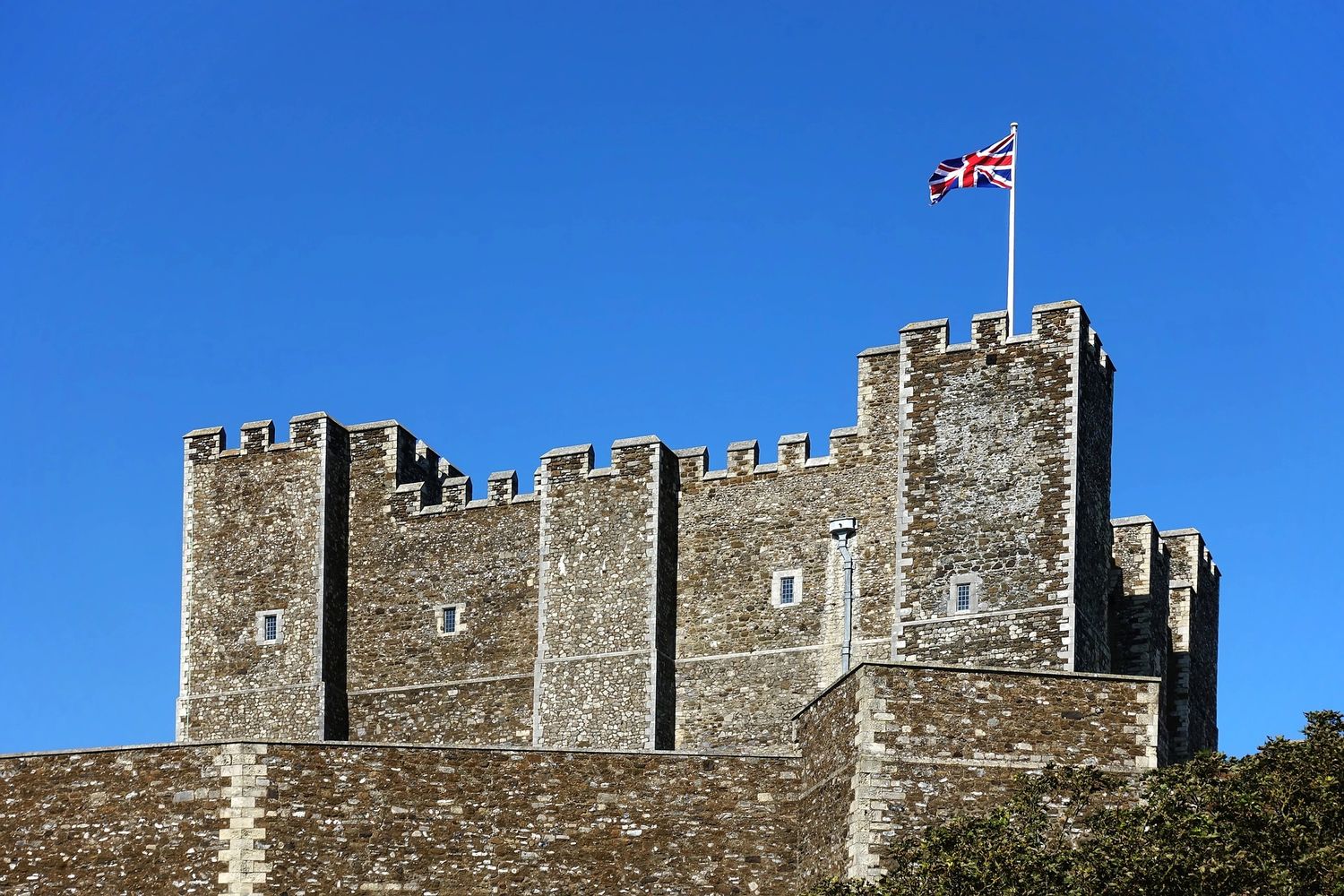

History tours of medieval castles and cathedrals
Reserve your spot today!

Historian, Dr Geoff, PhD Oxford, leads you on Single or Multi-Day historic tours of England.
All tours begin and conclude in London.
Take a private tour of Salisbury Cathedral, Canterbury Cathedral, The RAF Museum, Dover Castle, Hever Castle or even Highclere Castle - made famous by Downton Abbey.
multi-day tours
Expert guides, unique boutique hotels breakfast and dinners included.
Expert guides will lead you throughout your tours.
Tours are limited to a group of twelve so that we keep the personal touch for your needs.
Explore areas of outstanding natural beauty - what England is famous for in your private air conditioned chauffeured coach.
Join us at fabulous boutique hotels throughout England well off the beaten path.
Enjoy full English breakfasts and dining at our hotels (Marquis of Granby Hotel room pictured above) or great local pubs.
Experience! Live England's History
History & old pubs can life get any better.
We will bring you to exciting places where you can watch knights in jousting tournaments, watch a trebuchet (catapult) fire a projectile, learn about stone carving from master masons at Salisbury Cathedral, test your own skills in archery and hear the sounds of WW2 Spitfires and P51s overhead. On our tours you live English history!
We visit some of England's oldest and most famous pubs like, The Eagle in Cambridge, and Nottingham's Ye Olde Trip to Jerusalem built in 1189!
Castles & Cathedrals - 3 tours
Medieval castles, experience history.
We offer three Castles and Cathedrals tours, East, Cotswolds and South. The East tour heads from London to Kent where we visit the castles at Leeds 'the loveliest castle in the world', Hever (13th c. and home of Anne Boleyn) and Dover (11th c. origin and perhaps the most important castle in England's history.
The Cotswolds tour heads west visiting the castles at Thornbury (Henry VIII stayed here), Berkeley, and Oxford (both from and after 11th c.), and with time permitting we will also visit the Tower of London. The South tour visits impressive castles at Bodiam, and Arundel - the ancestral home of the Dukes of Norfolk.
On the Eastern tour we visit the cathedral at Canterbury, the most important church in England and the seat of the Archbishop of Canterbury. It is also the site of the brutal murder of St Tomas Becket in 1170. We also visit Westminster Abbey, England's most famous landmark, the burial places of famous Kings and Queens of England and others including Sir Isaac Newton, Stephen Hawking, and Charles Dickens. On the Cotswolds tour we see the cathedrals at Salisbury, Gloucester, Bath, and Oxford (within the grounds of Christ Church College). The Southern tour brings us to Chichester, Winchester, and Salisbury.
Our tours are not sit back and listen. Are you brave enough to get close up to a bird-of-prey, or walk Salisbury Cathedral's external parapet 75 feet up with its master masons? Or is descending into a medieval dungeon more your thing? Why not walk the ramparts of Medieval York then shop in its world famous Shambles followed by a classic English afternoon tea at Betty's. All of these are possible on our Castle and Cathedrals tours.
Great Ambiance
Pubs and great dining.
Our tours are limited to a small group of twelve. We believe that this allows us to really get to know one another on our tour and to share our love of history, great food, hotels and English pubs.
Fabulous Shopping
We will definitely have many shopping opportunities in all of the locations we visit. Highlights include Canterbury, Bath, and Oxford.
Have a pint where King Richard the Lionheart assembled his court in Nottingham. The first round is on us at
Ye Olde Trip to Jerusalem
that dates from 1189!
Learn more about our 2024
Castles and Cathedrals Tours
Wars of the roses - august 15-18, 2024
Richard iii, battlefields.
Villain or Noble King?
Did Richard murder the Princes in the Tower? Let us track the Wars of the Roses and maybe find answers to the Great Medieval Whodunnit
We visit the most important Wars of the Roses battlefield and museum at Bosworth Field. Here you can follow a guided walk on the battlefield and explore the weapons and armour used on the fateful day of August 22, 1485. The tour ends with the Bosworth Medieval Festival for an entire day at Bosworth Field. This is not to be missed!
Cathedrals, Abbeys and Churches
Our tours take you to some of the most important castles in the Wars of the Roses. We visit Warwick Castle, one of the best preserved castles in England and the home of Neville, Earl of Warwick a great baron in the Wars. We also visit castles at Berkeley, York and time permitting at Nottingham.
Our tours head to Tewkesbury Abbey which was the site of a battle inside the church! We also proceed to York, the heart of Richard III's powerbase. We visit York's cathedral, as well as the smaller churches where Robert Beauchamp, the Earl of Warwick is buried.
Incomparable York
York retains much of its medieval charm. The Shambles is its famous shopping area within yards of the cathedral. There is so much to see in this gem of Yorkshire. We will take a guided tour along the castle walls then stop for a traditional English afternoon tea at the famous Betty's.
Incredible Pubs
The pubs along this tour are exceptional. Starting with Ye Olde Starr Inne built in the early 1600s, The Abbot's Table in Tewkesbury, and The Old Coffee Tavern steps from Warwick Castle.
Wars of the Roses Tours
britain at war 1939-1945 - June 27- July 1, 2024
Ww2 air show - duxford.
Perhaps the highlight of the tour is the Duxford Air Show. The July aerial extravaganza is dedicated to The Americans. The 2022 exhibition showed many classic WW2 planes including the B17G, P51D, P47D, P40F and others. It is not to be missed and is always sold out.
Tanks in Action
No student of WW2 can miss the incredible Bovington Tank Museum. Its collection is second to none. Its WW2 collection includes, Tiger I, Tiger II, Jagd-Tiger as well as the M4 Sherman, M26 Pershing and Soviet tanks. The museum also has tanks of WW1 and the Cold War.
The Ultra Secret
Breaking Germany's codes, the Ultra Secret, played an enormous role in the victory over Nazi Germany. Alan Turing (played by Benedict Cumberbatch in The Imitation Game 2014) was central to this battle. We visit Bletchley Park and see where he and the famous Bletchley girls helped win the war.
Blenheim Palace
Winston Churchill held Britain together in its darkest hour. We visit the underground Churchill Cabinet War Rooms in London. See where he conducted the war 'safe' from the bombs and rockets fired in the Blitz.
We also visit one of England's treasures, Blenheim Palace. Built in 1705-22 it was the seat of the Dukes of Marlborough. The 1st Duke was John Churchill the victor of the Battle of Blenheim. His more famous descendant, Winston Churchill was born here in 1874.
D-Day Museum
The greatest amphibious invasion in history left the ports and airfields of England on June 6, 1944. We discover more about the invasion at the D-Day Museum in Portsmouth, a major port and embarkation point for the armada heading to Normandy. If time permits, we may also visit HMS Victory, Lord Nelson's 104 gun Ship-of-the-Line flagship at the Battle of Trafalgar 1805.
Britain at War Tours
important terms and conditions - full terms are on the link below
Deposits and Payment
- Multi-Day Tour Price is based on double occupancy of hotel rooms.
- Single travellers will be required to pay a supplement of 35% of the Tour Price.
- A Deposit of 10% of the value of the Multi-Day Tour Price or £50 per person on a Single Day Tour is required to confirm your reservation.
- The Deposit is refundable if a cancellation request is delivered and confirmed by return email at least 120 days prior to the Tour Date.
- The Deposit will not be refundable within 120 days of any Tour Date.
- The Balance of Payment is due 90 days prior to any Tour Date.
- Payment may be made via PayPal, or accepted credit card, to Historic Tours of England Limited.
Hotel and Room Availability
- All hotels and rooms selected are subject to availability.
- In the unlikely event that a chosen hotel(s) is not available, an alternate hotel(s) in a similar category will be substituted as required.
Special Food and/or Mobility Requirements
- Please let us know at the time of booking if you have mobility or dietary requirements.
- A modest surcharge may be required based on your particular needs, please see our Reservation Form for more details.
Join Our Mailing List
Special requests available.
For small group tours, we can customize an itinerary to emphasize your interests. If you have a special request, send us a message, and we will be sure to get back to you soon.
Historic Tours of England
Questions bookings.
This site is protected by reCAPTCHA and the Google Privacy Policy and Terms of Service apply.
Copyright © 2024 Historic Tours of England limited - All Rights Reserved.
Powered by GoDaddy
- Privacy Policy
- Terms and Conditions
This website uses cookies.
We use cookies to analyze website traffic and optimize your website experience. By accepting our use of cookies, your data will be aggregated with all other user data.
- Asia & India
- Europe & Türkiye
- Middle East
- Oceania & Easter Island
- The Americas
- Archived Trips
- Custom Trips
- Tour Scholars
- Guides & Blogs
- (415) 482-8400
- [email protected]
- Request Info
England’s Cathedrals, Abbeys, and Medieval Painted Churches
Adding item to wishlist requires an account, already a member.
Username or E-mail
Forget Password?
Don't have an account? Create one.
- July 20 – August 3, 2024
- $10,295.00 + air
- Single Supplement: $1495.00
Embark on a Cathedral Tour of England: Medieval Masterpieces from Durham to Canterbury
During the medieval era, England witnessed the establishment of nearly a thousand religious edifices, including abbeys, priories, cathedrals, and friaries. The grandeur of their architecture and embellishments symbolized the Church’s devotion and reverence to God. Even modest parish churches showcased splendid biblical scenes painted with great care.
Far Horizons presents a select group of 14 participants with a two-week journey through England’s rich medieval history. Our meticulously curated route unveils both renowned and secluded gems that house some of the finest art and architectural marvels from the Middle Ages.
The highlights include awe-inspiring cathedrals, remnants of ancient sanctuaries, and churches adorned with vivid, centuries-old biblical illustrations, which once aided priests in educating their largely illiterate congregation.
A Medieval Holiday in England: Tracing the Legacy of Faith and Artistry
Our guided tour of England commences at the illustrious Durham Cathedral, then winds its way through the ruins of Fountains Abbey and onto quaint village churches, each guarding its treasure trove of medieval art and architectural details.
Spanning from the northernmost regions, westwards to Bath, and then southeast to the historical Canterbury, our itinerary encompasses four UNESCO World Heritage Sites.
Guests will dine and rest in handpicked traditional pubs and inns to enjoy the historical ambiance.
Read the full itinerary below. If you have any questions, please get in touch .
(Browse our other historical tours of England with our Calendar of Trips. )
Guided Tour of England Led by:

Dr William R. Cook
State University of New York – Geneseo Department of History
Why Take this Medieval History Tour of England?
- Led by William R. Cook, medieval history specialist and lecturer for the Great Courses
- Experience Evensong at Oxford’s Christchurch
- Observe one of only four remaining Magna Cartas
- See Four UNESCO World Heritage Sites: The Cathedrals of Durham & Canterbury, the city of Bath and Fountains Abbey
- View rarely visited medieval frescoes in remote parish churches
- Limited to 14 participants
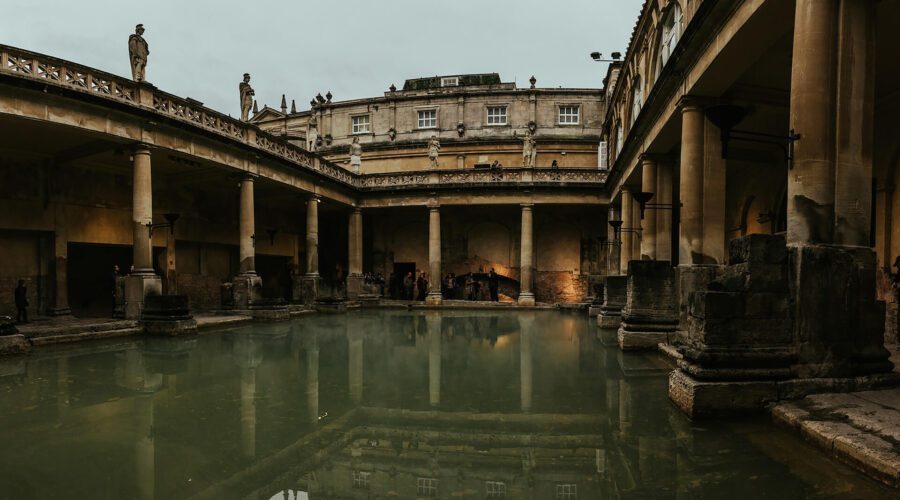
Guided Tour of England Itinerary
Day 1 depart for england.
Depart on an overnight flight to Newcastle, England.
Day 2 Arrive into Newcastle, Durham Cathedral
Arrive Newcastle upon Tyne Airport in the early morning. Then, drive to Durham where we will have our lunch. In the afternoon, enter monumental Durham Cathedral , regarded as one of the finest examples of Norman architecture in England and designated a UNESCO World Heritage Site along with nearby Durham Castle which faces it across Palace Green.
The cathedral was constructed between 1093 and 1133 to house the shrine of St. Cuthbert. This venerated preacher in the 7 th century was responsible for the spread of Christianity in the North of England. Durham Cathedral attests to the importance of the early Benedictine monastic community. It is the oldest surviving building with a stone vaulted ceiling of such a large scale.
We will enter the new Open Treasure Exhibit, located in previously hidden spaces within the Cathedral Cloister. Here, 2,000 years of history are on display.
Overnight at the Marriott Hotel in Durham, located within walking distance of the Cathedral. Gather this evening for our welcome dinner party. (L/D)
Day 3 Rievaulx Abbey, York Minster
This morning’s drive takes us to Rievaulx Abbey, the splendid remains of one of England’s most powerful Cistercian monasteries. We will learn about the monks who dwelled here in medieval times – how they devoted their lives to spiritual matters and at the same time established a thriving business to become one of the wealthiest monasteries in Britain. Our visit will include the abbey’s museum with displays of previously unseen artifacts.
Continue to York, one of England’s finest and most beautiful historic cities. Our destination is the Cathedral and Church of St Peter, better known as York Minster. The magnificent structure’s Gothic style is most notable for its distinctive pointed arches and its gorgeous ornamentation. This is England’s treasure house of stained glass, with a larger and more varied collection of windows than any other building in the country. The Great East Window is thought to be the largest area of stained glass in the world. The panels depict the beginning and end of the world according to the Book of Genesis, scenes from the Acts of Apostles and the Book of Revelations.
To the west of York Minster can be seen the ruined Benedictine abbey of St. Mary, once the richest religious house in England.
Overnight for three nights in the charming Dean Court Hotel, sited within three Victorian houses overlooking the Cathedral in York. (B/ /D)
Day 4 Whitby Abbey, Pickering and Barton-le-Street Churches
Our drive outside York takes us north to imposing Whitby Abbey, a 7 th century monastery that later became a Benedictine abbey. The building and its possessions were confiscated by the crown during the Dissolution of the Monasteries under Henry VIII. Perched high on a cliff, it’s easy to see why the haunting remains were inspiration for Bram Stoker’s tale of ‘Dracula’.
Heading back towards York, stop in the market town of Pickering to visit St. Peter and St. Paul’s Church. During the medieval period nearly all houses of worship were painted with scenes from the bible so that priests could use the images to teach to the mostly illiterate parishioners about the bible and aspects of morality. Inside this village parish church the compositions, created sometime between 1461 and 1483, cover the majority of the nave walls and depict scenes from the lives of the saints, the seven corporal acts of mercy, and the passion, death, and resurrection of Christ, together with the torments of the inferno.
Our final stop will be the village of Barton-le-Street and the Church of Michael & All Angels containing a treasure house of Norman sculpture, including some of the finest chancel arch capitals found anywhere in England. (B/L/D)
Day 5 Fountains Abbey, Studley Royal Park
A one hour drive takes us to Fountains Abbey , one of the largest and best preserved Cistercian monasteries in England. The religious complex was founded in 1132 by 13 Benedictine monks from St. Mary’s in York seeking to live a devout and simple lifestyle. A UNESCO World Heritage Site, the remains of the abbey are enclosed within the 18 th -century landscape of Studley Royal Park. There will be time to walk through the water garden here that was created in 1718 and is one of the best surviving examples of a Georgian water garden in England.
Return to York with the afternoon and dinner on our own. This evening we may want to hear the choral singing at York Minster. (B/L)
Day 6 Lincoln Cathedral, Brant Broughton and Corby Glen Churches
Lincoln Cathedral dates from 1072 when William the Conqueror instructed that the bishopric of this, then the largest diocese in England, be moved from Dorchester, near Oxford, to Lincoln. In spite of its size, the sanctuary is filled with intricate details and is one of the high points of Gothic architecture. The nave is awe-inspiring, with slender pillars of Purbeck marble rising up to the painted ceiling high above. Two glorious rose windows light the transept. The earliest is the Dean’s Eye window, dating from 1220, still with much of its original medieval glass depicting the Last Judgment.
As we continue south, stop in Brant Broughton to see the small Church of St. Helen covered with attractive carved decoration, both on the exterior and interior of the building. Time permitting, continue to Corby Glen to enter St. John’s Church. The earliest part of the church, the north aisle, dates from the late 13 th century. It is celebrated for its medieval wall paintings covering the interior. These fascinating illustrations were discovered, buried under layers of plaster and whitewash, by a churchwarden when redecorating the church in 1939. The images include a Tree of Jesse, a depiction of the ancestors of Christ, shown in a tree which rises from Jesse of Bethlehem, the father of King David.
Continue to Peterborough and overnight for two nights in The Bull, originally dating back to the 17 th century and a 5-minute walk from Peterborough Cathedral. Dinner will be in one of Peterborough’s finest restaurants, a short walk from the hotel. (B/ /D)
Day 7 Peterborough Cathedral, Longthorpe Tower, St. Kyneburgha’s Church
Begin in Peterborough Cathedral, one of the most intact Norman buildings in England. It is renowned for its imposing early English Gothic West Front which, with its three enormous arches, is without architectural precedent. Nearby Longthorpe Tower, built around 1300, is a rare surviving medieval tower house. The Great Chamber on the first floor was the family’s private living and sleeping quarters. The walls of this room are adorned with some of the finest and most complete examples of medieval domestic art in northern Europe. The religious and mythical depictions offer an intriguing insight into the mind of the Middle Ages and demonstrate the often blurred line dividing the sacred and secular during this period.
We move on to the tiny village of Castor, dominated by St. Kyneburgha’s Church. One of the finest Norman churches in England, St. Kyneburgha’s is filled with spectacular treasures. An 8 th -century carving of St Mark was found under the altar rails when they were removed and is said to be from the original shrine of St. Kyneburgha. A fragment of an Anglo-Saxon cross is displayed in the north aisle that is believed to be a re-used Roman pagan altar. And each of the round Norman arches has wonderfully-carved capitals. Dinner is on our own tonight. (B/L)
Day 8 Ely Cathedral, Beckley Church
After a morning and lunch on our own, we drive to Ely Cathedral, one of the marvels of the medieval world and the only UK building to be listed as one of the “Seven Wonders of the Middle Ages”. The present structure dates from 1081 and is a remarkable example of both Romanesque and Norman architecture. The famous Lantern which towers 70 feet over the center of the church is truly a masterpiece of engineering.
Continue on to Oxford and overnight for two nights in the Mercure Eastgate Hotel, located in the heart of the University of Oxford. (B/ /D)
Day 9 Oxford, St. James the Great Church
Oxford is a gorgeous city of captivating architecture, history and culture, and Oxford University, in existence for 1000 years, is the oldest institution of higher education in the English-speaking world. Today we will enjoy tours of several of the university buildings.
Christchurch Cathedral is the smallest cathedral in England and the seat of the Bishop of Oxford. This medieval structure contains the Shrine of St. Frideswide, Oxford’s patron saint. Frideswide hid in a tree to escape from the pursuit of a king and a worldly life. Search among the arches in the shrine to see her face peering from the vegetation.
Attached to the Bodleian Library, one of the oldest in Europe, the Divinity School was constructed in the 15th century as a school of theology. Although no longer used for that purpose, it was used as the Hogwart’s Hospital in Harry Potter and the Prisoner of Azkaban. The Late Gothic Ceiling, designed by William Orchard in the 1480s, consists of very elaborate lierne vaulting with bosses. Despite its name, New College is one of the oldest of the Oxford colleges, and is renowned for its grand interior and superb medieval stained glass.
In the early evening, enjoy an optional return to the university for the Evensong at Christ Church Cathedral. (B/ /D)
Day 10 Wells Cathedral
Depart Oxford and meander through the stunning landscape of the Mendip foothills into the Somerset District to reach Wells, England’s smallest city. Famed for its medieval architecture, Wells is home to a magnificent cathedral, the earliest English cathedral to be built in the Gothic style, and the nearby Bishop’s Palace, home to the Bishops of Bath and Wells for over 800 years.
The Cathedral Church of Saint Andrew, commonly known as Wells Cathedral, was erected between the 12th and 15th centuries, and is dedicated to St Andrew the Apostle. The stunning West Front is decorated with 500 sculptures of kings, saints, and bishops that were originally decorated with red and green paint. . The interior is an elegant example of Early English Gothic and contains three scissor arches that were added in 1338 to support the central tower. The medieval art inside includes the Jesse Window that contains the family tree of Christ in stained glass and an astronomical clock made in 1390 with jousting knights that charge outside their castle four times an hour.
In the afternoon, we will walk through the portcullis and cross the drawbridge spanning the moat (with resplendent swans who ring a bell for food), to enter the picturesque Bishop’s Palace. Within the fortified Palace walls are found the remains of the Great Hall, the Bishop’s private chapel and 14 acres of gardens.
Overnight for one night at the historic Crown Hotel in Wells, located just steps from the cathedral. (B/L/D)
Day 11 Bath, Holy Trinity Church
Begin today with a drive to picturesque Bath, a UNESCO World Heritage Site. Here we will explore Bath Abbey, a parish church of the Church of England and former Benedictine monastery. Founded in the 7th century, it was reorganized in the 10th century and rebuilt in the 12th and 16th centuries. It is one of the largest examples of Perpendicular Gothic architecture in England.
We continue to Bradford on Avon, a charming town with one of the best-preserved Anglo-Saxon parish churches. Major work was carried out in 1864 to “restore” the internal appearance to suit Victorian taste. This resulted in stripping out many Georgian features, including the box pews, galleries, wooden pulpit and plaster ceiling.
In the late afternoon, drive to Salisbury and overnight for two nights at the Mercure Salisbury White Hart Hotel. (B/L/D)
Day 12 St. Thomas Becket Church, Salisbury Cathedral
Begin the day in St. Thomas Becket Church, where a 15th century mural of the Last Judgment dominates the chancel arch.
Then it’s on to Salisbury Cathedral, the finest example of Early English architecture in the country. Built almost entirely in the 13th century, the final structure boasts the tallest spire and the largest cloisters in England. Salisbury Cathedral owns one of only four surviving copies of Magna Carta, signed in 1215. Sunlight filtering through the windows of the cathedral’s Chapter House, where the Magna Carta is displayed, will add a mythical touch when looking at the beautifully rendered Latin text written on the aged parchment. Walk up 332 steps to the tallest spire in England on a specially arranged tour. Enjoy unimpeded views of the spectacular Nave from above and admire the West Window at close quarters while we learn how this architectural masterpiece was constructed. (B/ /D)
Day 13 Winchester Cathedral
The historic city of Winchester and its awe-inspiring Cathedral, the longest medieval cathedral in Britain, is our destination today. Dating from 1079, it was built in the Norman Romanesque style with the towering Perpendicular Gothic nave the focal point. But equally impressive are the reredos, ornamental wooden screens behind the altar, and the carved choir stalls embellished with plants, animals, dragons.
We will walk to The Chesil Rectory for a special lunch. Dating back to 1450, this beautifully preserved city landmark has been stylishly refurbished and retains solid oak beams, ancient doorways and beautiful open fireplaces.
After lunch, continue to London and overnight for two nights at the Radisson Blu Edwardian London Heathrow. Dinner is on our own tonight. (B/L)
Day 14 Canterbury Cathedral
Today’s all-day excursion takes us into southeastern England to Canterbury, a site of pilgrimage during the Middle Ages. Fortification walls, originally built by the Romans, encircle the city’s medieval center and its picturesque cobblestone streets and timber-framed houses.
Canterbury Cathedral has been the primary ecclesiastical center of England since the early 7 th century. The seat of the spiritual head of the Church of England for nearly five centuries, this UNESCO World Heritage Site is a stunning blend of Romanesque and Gothic architecture. It became a pilgrimage site with the martyrdom of St. Thomas Becket in 1170 and the glorious stained glass windows in the Cathedral depict miracles performed by the saint.
We will have lunch in one of Canterbury’s fine bistros before we return to the Radisson Blu Edwardian London Heathrow. Gather this evening for our final dinner party. (B/L/D)
Day 15 Depart England
Transfer to the airport for our flights back home. (B)
Tour Information
Tour cost & inclusions.
Price is based on double occupancy and includes:
- Internal flights during the trip (if applicable)
- The accompaniment of your scholar throughout the entire trip
- Local English-speaking guide
- Hotel accommodations (3 or 4 stars; or best available based in the area)
- Ground transportation
- Airport transfers for arrivals and departures
- Most meals as noted in the itinerary
- Entry fees to all included sites and museums
- Gratuities to guides, drivers, and restaurant and hotel staff
- Coordination for any private presentations or tours
Trip prices are based on a minimum number of participants. If this minimum number is not met, trip prices are subject to change. Should the prices need to change, Far Horizons will reach out to registered guests to discuss directly.
Single Supplement
Should a roommate be requested and one not be available, the single supplement must be charged.
- International round trip airfare
- A separate donation check of $150.00 per person to a designated donation project
- Passport or visa fees
- Required vaccines or tests
- Airport or departure taxes
- Alcoholic drinks, beverages or food not included on set menus
- Excess baggage charges
- Personal tips and hotel incidental expenses
- Laundry or other items of a personal nature
Donation Checks
As a tour company that benefits from the cultural and natural riches of our destinations, we have a policy of donating to the scientific and cultural sites and projects which we visit. This has created a bond between Far Horizons and the academic and local communities that has helped us establish an extensive list of lecturers and contacts in each of our destinations. We ask that each participant donate to the noteworthy project we designate. The donation amount is $150.00 per person. Note that the donation is required as part of your registration for the trip and that it is non-refundable.
Exchange Rate Fluctuations
Prices are based on currency exchange rates keeping below a projected level. While it is unlikely, if the exchange rates should change substantially, Far Horizons reserves the right to charge an additional amount to the trip cost.
Registration
A deposit of $1000 per person is required along with your registration & health forms, which will be linked in the email confirmation you receive once you pay your deposit on our booking platform. Final payment is due 120 days before departure. Prior to departure, you will be sent a reading list and a tour bulletin containing travel information.
Cancellation
Cancellations received in writing at least 120 days before departure will receive a refund less a $500 per person administrative fee. Cancellations received less than 120 days before the departure date will not receive a refund. If for any reason you are unable to complete the trip, Far Horizons will not reimburse any fees. Upon registering for the tour, the purchase of travel protection with both trip cancellation and emergency evacuation is strongly advised. Links to recommended insurance policies will be included in the email you receive confirming receipt of your deposit.
Air Ticketing
International round trip flights are not included in the cost of the trip. If Far Horizons must change the trip dates or cancel the trip for any reason, Far Horizons is not responsible for any air ticket you may have purchased. Please send your complete air schedule as soon as you have it. NOTE: Please contact Far Horizons if you would like for us to handle your air ticketing.
Private Tours and Talks
The private tours of archaeological sites and talks by specialists are scheduled in advance and include a donation to each. Specialists working at these sites are excited about showing their work to interested enthusiasts. However, please be aware that there may be times when the director or a member of the staff may not be on site when our groups arrive due to other commitments.
Walking and Standing
Far Horizons expects all participants to be physically active and able to walk and climb independently throughout the full touring days. This includes walking over uneven terrain (uphill and downhill) for 2 miles or more at each site. You should expect to be on your feet for much of each day, averaging as much as 5 miles of walking per day. As such, each participant should be able to walk unaided at a pace of 3 miles per hour for at least an hour at a time, and to stand unsupported for at least 60 minutes. Bearing this in mind, we suggest that, if you have not already done so, you begin walking several miles every day, ideally including stairs and hills. If you have questions about your ability to keep up with the group or the strenuous nature of this trip, please contact the Far Horizons staff.
Expectations During Travel
This tour is designed for flexible, energetic people who like to be active, have a spirit of adventure and a positive attitude. We have designed this trip to be as comfortable as possible, while also aiming to visit some remote or unique sites that other companies do not attempt to include in their itineraries. There may be days where we have very long drives and the conditions of the roads may vary. Hotels and transportation in some remote areas may not be up to western standards. There may be times when no bellhops are available; please pack with the understanding that you need to be able to handle your own luggage at times. Sometimes we may be walking over uneven trails for a mile or more; hiking boots are strongly recommended. Not every meal will be haute cuisine and several lunches may be picnics or box lunches. By maintaining a flexible attitude we will soon be captivated by the beauty of the natural scenery, the hospitality of the local people, and the fascinating sites we will see. Your flexibility and patience will be appreciated.
Itinerary Changes
Changes in our itinerary, accommodations, and transportation schedules may occur. While we are committed to keeping as close to the published details as possible, sometimes it is simply not possible. Weather events, government affairs, or other factors out of our control sometimes come into play. A good book to read as well as patience, flexible attitude, and a sense of humor are essential.
Travel Insurance
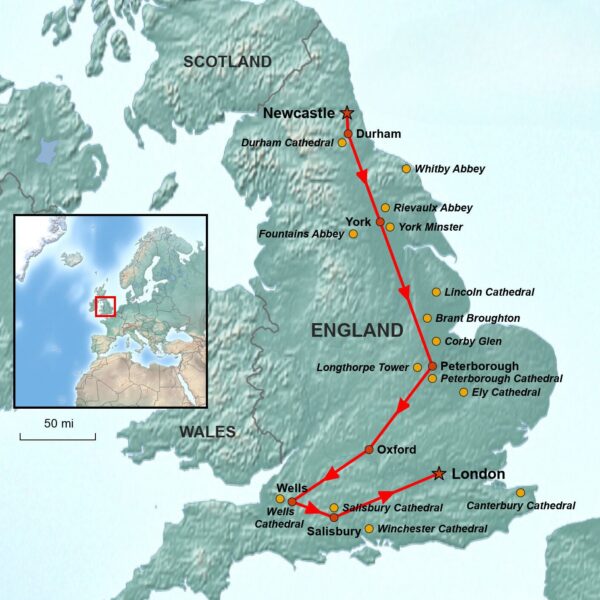
Related Tours

The Archaeology of Greece Tour

Italy’s Tuscany & Umbria: Art & Architecture Tour
- Best Tours from London >
Best English Castle Tours
Our pick of the best English castle tours. From working royal residences at Windsor Castle to moated castles at Leeds Castle and medieval fortresses at Warwick Castle see the best of England’s heritage! Many of these tours operate daily from London, whilst some are only available on selected dates. We also offer private English castle tours, visiting lesser-known gems such as Arundel Castle and Hever Castle.
Windsor Castle Tour from London
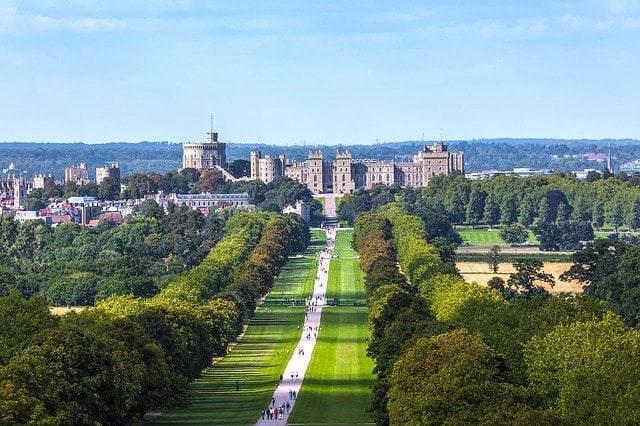
This day tour from London takes you to the best of England’s royal highlights! Windsor Castle is the oldest continuously inhabited castle in the world that is one of the King’s official residences. You’ll see the spectacular state apartments, palatial rooms, castle grounds and St George’s Chapel. The castle is rich in English history, built-in 11th Century after the Norman invasion of England by William the Conqueror.
Choose a half-day tour that spends the morning at Windsor Castle, or visit the castle as part of a full-day tour which combines a visit with other nearby English sites, including the town of Bath or the UNESCO World Heritage Site of Stonehenge. During the summer, there is also a tour that includes a visit to the State Rooms of Buckingham Palace. The rooms are used for receiving guests and for official functions. Highlights include the Throne Room, Grand Staircase and extraordinary works of fine art.
Availability: Daily
More info: See all Windsor Castle tours
Leeds Castle Tour from London
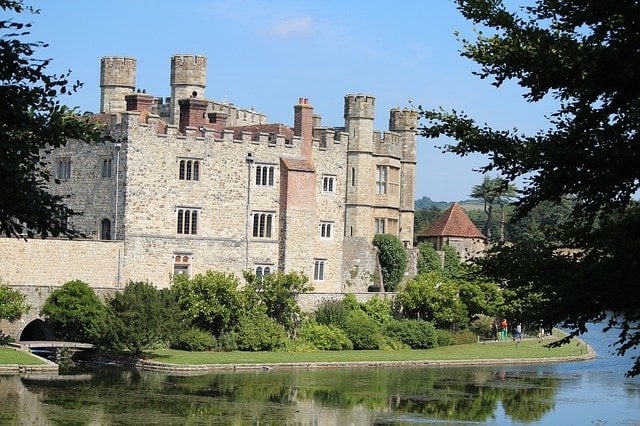
Also includes a visit to Canterbury & White Cliffs of Dover
Leeds Castle dates back over 900 years and is one of the most beautiful castles in the world! It features in the Doomsday Book and whilst it might look like an ancient castle, much of it is only 200 years old. King Henry VIII was one notable resident who turned it into a home for his first wife, Catherine of Aragon. Highlights include the interior rooms and spectacular gardens, including a maze garden. After touring the English castle, you’ll also visit Canterbury Cathedral, a UNESCO World Heritage site. Finally, take in the view of the White Cliffs of Dover on England’s south coast.
Availability: Every Day
More info: See here
Warwick Castle Tour from London
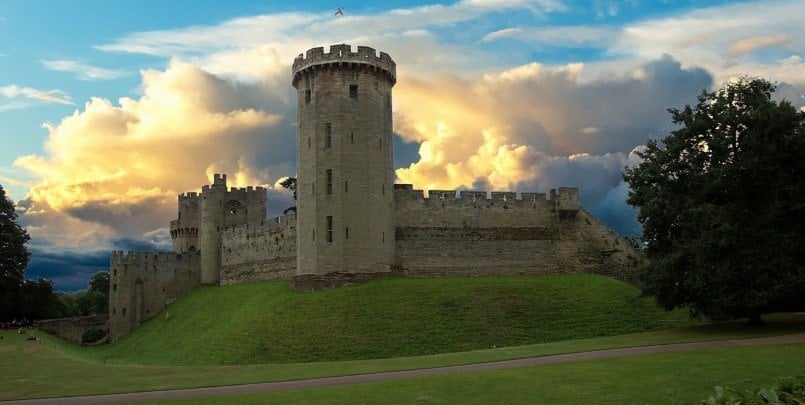
Also includes a visit to Stratford-upon-Avon and Oxford
Warwick Castle dates back over 1,100 years and is one of the great English medieval castles. A castle first appeared here two years after William the Conqueror invaded England in order to consolidate his power. Visitors can see the dungeon, armoury and the worlds biggest siege machine. The castle is particularly geared towards families, with lots of activities for kids. The tour also includes a visit to Stratford-upon-Avon which is the hometown of William Shakespeare, as well as a visit to the university town of Oxford.
Availability: Every day
Dover Castle Tour from London
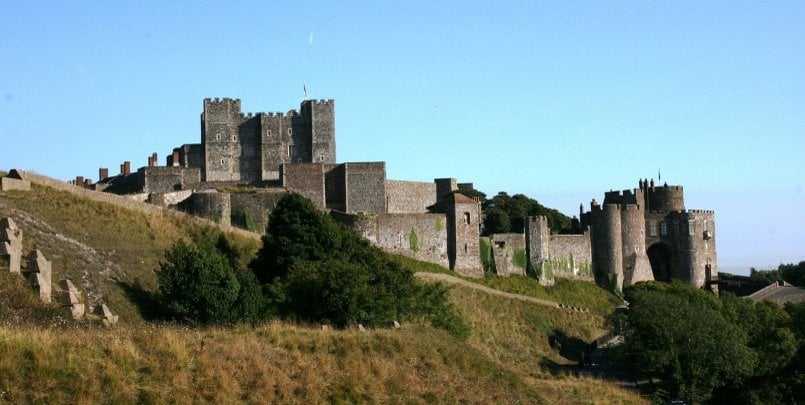
Also includes a visit to Canterbury, Rochester & Kent as well
Dover Castle has played an important part in English heritage and is perhaps the most iconic English fortress that sits on the southern coast. The castle has been the site of battles spanning from the 11th Century to WWII and highlights of a visit include the tower, walls and command posts. Known as the ‘key to England’ Dover Castle has played an important role in defending the country for over nine centuries! This English castle tour also includes a visit to Canterbury Cathedral and the towns and villages of Kent.
Availability: Tuesdays and Fridays from April to October
Windsor Castle & Hampton Court Tour from London
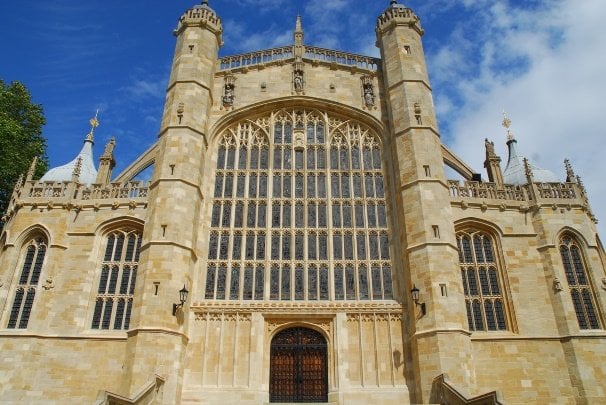
Available every Monday, Wednesday & Saturday from May to September
Combine a visit to Windsor Castle with a tour of Hampton Court Palace. See the spectacular English castle at Windsor, one of the most famous royal castles in the world and an important part of British history. The afternoon is spent at Hampton Court Palace which was built in the Tudor and Baroque styles. King George II was the last monarch to reside in the Palace, and highlights include the Royal Gardens and Maze, as well as State Rooms and Apartments.
English Castle Private Tours from London
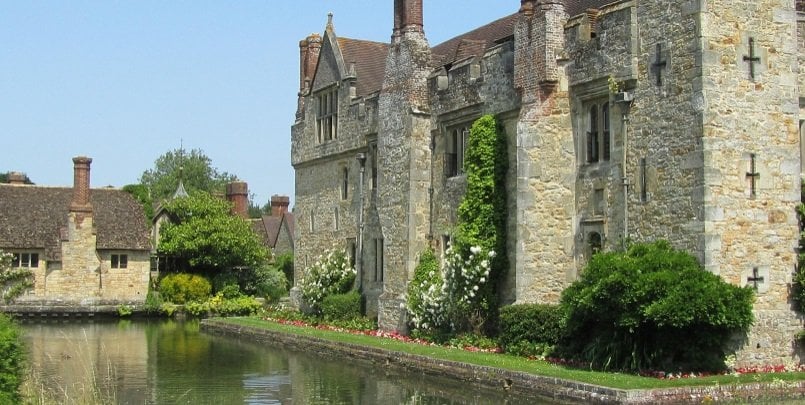
Visit some of the more off-the-beaten-track English castles on a day tour from London. Arundel Castle dates back to the 11th Century and has been in the ownership of the family of the Duke of Norfolk for over 400 years. Another stunning English castle is found at Hever Castle . This double moated 13th Century castle was the childhood home of Anne Boleyn, second wife of King Henry VIII. Also visit Scotney Castle, a 14th Century moated castle located in a wooded estate.
All our private tours include pickup and dropoff from your hotel in London and the services of a driver/guide for the day. You can choose from a variety of different vehicle sizes and specifications.
Overnight English Castle Tours
Take an overnight English castle tour from London to discover some of the fantastic medieval fortresses in the region. The private tour includes a 1-night stay in Amberley Castle , a unique opportunity to stay the night in a 900-year old English castle! The tour includes a visit to two of England’s most historic castles, Hever Castle & Windsor Castle. You will also visit Hampton Court Palace, as well as Chartwell, the private home of Winston Churchill.
This private overnight English Castle tour includes a tour guide, entrance fees and accommodation. It is available throughout the year, led by a tour guide who is an expert in English history. Guides are available in a number of different languages.
More details: Contact Us
About English Castles
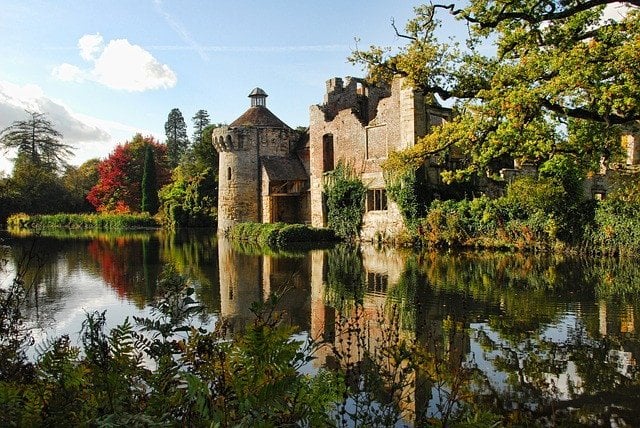
English Castles began to appear after the invasion of William the Conqueror in 1066 and were used as a means by the Normans to consolidate control over the country. Early English Castles tended to be built in the motte-and-bailey form, whilst a few important castles were built in stone. Up until the 13th Century, lots of castles continued to be built, until the decline of feudalism. In the later medieval period, the role of castles as fortresses declined, and instead, they increasingly became used as residencies.
Windsor Castle
Windsor Castle is one of the most popular sites to visit in England. It is associated with the English and later British Royal family and was the preferred weekend home of Queen Elizabeth II. The original castle was built after the invasion of William the Conqueror, and since King Henry I has been the longest-occupied castle in Europe. Windsor Castle underwent moderations and extensions under the reign of many different English kings and queens and survived conflicts, especially the English civil war. Major styles that are found in the castle include Baroque, Rococo and Gothic. In 2018, millions of people worldwide tuned in to watch the wedding of Prince Harry and Meghan Markle that took place at St George’s Chapel in Windsor Castle.
Dover Castle
Dover Castle is one of the most iconic English fortresses. The castle sits at the shortest sea crossing point between England and the European continent. This has made it of great strategic importance over the years. The building of the current castle first began way back in the 12th Century by King Henry II and has since undergone many changes. The defences at Dover Castle were continually upgraded to meet the ever-changing threats, including a network of tunnels dug in response to the threat of invasion by Napoleonic France. During WWII, these tunnels were used as the command centre that controlled naval operation in the English channel.
more things to do

The Ultimate Guide to Exploring London on a Hop-On Hop-Off Bus

Musicals in London 2024

25 Things to do in London
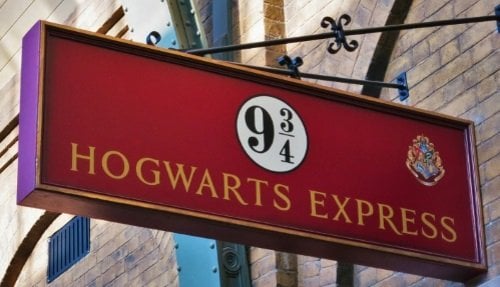
Get Tickets to Harry Potter Studio Tour If Sold Out
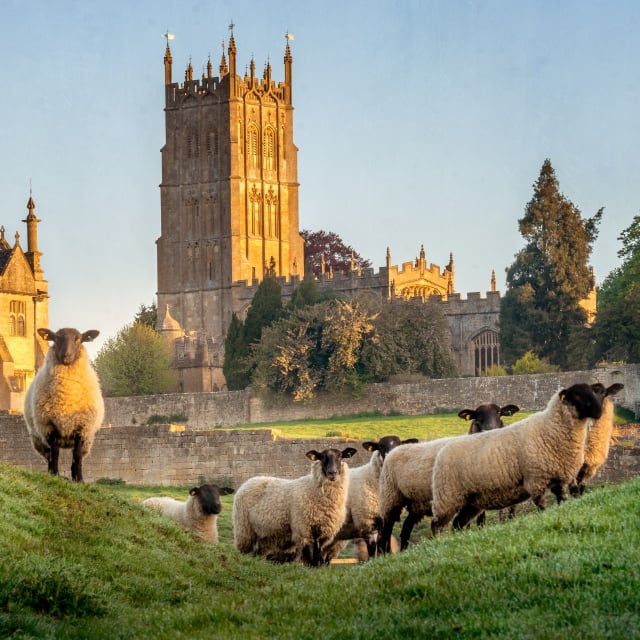
England Vacation Packages 6-Days and More
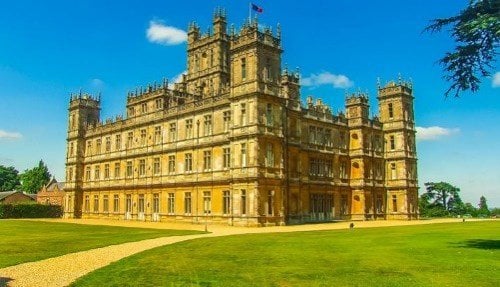
Highclere Castle Opening Dates 2024
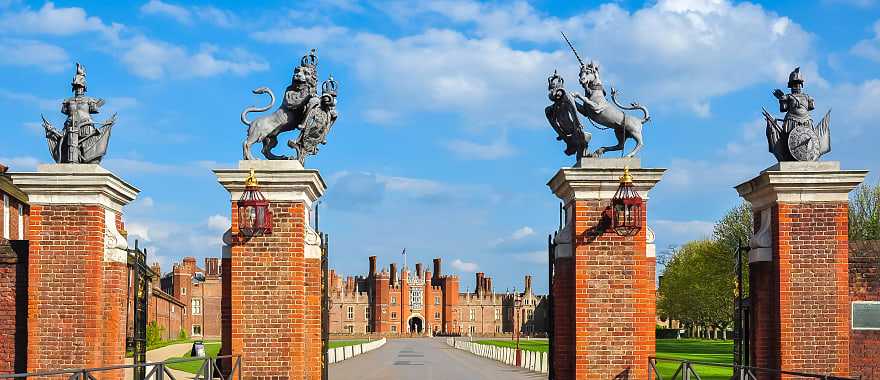
Historic Castles of England and Scotland Tour: Discover & Stay
Customers rate Zicasso's travel referral service 5 on a scale of 1 to 5 based on 1541 reviews on Trustpilot
We match you with top tour companies that specialize in the trip you want, whether it's a customized private tour or a group tour.
- Trip Overview
This is a sample itinerary to inspire a personalized trip designed with your travel specialist
Request a Quote
Countries Visited
Places visited, suggested duration, customizable itinerary, amberley castle – welcome to royal rural england.
Amberley Castle is hidden away, 900 years of history surrounded by landscaped gardens and unrivaled tranquility. Enter into its medieval walls and there's an immediate sense of decadence. Welcome to a world of elaborate four-poster beds, opulent gardens, 60-ft high ceilings, and the untamed excess of England's regal past. And this is just the first of your six castle stays. There's plenty more to experience over these nine days. You'll be picked up at the airport by your private transfer and transferred out to West Sussex, and this delightful castle amongst green pastures. A spa bathroom helps alleviate any travel aches, and there are two sumptuous restaurants to choose from. Settle into the grandeur, explore the grounds and enjoy your first taste of England's castles. Consider reading some of our traveler reviews of England , and see how you can further refine and perfect your own itinerary.
What's Included:
Thornbury Castle – Regal Windsor and Hampton Court Palace
Birds tweet a good morning as a royal breakfast is served; picture tea in china teapots and multiple courses to enjoy. Today's drive towards Thornbury takes you past two iconic English landmarks. Windsor Castle is almost big enough to be a city. Ginormous turreted walls dominate the landscape, rising with an air of indomitability that comes from having never being conquered. Guards change, cannons fire, and you wander into the residence of Her Majesty the Queen. London's Buckingham Palace is her working residence while Windsor Castle is her official home. Wander through the stately rooms, basking in the luxuriant style you'd associated with the monarchy. Corridors are lined with world-famous paintings, sofas are lined with gold leaf, and carpets feel thick and cozy beneath your feet. This is the world's oldest continually inhabited castle and the world's largest inhabited castle, so expect to be inspired by scale and grandeur.
After lunch along Eton High Street, you weave onto the edge of London and explore the flamboyance of England's most famous king. Henry VIII went through six wives in search of a son, beheading two of them and splitting from the church so that he could divorce another two. Hampton Court Palace is liberally decorated in his ostentatious style, and the rooms filled with bizarre luxury and unusual art. You're not sure whether to be impressed or jest at the excess. Either way, Hampton Court Palace is undoubtedly enthralling.
Thornbury Castle – Exploring Bath and the West Country
Thornbury Castle continues the King Henry VIII theme. This was where he would visit with his second wife, Anne Boleyn before he had her beheaded on charges of incest and witchcraft. Arrow loops and ornate carved ceiling stand above the Coat of Arms while the English flag flies proudly from the towering summit. Take breakfast onto the manicured lawn and admire the ivy that creeps along the walls. Built in the 16th century, Thornbury Castle introduces you to a more modern castle style, one that reflects a certain paranoia around invading pirates and civil rebellion. Despite the relatively small size, the main entrance is almost spookily domineering. But once inside the walls, you find that the old-world charm of England's past.
You have the whole day today to loop around the iconic attractions of the West Country. Bathe in the Neolithic splendor of Stonehenge, the mysterious blocks of stone that stand on remote countryside fields. Spend a couple of hours in the spa town of Bath, a UNESCO World Heritage Site that unravels an architectural history from 1st-century Rome to 18th-century Georgian townhouses. Nearby Wells Cathedral appears to be almost toppling over; history radiates through its interior, and it's a site that's rarely visited by tourists. Throughout today's journey, there's always another postcard angle of rural England; this sleepy area maintains the serenity of a distant era.
Coombe Abbey – 12th-Century Wonder Besides the Cotswolds
As you head north, you journey through the centuries. Stratford-upon-Avon seems stuck in the 17th century, the birthplace of Shakespeare filled with thatched roofs and cute cobbled streets. Quiet country lanes weave through villages frozen in time, including one where livestock still grace its square. Like every day on this luxury tour, the daily itinerary is mostly dictated by you. Your guide will outline different places that can be visited on the route and you decide which are of pertinent interest to you. On this itinerary, you wind through an iconic route north to south through England, so you'll pass by most of its stand-out attractions. So choose to spend the day in the Cotswolds or move a little quicker to Coombe Abbey.
Now you're in the 12th century, wandering through the landscaped grounds that were originally the home to Cistercian monks. But King Henry VIII wasn't too fond of that. He removed the monks and the Abbey became an illustrious royal residence, until it was commandeered and integrally involved in the Gunpowder Plot – if you've ever celebrated Guy Fawkes, (or Bonfire Night as it's sometimes known) then its origins date from the 17th-century date when plotters tried to blow up the King while he sat in parliament. Nestled in the heartland of Warwickshire, Coombe Abbey combines its captivating history with lavish formal gardens, a tranquil lake, and stunning fine dining.
Swinton Park Castle – York Minster and the Yorkshire Dales
The Yorkshire Dales resemble an oil painting, colors blurring with brushstrokes and an intricate depth flowing across the canvas. Green hills rise and fall, demarcated by dry stone walls and the speckles of sheep. The vast Swinton Park Castle grounds spreads out across this blissful landscape, with much of the estate left to blend into a redolent sense of wilderness. You'll still find the manicured gardens, swan-filled lakes, and rousing forests surrounding the castle. But the estate is practically the size of a province, so there's lots of space to amble into nature. Horse riding and shooting excursions within the grounds are specialties of Swinton Park Castle.
Your journey north takes you into Yorkshire and the charms of York. Roman remnants are scattered across the city while the towering York Minster is Northern Europe's second largest gothic cathedral. Explore the city on foot and you walk through tiny alleyways, each decorated with cozy tea rooms and boutique indulgence. Then it's into the Yorkshire Dales and the oil painting. Small villages are dominated by faded stone; market life continues as it has done for centuries, and there are very few other vehicles on the road. There are dozens of potential villages where you can stop and explore; your guide will offer the options for today's drive. You might want to continue straight to Swinton Park for a gallop through the Dales.
Langley Castle Hotel – Medieval Musing in Northumberland
In Southern England, the landscapes are mostly flat and cultivated. Ever since William the Conquerer united the country in the 11th century, the leveled south has been England's bread basket. Nothing is flat in the north, and the undulating hills are mostly wild, especially if a flock of sheep hasn't been grazing there for a while. Today's journey into Northumberland unveils a strong sense of wilderness; villages pass by at decreased frequency, roads slowly narrow, and every mile brings a dozen turns. For a scenic drive, this is England at its finest.
Hidden in a Northumberland valley is Langley Castle, a 14th-century fort that resembles how a young child would draw a castle; think square blocks, iconic turrets, and a style designed to ward off invaders. It doesn't look like the kind of place you'd visit without an invitation. Architecturally, the building has remained since the year 1350, without any of the luxurious additions found at many of England's other castles. It's easily one of England's finest medieval castles, yet the interior has been expertly revamped to provide contemporary luxury within the fortified shell. Like each castle you stay in, expect service and room quality that befits a royal past.
Melville Castle – Hadrian's Wall and Rural Scotland
Winding further north, you cross the great divide. Let's clarify; Hadrian's Wall isn't the Wall of China. Most of the wall is easily low enough to climb over, and you could even step over some sections. But Hadrian's Wall represents a distinguished piece of world history. This was the very northern boundary of the Roman Empire, the line they drew to stop the barbarians from the north. Your guide takes you to various stops along the wall, providing the chance to dispel the myths of this great wall and narrate its 2000-year history. Then you cross, heading into Scotland and roving through a stretch of tumbling countryside.
Situated on the edge of Edinburgh, Melville Castle imbues a real country estate feel. It looks warm and inviting, surrounded by lavish woodland and reflecting a setting for royal parties rather than royal defense. Charming rooms and an iconic lounge make this the final piece in the jigsaw of castles. Melville is a place for entertaining, complete with cellar bar, broad gardens, and ample space to reflect on your journey so far. Spend the evening at the castle or your driver guide can take you into Edinburgh itself for dinner.
Melville Castle – Discovering Edinburgh and its Sublime Castle
Edinburgh Castle dominates from afar, even when the skies are gray, or the city's mist is rolling in. Dominating the city with its ode to grandeur, the castle is Scotland's unmissable highlight, a gargantuan expanse of fortified walls, stately rooms, and history. From here you walk, taking the Royal Mile between the castle and the Queen's Scottish residence. First head downhill, running along its boutique collection of pubs and antique stores. Dip into a maze of atmospheric side streets, each emitting the scent of classic Scotland. Keep walking – it's only about a mile in length, but it can take hours given how much there is to look at. Now the Palace of Holyroodhouse, an expanse of fabulous state rooms that marks the final stop on this itinerary. Bathe in the glory of the monarch's tastes and complete the journey from Windsor to Scotland. A farewell dinner with your guide at Melville Castle completes the day.
Edinburgh – Departure
Enjoy a final regal breakfast in the castle before the short transfer to Edinburgh's large international airport. Say goodbye to your driver guide and leave the big island behind, hundreds of unique memories accompanying the flight home.
Trip Highlights
- Spend the night in six different castles, each an ode to England's regal history and a wonderfully luxurious snapshot of yesteryear
- Travel from London to Edinburgh with a private driver guide, stopping off at various sublime historical attractions, like Stonehenge, Hadrian's Wall, and Bath
- Enjoy intimate visits to Britain's royal residences, including Windsor Castle, Hampton Court Palace, Edinburgh Castle, and the Palace of Holyroodhouse
- Bask in the stunning countryside locations of your castle hotels, with stops in the Yorkshire Dales, Northumberland, and the West Country
- Savor a style fit for monarchs with exquisite dining in each of the castles
- Connect the architectural dots as each castle has been handpicked to reflect the style of a different era
Detailed Description
The English landscape is liberally dotted with castles. The timeless structures revel in their old grandeur, with the faded stone and stately rooms revealing many centuries of history. Each is sublimely situated, standing alone amidst the glorious colors of the English countryside. They're national treasures. And they're not just for sightseeing. With this England castles tour, you don't merely walk around and explore ancient castles; you spend the night. Wander through the ornate hallways, open the door to an elaborate four-poster bed, and delight in the sense of regal splendor.
Over nine days, you enjoy six different castles; each showcases another architectural era and new narratives on England's royal past. There is an excess of 12th-century medieval charm, ancestral homes of earls and bishops, and fortified 14th-century estates hidden behind curtains of oak trees. Staying in these timeless castles enables you to recreate history, not just glimpse it on a day trip. In most of them, you're amongst a small handful of guests enjoying exclusive access to the vast landscaped grounds and magisterial interiors. These aren't places for the paying public. They're intimate destinations for guests who appreciate being treated like the monarchs who used to visit them.
This handcrafted tour in England takes you from London to Edinburgh with a private driver guide. The castle accommodation is nestled into the countryside, away from the bustle of the cities. However, your journey north weaves past many of England's most iconic attractions. Stop at Stonehenge for Neolithic brilliance, wander the streets of World Heritage Bath, visit the picture-perfect birthplace of Shakespeare and explore Northern Europe's largest Gothic cathedral. With the castles providing a serene and sublime evening, the days are spent connecting the stunning dots of England's diverse destinations.
The lifestyle of monarchs is very much a focus on this luxury itinerary, so there are a few attractions that are simply essential. See the splendor of Windsor Castle, the Queen's official home and the largest occupied castle in the world. Admire the flamboyance of Henry VIII by discovering Hampton Court. And complete the trip with a visit to the Palace of Holyroodhouse, the Queen's official Scottish residence.
It's not just impressive architecture. Discover the kaleidoscopic tones of the countryside as you weave through rural life. Your journey isn't on the motorway. It's mostly along the quiet country roads that reflect classic images of England. Every angle is a postcard, complete with a cute market town, dry stone walls, and a fairytale cottage on the horizon. Head through the Cotswolds, the Yorkshire Dales, the untamed landscapes of Northumberland, and then into Scotland. The journey finishes in Edinburgh, home to a famous castle and more royal history. You'll be staying close to the city, in a castle surrounded by luscious woodlands.
Starting Price
$4,090 per person (excluding international flights)
What's Included
- Accommodations
- In-country transportation
- Some or all activities and tours
- Expert trip planning
- 24x7 support during your trip
Your final trip cost will vary based on your selected accommodations, activities, meals, and other trip elements that you opt to include.
Reviews of Zicasso's Referral Service
4.88 stars based on 440 reviews.
Reviewed By Roger B.
Reviewed By Jodi L.
Reviewed By Myra S.
Reviewed By Rochelle C.
Reviewed By Jourdan S.
Reviewed By Katarina V.
Expert Tips for Discerning Travelers
Your Dream Vacation
in 3 simple steps
Describe your dream trip
Get matched with top travel specialists
Book the trip
Help Me Plan My Trip
Free service - no credit card required
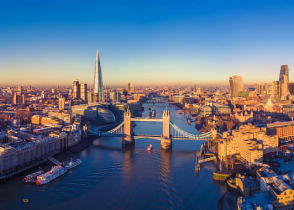
These Are The 10 Must-See Medieval Destinations In The UK ( & Their Best Hotels)
Looking for the best historical places to visit? Discover the UK's best medieval destinations & national landmarks, plus hotels & cultural tours.
The United Kingdom, what is it ? Some may say... It is a treasure map of medieval wonders. These are truly some of the best historical places to visit in the world. Picture this: ancient towns with stories of knights and queens, castles that have seen historic battles, and cathedrals that touch the sky. The country's identity was shaped by Germanic influences, Viking battles, famine, plague, and revolution. Despite this adversity, a rich Anglo-Saxon culture flourished, bringing art, poetry, philosophy, and economic success. These tales echo through the castle corridors, half-timbered houses, and cobblestoned streets that still stand today.
Today, travelers can relive the UK's Medieval history through cultural sightseeing while exploring historical buildings and monuments near deserted medieval villages. There are even many budget-friendly castle hotels for an immersive medieval experience that won't break the bank.
That being said, here are the 10 Must-See Medieval Destinations In The UK, including where to stay and what to see nearby.
Our recommendations for places to stay, as mentioned in this article, are based on research focused on Medieval destinations throughout the United Kingdom. All accommodations chosen have an overall rating above 8.0 and offer competitive rates compared to other similarly rated lodgings. We've also ensured to include places that provide the most extensive amenities for everyday travelers. Accommodations are ranked from luxury/high-end to budget-friendly.
Stratford-upon-Avon, Warwickshire
Located on the cusp of the Cotswolds, Stratford-upon-Avon is a medieval market town with more than 800 years of literary history. As the birthplace of William Shakespeare, it's one of the most visited tourist attractions in the world.
This town features half-timbered Tudor homes, the iconic Holy Trinity Church, and three theaters. Stratford-upon-Avon also offers a variety of hotels, country inns, and guest houses to welcome visitors. Here, book lovers can walk over 15th-century bridges in Shakespeare's footsteps from his birthplace to his final resting spot. Making it one of the best places in the UK for literature lovers.
- Ideal For: Groups, weekend getaways, book & theater lovers.
- Where To Stay: Ettington Park Hotel , The Billesley Manor Hotel , Pen and Parchment
Lavenham, Suffolk
Lavenham , often dubbed as 'England's best-preserved medieval village,' is a historical treasure nestled in Suffolk's countryside. Once thriving from the wool trade, this village showcases timber-framed buildings, as well as the Guildhall and the St Peter and St Paul Church.
Harry Potter fans will recognize the Guildhall and De Vere House as iconic filming locations for Godric's Hollow. Interestingly, the film's production team also used elements from various Lavenham houses to shape the movie set. Beyond its cinematic value, travelers enjoy the quaint shops, art galleries, and dining options.
- Ideal For: Day visits, Families Harry Potter Fans & Literature Lovers
- Where To Stay: The Swan Hotel , The Crown Hotel , The Cavendish Five-Bells
Related: Harry Potter Was Inspired By York's Medieval Street, The Shambles (& How To Visit)
Wells, Somerset
England's smallest city, Wells in Somerset, is also labeled as the UK's Top Tourist Destination, earning an all-around 5-star rating as a tourist attraction and 4 stars in terms of shopping, dining, and scenery.
Its preserved medieval architecture makes it a favorite for filmmakers, with credits in movies like "Hot Fuzz," "Dungeons & Dragons," and "Wolf Hall." The city is also home to the Cathedral Church of St Andrew, "most poetic of English Cathedrals. This Gothic marvel features the famed scissor believed to be the world's oldest functioning astronomical clock.
- Ideal For: History lovers, Netflix medieval fans, Medieval Markets
- Where To Stay: The Crown at Wells , Worth House , Bear Inn-Somerset by Marston's Inns
The Wells Cathedral clock chimes every 15 minutes, prompting a figurine of Jack Blandifers at the top to ring his bell and two animatronic knights to joust just above the clock.
Chester, Cheshire
Chester , originally established by the Romans in 79 AD as Deva Victrix, is one of the UK's best-preserved walled cities; overlooking the River Dee sits the 1000-year-old Chester Castle, which has hosted royalty such as King Edward I.
The city offers a unique shopping experience in the Chester Rows - double-decker galleries that turn retail into a delightful historical experience. History lovers will also delight in the fact that Chester is home to the UK's oldest racecourse and the country's largest Roman Amphitheatre too.
- Ideal For: Shopping Experiences, History & Architecture Lovers.
- Where to Stay: The Tudor Gathering Chester , The Chester Grosvenor , Leonardo Hotel Chester
Related: Why Chester Cathedral Boasts Some Of England's Most Impressive Medieval Architecture
Rye, East Sussex
Rye is a port town in East Sussex with a rich maritime history. Originally an island, the town's strategic location made it a hub for traders, shipbuilders, and even smugglers like the Hawkhurst Gang.
Today, travelers can explore the cobbled Mermaid Street and visit antique shops, modern eateries, cozy pubs, and the Rye Castle Museum. The 13th-century castle, also known as the Ypres Tower, showcases pottery, armor, medieval weapons, and a recreated medieval herb garden. Tourists looking for a scenic walk can visit Henry VIII's Camber Castle in the Rye Harbor Nature Reserve.
- Ideal For: Writers, artists, coastal explorers, foodies
- Where To Stay: The-Gallivant , Jeakes House , The George In Rye
Newbury, Berkshire
Newbury is a picturesque market town in Berkshire and home to the real Downton Abbey, Highclere Castle. One of the best places for fans of Downton Abbey to see . Visitors can explore the rooms and hear behind-the-scenes stories.
Newbury's town square showcases a medieval Cloth Hall, the 15th-century St. Nicolas Church, and preserved 17th- and 18th-century buildings. It is also home to a vibrant arts and culture scene; Theatre lovers can attend live performances at the Corn Exchange and Windmill Theatre. A short 20-minute walk from Newbury town center takes tourists to the popular Newbury Racecourse.
- Ideal For: Downton Abbey Fans, Theatre Lovers, Luxury Travelers
- Where To Stay: The Three Swans Hotel
Visitors should reserve their Highclere Castle, Downton Abbey tours well ahead of time to avoid disappointment. Many dates sell out fast, and the availability of "at the gate" tickets remains limited.
Winchester, Hampshire
Winchester , located in Hampshire beside the River Itchen, used to be England's capital. The city features ancient landmarks, a stunning city center, and tranquil walks for visitors to enjoy. It's an excellent place for a day trip in the UK.
The city's crown jewel, Winchester Cathedral, dates back to 1079 and is the final resting place of the famed novelist Jane Austen. The cathedral is home to the 17th-century Morley Library, with a 400-year-old book collection including the Winchester Bible. Another must-visit is the Great Hall, which showcases a medieval version of King Arthur's Round Table and the mysterious Sound II Statue.
- Ideal For: Day trips, literature lovers, luxury travelers
- Where To Stay: Superyacht on 5 Ocean Village Marina , Hotel du Vin Winchester, The-White-Star-Tavern
Salisbury, Wiltshire
Salisbury's streets are lined by Tudor townhouses, Georgian mansions, and Victorian villas, all protected by medieval walls. The towering 13th-century Salisbury Cathedral, which houses an authentic Magna Carta copy, proudly displays England's highest spire. A visit to Old Sarum offers the best panoramic views of Salisbury Plains.
The plains are home to the iconic prehistoric monument, Stonehenge. Visitors can catch the daily hop-on-hop-off tours between Stonehenge and Salisbury station.
- Ideal For: Breathtaking Views, family visits, historic sites & attractions
- Where To Stay: Stonehenge Cottages , Sarum College , The Chapter House
Related: 10 Ancient Archeological Sites To Explore In (And Around) Stonehenge
Clitheroe, Lancashire's Ribble Valley
Clitheroe , located in Lancashire's Ribble Valley, is a popular medieval market town. It is home to Clitheroe Castle, England's smallest Norman castle, which is set amidst 16 acres of landscaped gardens. Visitors can explore half-timbered Tudor townhouses, Georgian mansions, and the award-winning Clitheroe Castle Museum.
The Ribble Valley Sculpture Trail, launched in 1993, showcases over 20 diverse artworks and offers stunning views of the Bowland hills and local wildlife sightings.
- Ideal For: Nature exploration, arts & culture, day trips
- Where To Stay: Mitton Hall Country House Hotel , Stirk House Hotel , Foxfields Country Hotel
Sherborne, Dorset
Named from the Saxon words 'scir burne,' meaning 'clear stream,' the beautiful town of Sherborne is often overlooked by tourists. Visitors can explore the two majestic castles, one being the ruins of a 12th-century palace and the other a 16th-century mansion used as a training camp during WW1.
Travelers flock here to visit the iconic Sherborne abbey established in the 8th century. Beyond its historical landmarks and architectural marvels, Sherborne is home to various farmers' markets, antique shops, and art schools, making it a landmark for cultural sightseeing.
- Ideal For: Antique lovers, history buffs, cultural tourism
- Where To Stay: Lanes Hotel , The Grange at Oborne , Stoneleigh Barn Bed and Breakfast
Landscapes of Medieval England
Article about Medieval England supporting Britain's history from the Roman 's to Queen Victoria and the industrial revolution.
15 Sep 21 · 12 mins read

While human history is portrayed as ever changing, we tend to think of the natural landscape as static and unmoving. In reality, human activity and the land are always entwined, constantly shaping one another as they evolve. We cannot assume that the landscapes of the past are the same as what we see around us today.
This article aims to immerse the reader in the landscapes – town, city, and countryside – of medieval England, with a focus on the 14th century (1300-1400). To do this, we have drawn on Ian Mortimer’s book, The Time Traveller’s Guide to Medieval England.
Mortimer begins his immersive history by vividly setting a typical scene:
Imagine yourself in a dusty London street on a summer morning. A servant opens an upstairs shutter and starts beating a blanket. A dog guarding a traveller’s packhorses starts barking. Nearby traders call out from their market stalls while two women stand chatting, one shielding her eyes from the sun, the other with a basket in her arms. The wooden beams of houses project out over the street. Painted signs above the doors show what is on sale in the shops beneath. (Mortimer, The Time Traveller’s Guide to Medieval England, 1).
This article is part of our series on England and Great Britain, designed to provide background before you go on an England tour with us, or to simply help you firm up your travel plans. Our articles on England can be found here .
Travellers with a particular interest in the Middle Ages might want to take a look at our previous articles on the topic: A Traveller’s Guide to Medieval England , Village Life in Medieval Britain and Understanding British Churches .

By the standards both of our own time and of the Middle Ages, the cities of medieval England were small. Only the largest – London, with a population of around 40, 000 – could compete with the largest continental cities: Bruges, Ghent, Paris , Venice , Florence and Rome , all of which had populations of over 50, 000. Following London, the ten largest cities in 1377 were:
- York – 12, 100
- Bristol – 10, 600
- Coventry – 8, 000
- Norwich – 6, 600
- Lincoln – 5, 900
- Salisbury – 5, 400
- Lynn – 5, 400
- Colchester – 4, 900
- Boston – 4, 800.
All in all, historians can assume that around 170, 000 people lived in the thirty largest settlements in England. Beyond the biggest cities, there were about two hundred other market towns in England with more than four hundred inhabitants.
In total, about 12% out of a population of 2.5 million English people in 1377 lived in a town of some sort, while 6-7% percent lived in the largest cities.
Small cities dominated Medieval England
The small size of regional cities shouldn’t make you assume that they were sleepy, however. The cities were home to an ever-changing population of travellers – clergymen, merchants, messengers, king’s officers, judges, clerks, master masons, carpenters, pilgrims, painters, itinerant preachers and musicians. Many merchants and traders came from abroad, and foreign accents and languages were commonly heard in most cities. Moreover, while the majority of the population lived in the countryside, they made regular trips to towns and cities, further expanding the temporary population.
Most of all, medieval cities were geographically small, leading to an overwhelming array of human sounds, smells and activities within a confined space. As Mortimer describes:
Arriving [in the city] involves an assault on all the senses. Your eyes will open wide at the great churches, and you will be dazzled by the wealth and the stained glass they contain. Your nostrils will be invaded by the stench from the sewage-polluted watercourses and town ditches […] In any town on a market day, or during a fair, you will find yourself being jostled by the crowds who come in from the country for the occasion, and who live it up rowdily in the taverns. To visit an English town in the late fourteenth century is a bewildering and extreme sensory experience (Mortimer, The Time Traveller’s Guide to Medieval England, 7).
At the heart of most medieval cities was the cathedral. In most cities, it is the tallest building by far – hundreds of times bigger than the buildings that surround it. It is usually the first thing visible when you reach town.
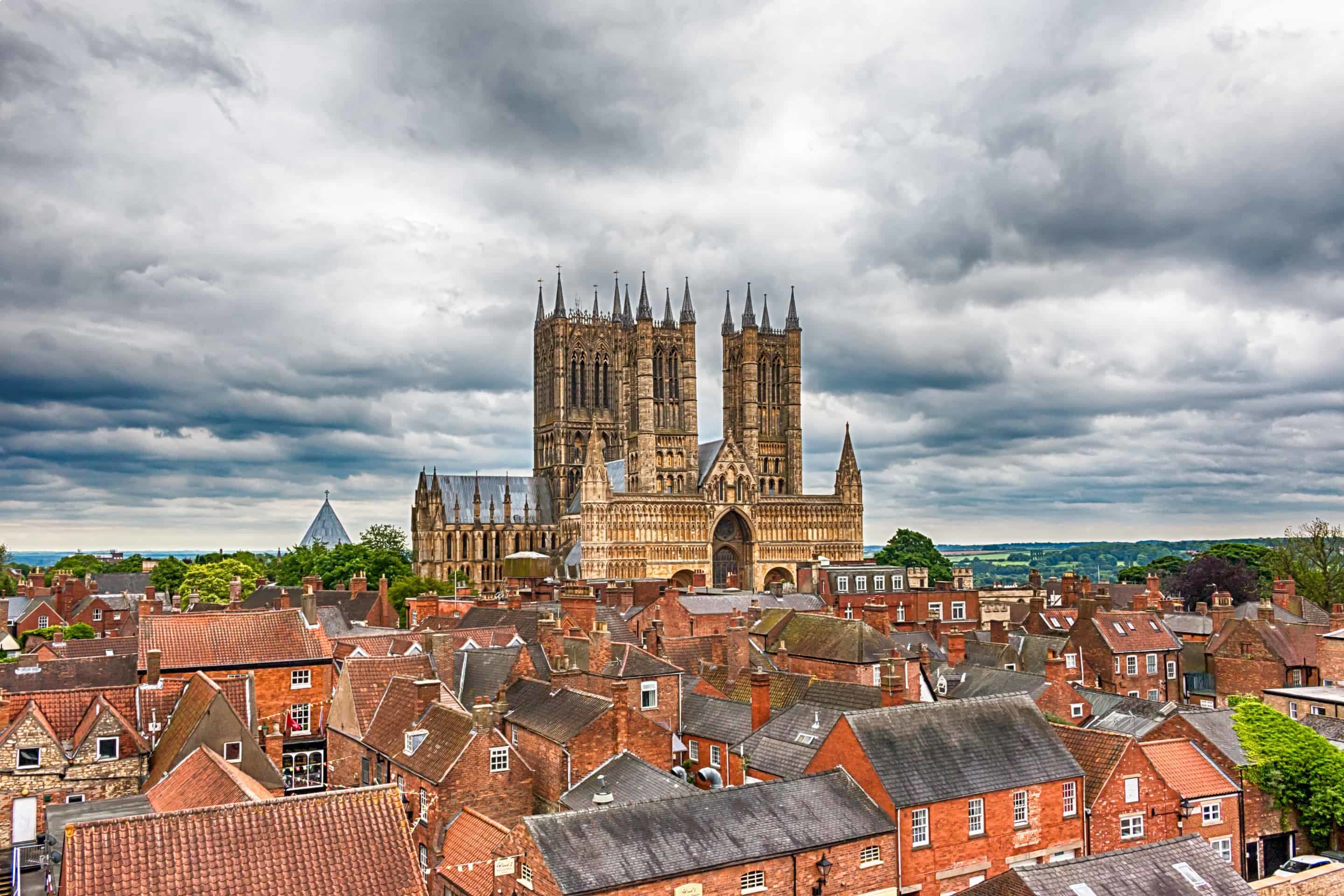
The area surrounding the cathedral was usually enclosed by a wall, letting people in during the daylight hours, and keeping them out after dark. Older monasteries, many of which dated back to the Saxon era, were sometimes located in the centre of the city, and were likewise walled off, as were royal palaces. In most cities, between a third and a half of the area within the city walls was given over to these religious and secular precincts.
The result was that most of the population had to live in only half the city. The finest houses, those of merchants, churchmen, and those in the growing professions, were situated on the widest, grandest, and cleanest streets, usually those between the city gate and the centre of town. While at the start of the 14th century, most of these houses were made of wood, by 1400 they were usually stone structures, with chimneys and glazed windows.
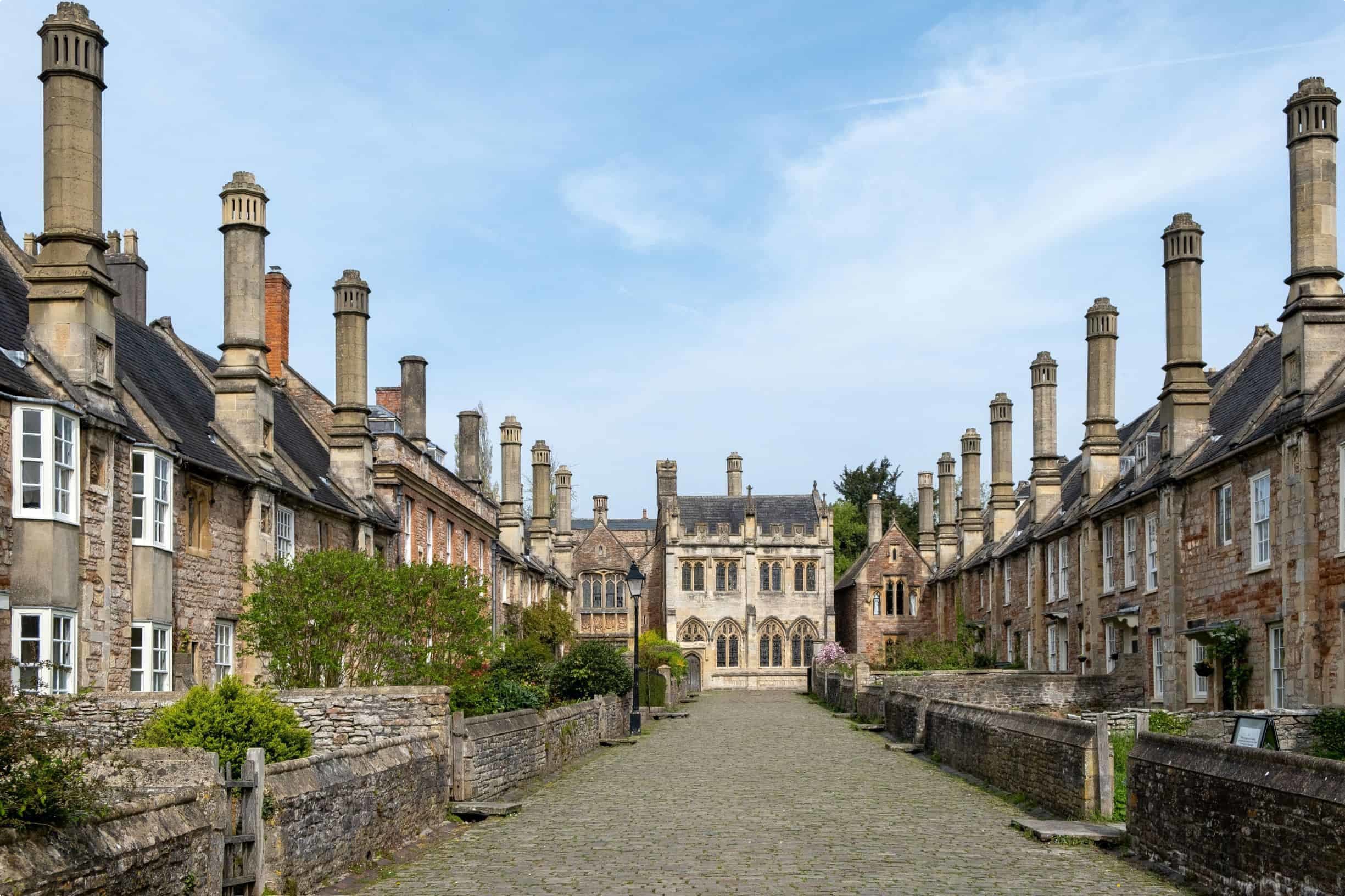
The houses of less successful merchants were more modest. These tended to be narrow and tall, no more than about 15 or 16 feet wide, but three or four stories in height. Merchants purposely built tall and narrow in order to have frontage on the main marketplace, and many operated stores and workshops on the bottom floor of their home. Only the richest merchants had houses separate from their warehouses.
Off the main streets of the city were the more modest houses of the town’s poor. Alleys were often no more than six or seven feet wide. The jetties of the second and third stories are usually within three or four feet from another, blocking the sun from reaching the street below. Some alleys were muddy paths, which, if not cleaned, became dank, smelly and unsavoury – particularly when wet.
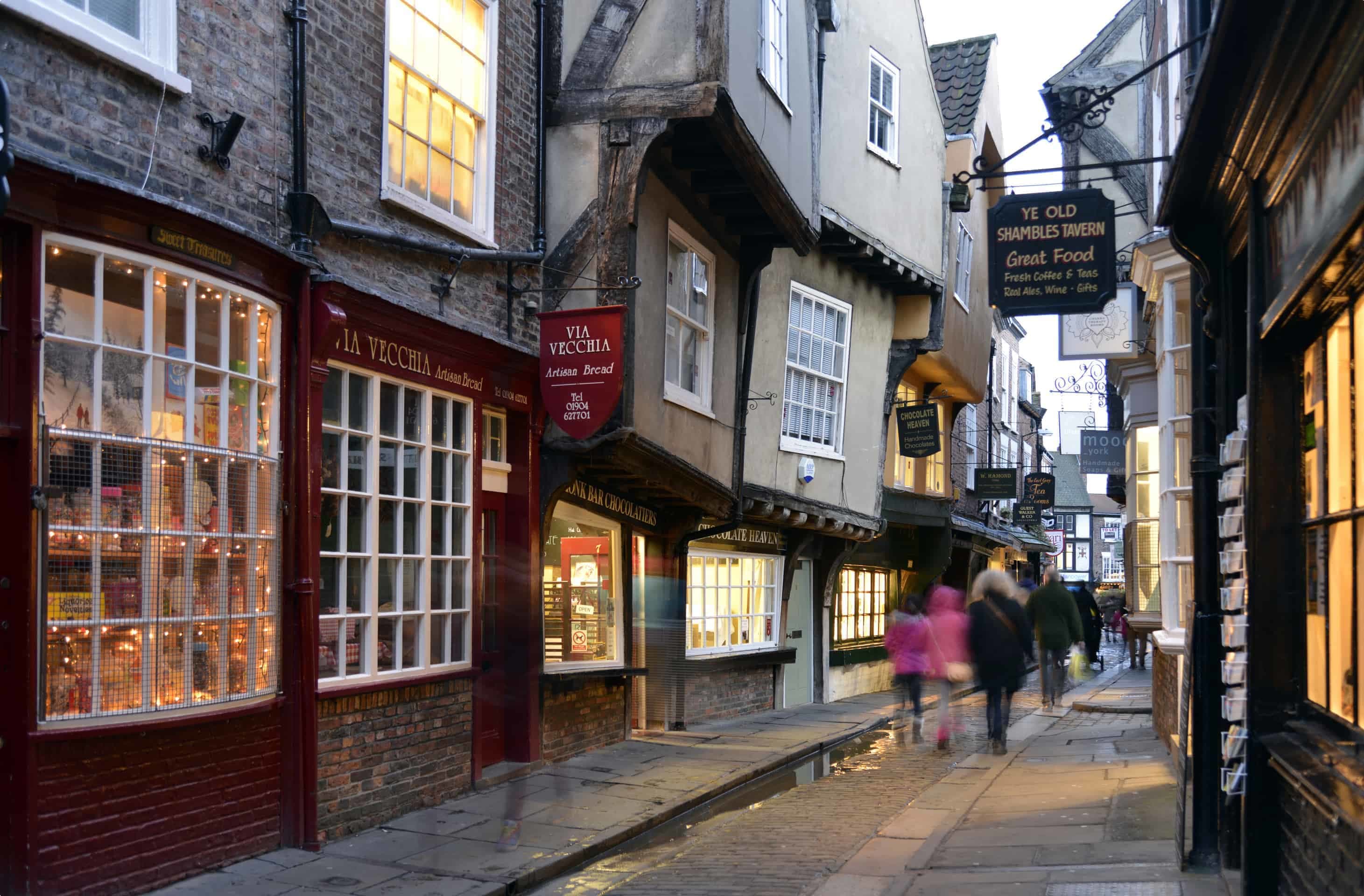
The poorest of the poor lived on streets that were narrower still, often only three or four feet wide, in low, single-story terraces of timber buildings, subdivided into small rented rooms. Paths and allies leading to them are little more than drains, ‘effectively open sewers’ (Mortimer, The Time Traveller’s Guide to Medieval England, 12). Most poor families lived in a single room divided into two unequal parts, the smaller for children to sleep in, and the larger for cooking and the adults’ mattresses.
Another notable feature of the medieval city is the total absence of public space. There were no public parks or gardens, and open squares were rare in English cities, except when they served as the marketplace. The street was the only domain of the people. It was there that they heard news, saw performances, and met for large events.
If the standard medieval city was a place of extremes, London was the most extreme of them all: the richest, the most vibrant, the most polluted and the most diverse. Already dominant at the beginning of the 14th century, the next 100 years would see London’s status further enhanced as the city of Westminster became the permanent seat of government in the 1330s.
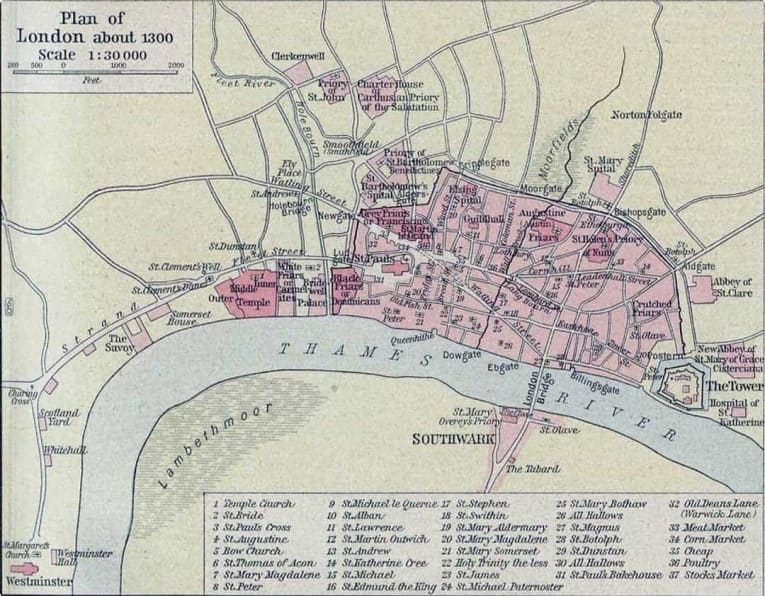
Visitors to London were overwhelmed by the spectacle. The city was home to so many houses, so many shops, so many boats bobbing on the Thames, and so many people – many of whom were dressed in fine velvet, satin and damask. Luxury houses lined the long and elegant strand, joining the city to the adjacent town of Westminster.
Yet, London was also home to extreme filth and poverty. The streets were not paved; there was no sewage system; and rats – harbingers of the 1348-9 plague – were seen everywhere. The city was highly over populated, and slowly grew beyond the town walls. As a major manufacturing centre with a large population, London created an unending stream of rubbish – sewage, rotting carcasses and industrial waste.

The situation did improve over the 14th century. At the beginning of the century, tanners (the treating of hides and skins to produce leather) could set up shop next to residential houses; and sellers of animal skins and wools were neighbours of spicemongers and apothecaries. In 1309, fines were levelled on those who leave human or animal excrement in the streets. In 1310, tailors and pelterers were forbidden from scouring furs in the main streets. From 1357 it was made illegal to leave dung, crates and empty barrels in the street, and to throw rubbish in the Thames and Fleet rivers. Finally, in 1371, the slaughtering of large beasts within city limits was prohibited.
Nor was it all filth. Medieval London was also home to stunning architecture. Though the medieval city was largely destroyed in the Great Fire of 1666, several important pieces of architecture remain:
The Tower of London:
While the iconic White Tower, built by William the Conqueror, was already an old building in the 14th century, the majority of the tower dates from the 13th century. Highlights include an extensive royal palace, including great hall, private living room, the royal library and the royal menagerie. From the late 1330s the King’s collection of lions, leopards and other big cats is kept here, continually supplemented with new animals.

London Wall:
Like all medieval cities, London was surrounded by a high wall, in order to keep the city safe at night. London’s wall was first built by the Romans in the late 2nd and early 3rd centuries. The walls were repaired and rebuilt through the Middle Ages, though by the late medieval era, the city had expanded well beyond the walls.
Though most of the medieval city was destroyed in the 1666 Great Fire of London, patches of the walls remain . Some of the most impressive fragments date from the Middle Ages, including the Museum of London Tower, built in the 13th century, and Postern Gate, rebuilt in 1440.
Westminster Abbey:
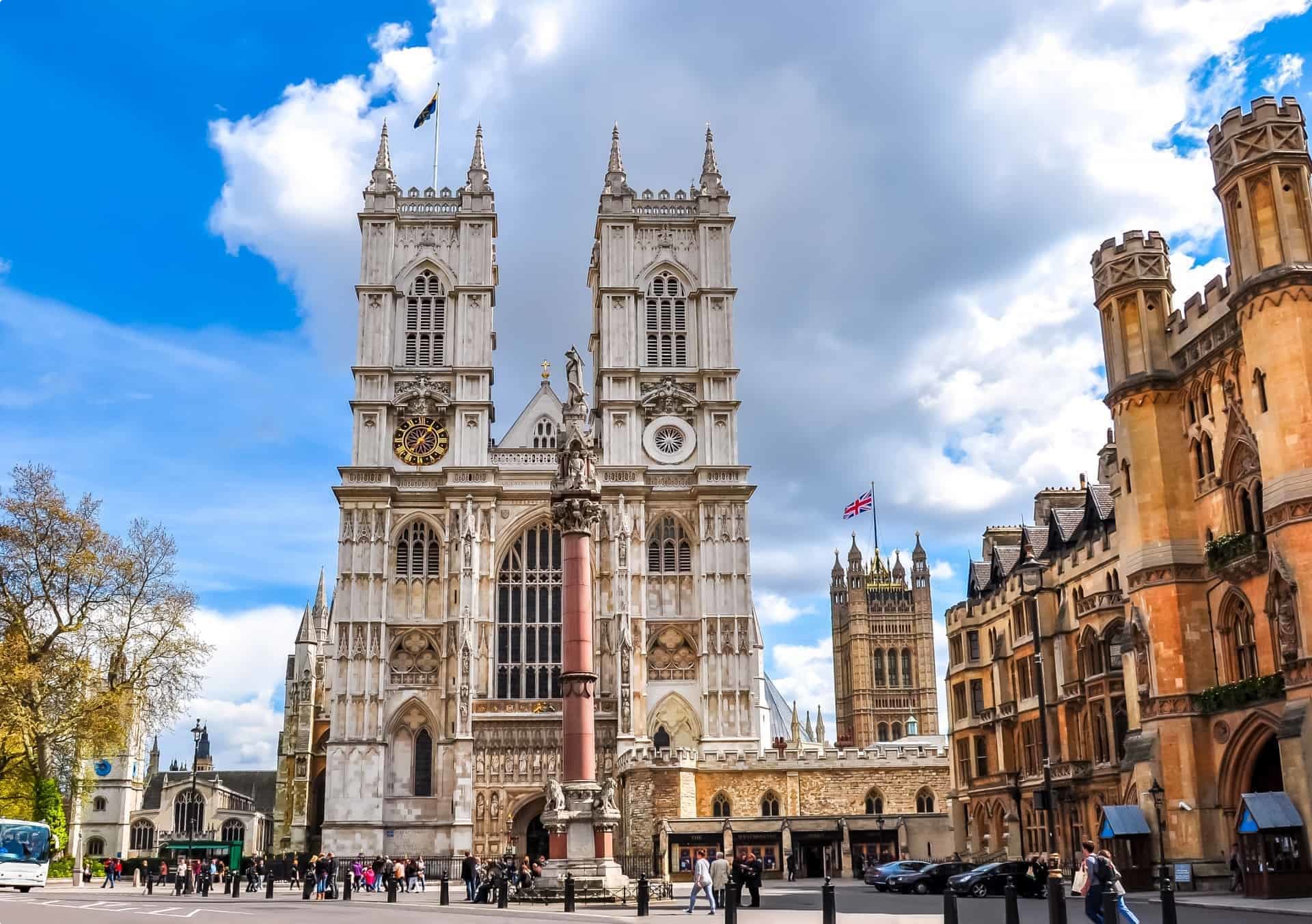
First built by the Anglo-Saxon king Edward the Confessor in from 1040-1050, the church was the first in England to be built in a Romanesque style. The Abbey was almost entirely rebuilt by Henry III in the thirteenth century at a cost of more than 41,000 pounds – making it the second-most expensive building in the whole of medieval England (second only to Edward III’s work at Windsor Castle). In the Middle Ages, Westminster Abbey was covered in magnificent wall paintings, sadly gone today.
St Olave’s Church:
This church was constructed around the 1250s, and is one of only few churches from the Middle Ages to have survived the 1666 Great Fire. It is one of the smallest churches in London.
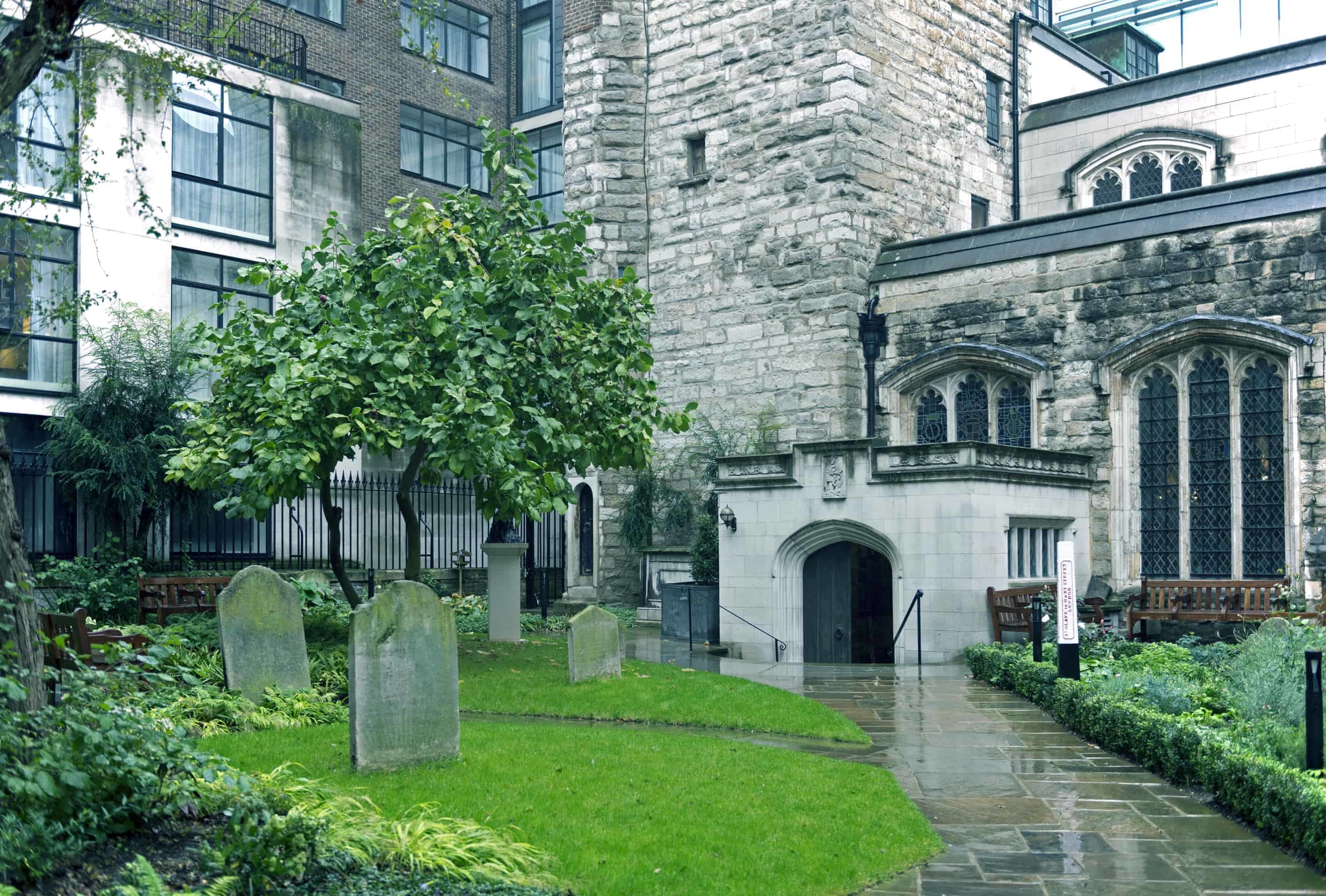
Charterhouse:
These buildings were used in the 14th century as a burial ground for victims of the Great Plague. The Charterhouse was subsequently used as a priory, a boy’s school and an alms-house. Though most of the buildings were rebuilt in the 16th century, there are still substantial remains from the Middle Ages.
Cloth Fair:
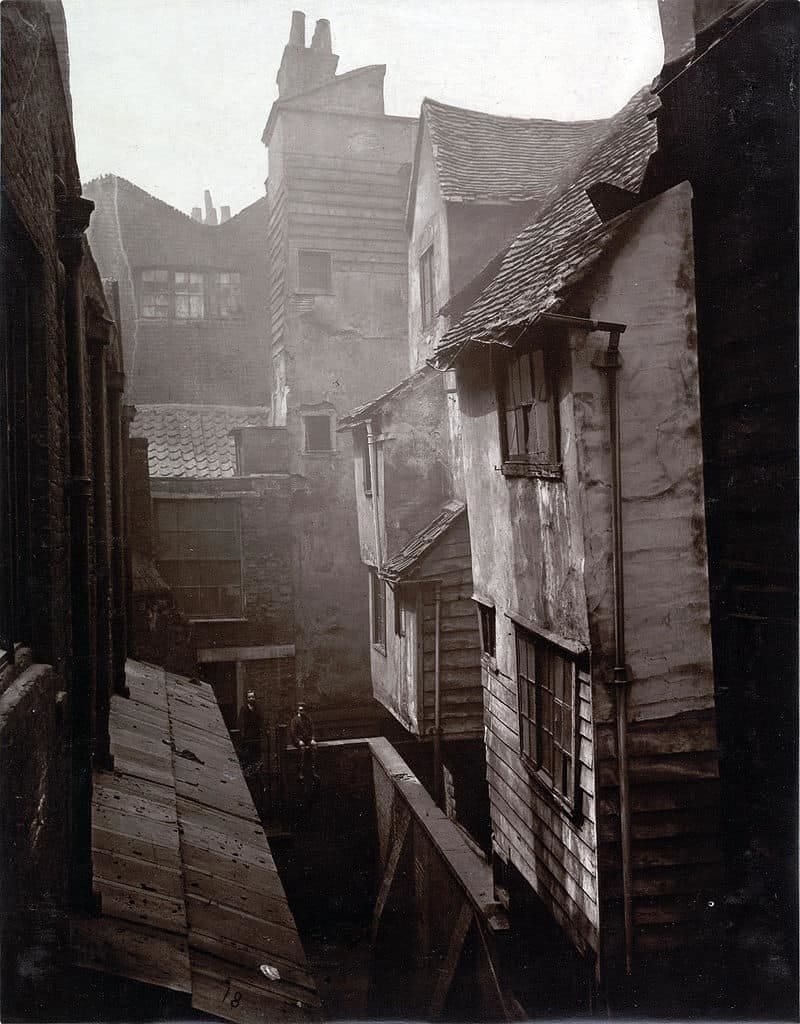
The name of this medieval street comes from its original use as the place where medieval merchants bought and sold cloth during St. Bartholomew’s Fair. Because the houses were within the walls of St. Bartholomew’s Church, they survived the Great Fire of 1666. Though most of the medieval buildings were torn down in slum clearance after World War I, the oldest residential house in London, built between 1597 and 1611, can be found here.
The Church of St. Bartholomew the Great:
This church is a good example of Norman, or Romanesque, architecture. Founded as a priory in 1123, the medieval nave was pulled down in the 1500s. Some parts dating to the Middle Ages remain, including the crossing (the junction were the four arms of a cross-shaped church meet), and the choir (the area between the nave and the sanctuary). In the 18th century, Benjamin Franklin – one of the US’s founding fathers – worked here as a typesetter, while the church was a location in the movie Four Weddings and a Funeral.
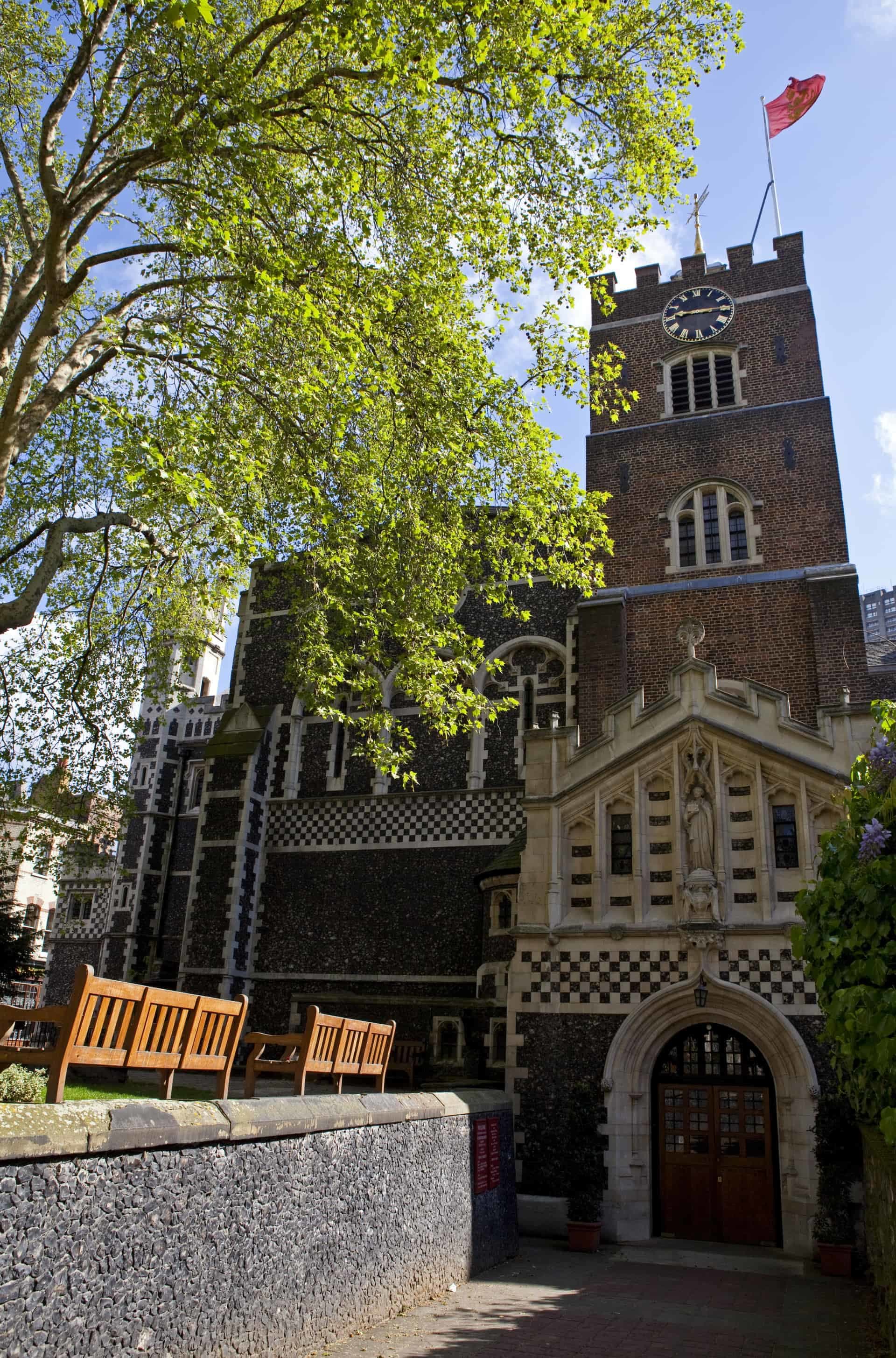
Small towns and villages
Most small towns had populations of around five hundred – three or four streets, about a hundred houses, and some stables. Today, most people would probably think of a settlement of that size as a village – but in the Middle Ages, town status was granted to any settlement with a market.
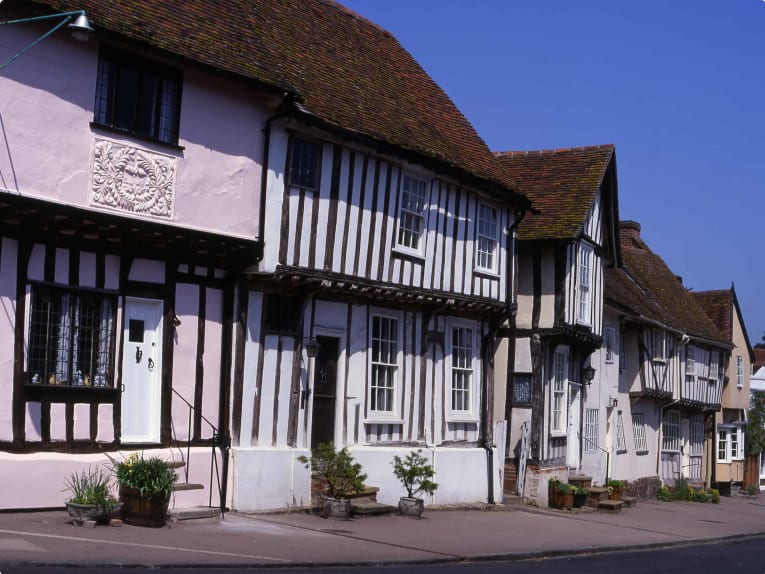
A town with a market had importance far beyond its small population. It served a large rural hinterland. Farmers came to buy plowshares, and sell their livestock and grain. They and their wives needed to buy cookware, salt, candles, needles, leather goods and other items. Even well-off people on remote manors needed to head to town (or send a servant) to pick up necessary goods such as nails and other tools.
By 1300, almost nowhere in England was more than eight miles from a market town . Unlike the cities, market towns did not have high walls to protect the city. They tended to be gathered around the marketplace. Other principal structures were the church, the manor house, the vicarage, and the inns. There was no guildhall, or monastery or friary.

The streets would be muddy and uneven, and like in the cities, filthy. The marketplace was probably full of little wooden stalls, lived above by the traders. There were none of the ordinances found in the cities that prevented unsanitary trades from being carried out.
On market day, the scene was different. There was a palpable energy: a huge crowd from the surrounding districts, as well as travellers from other parts of England and abroad. Music was heard in the streets, and the ale houses were full of people laughing and enjoying themselves.
Even smaller than the towns were villages , medieval settlements without a market. These had little order in layout or presentation. Houses were generally made of limewashed cob and had broad thatched roofs.
The countryside
By the 14th century, most of rural England was under human control. Around seven percent of the land was woodland, not much more than today’s Britain. The woods were managed carefully by people. Some sections were cleared for timber, while the right to gather sticks and fallen timber was often granted to tenants by the manorial lord.
Yet, the trees in medieval England were very different from those seen today. There were few coniferous species – these would be subsequently grown. The absence of evergreens meant that the winter skyline was particularly bleak. The trees were largely those introduced by the Romans, mingled with regrowth dating back to the Ice Ages: rowan, ash, field maple, hazel, chestnut, aspen, poplars, birch, willow, elm and oak.
The animals, too, were different. All the squirrels were red – the grey variety had not yet reached Britain. Cows, sheep, and other farm animals were much smaller than their modern counterparts.
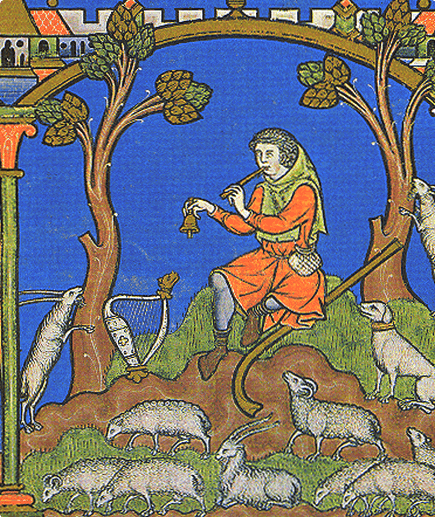
The 14th century saw substantial changes in climate: the average temperature dropped by about one degree centigrade. While this might not seem like a huge drop, it had significant ramifications: while England had a small wine industry in 1300, by 1400 this was destroyed. The colder climate meant greater rainfall, which flooded roads and ruined crops.
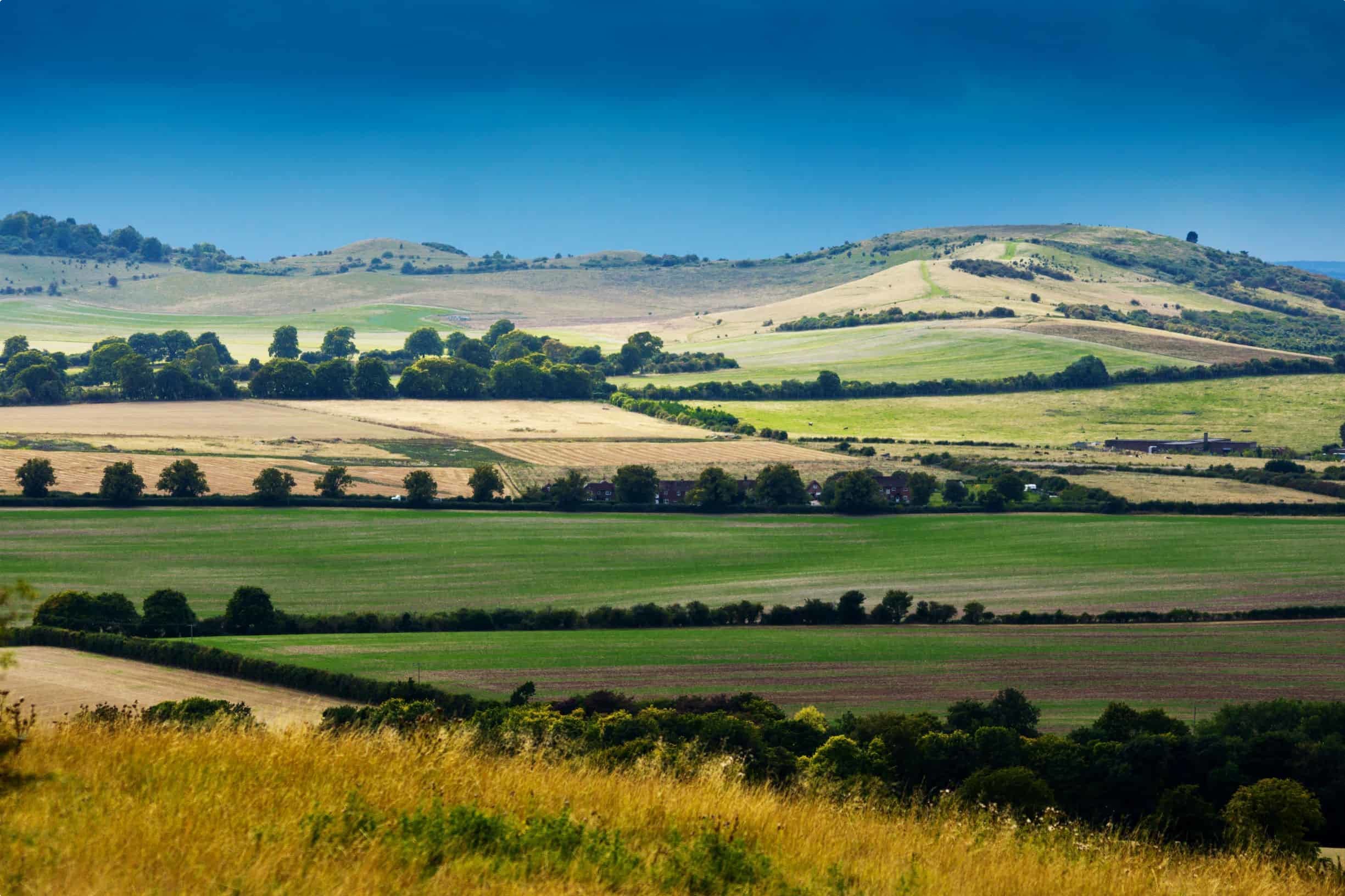
The way that the land was used for agriculture differed, too. While modern English fields tend to be small, square and even, in the fourteenth century most fields were massive and irregularly shaped, enclosed by dry stone walls . They were then divided into individual strips of land, maintained separately by each tenant. Prior to the development of crop rotation , every third strip of land would have been left fallow, grazed in the meantime by cattle, sheep, goats or pigs.
Around these huge areas of land were the commons: collectively owned land (or land where tenants were able to exercise traditional rights of usage) that peasants used to graze sheep and grow hay, or woodlands used to provide firewood and building materials.
The population density of rural areas varied considerably across England. The most densely populated areas were in the lowland regions of East Anglia. The highest population density in England in 1377 was in Bedfordshire, with a population of 73 people per square mile.
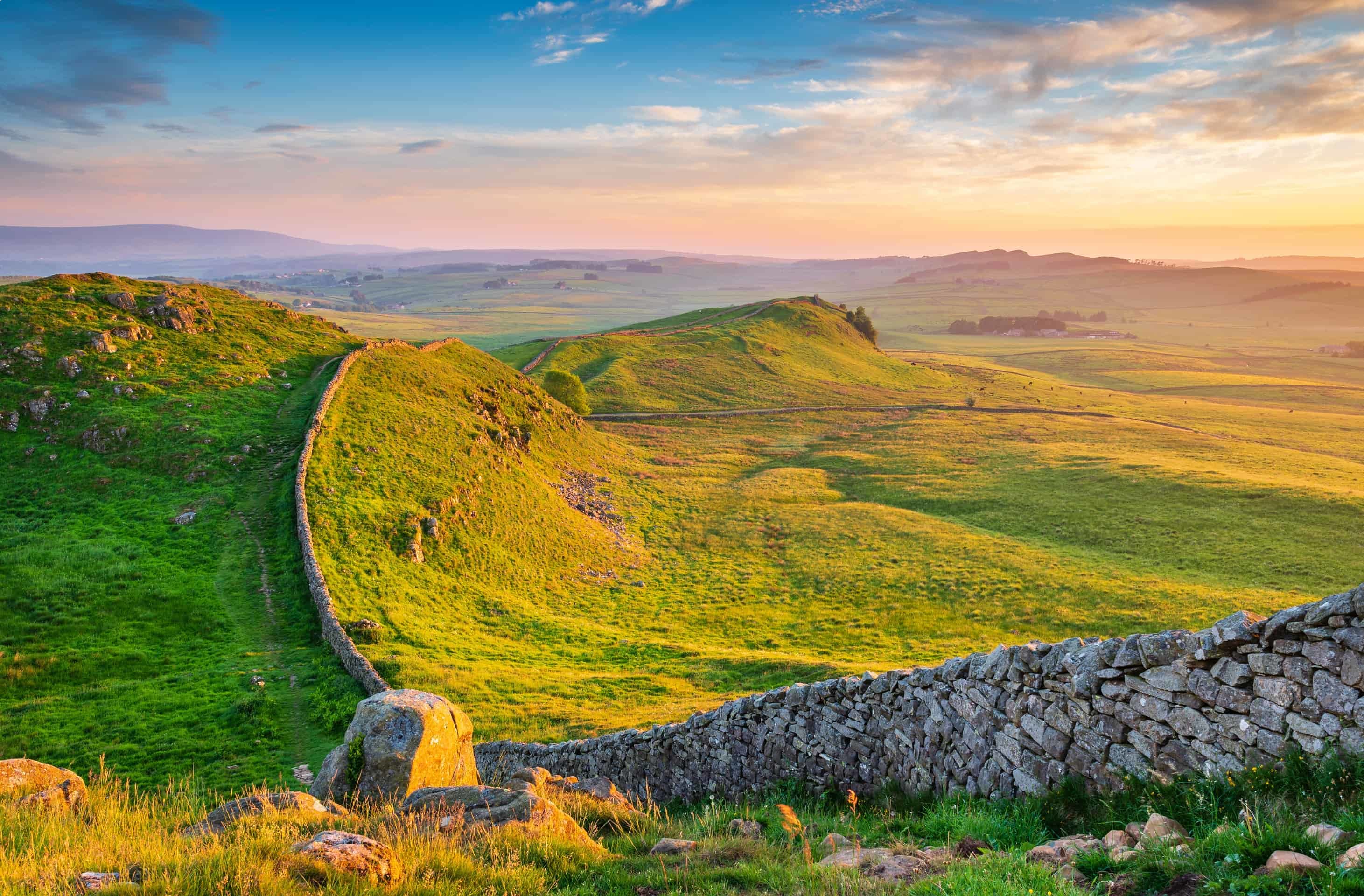
By contrast, hilly regions had a much lower (and poorer) population. Many settlements in these regions were abandoned after the Great Plague. The largest areas of abandoned landscape were found in the North, particularly in the Scottish-border counties of Cumberland and Northumberland. In 1377, Cumberland had a population density of 13 per square mile, but this statistic does not clearly evoke the swathes of territory totally deserted due to Scottish incursions.
If this article has interested you in learning more about the medieval history of England, think about joining our small group tour of Medieval England . This tour is one among many devoted to the history and culture of England – take a look at the full list .
You might also be interested in our summer school devoted to Medieval and Renaissance Women .
Related Tours
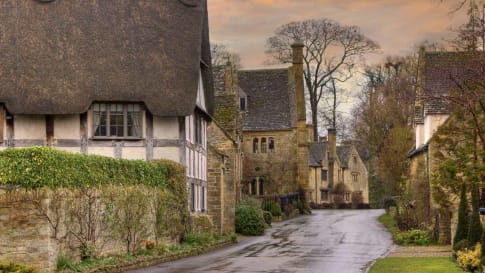
England’s villages small group history tours for mature travellers
Visiting England
Guided tour of the villages of England. The tour leader manages local guides to share their knowledge to give an authentic experience across England . This trip includes the UNESCO World heritage site of Avebury as well as villages in Cornwall, Devon, Dartmoor the border of Wales and the Cotswolds.
From A$14,750 AUD

Prehistoric Britain small group history tour including standing stones
Visiting England, Scotland
This guided tour invites you to explore UNESCO World heritage sites at Skara Brae in the Orkneys , Isle of Skye , and Stonehenge in a prehistoric tour. This escorted tour has trips to key sites in Scotland , and the Irish sea in Wales such as Gower Peninsula and National Museum in Cardiff and England. Each day tour is supported by local guides.
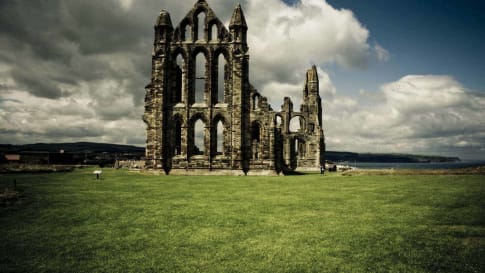
Rural Britain | Walking Small Group Tour
A walking tour into England , Scotland and Wales provides small group journeys with breathtaking scenery to destinations such as Snowdonia national park , the UNESCO world heritage site Hadrians wall and the lake district . each day tour provides authentic experiences often off the beaten path from our local guides.
From A$13,750 AUD

Small group tours Medieval England
A small group tour of England focused on Medieval England and Wales . Spend 21 days on this escorted tour with tour director and local guides travelling from Canterbury to Cambridge, passing through Winchester, Salisbury, Bristol, Hereford and Norwich along the way. Castles, villages, Cathedrals and churches all feature in the Medieval landscapes visited.
From A$12,750 AUD
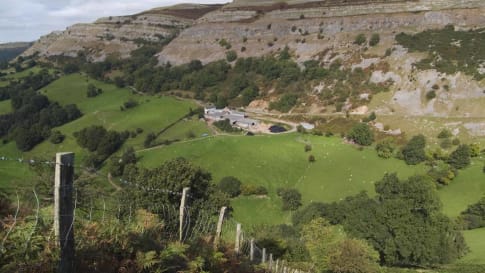
Walking Ancient Britain
A walking tour of England & the border of Wales . Explore on foot UNESCO World Heritage sites, Neolithic , Bronze age and Roman landscapes and the occasional Norman castle on your journey. Your tour director and tour guide walk you through the Brecon beacons , the Cotswolds and Welsh borders on this small group tour.
Related Articles

Discovering Medieval Chester: A Thriving Trade Centre
Article about Chester, England for small group educational tours for senior couple and mature solo travellers to England. Articles to support your travel plans to explore England , Scotland , Wales and Ireland.
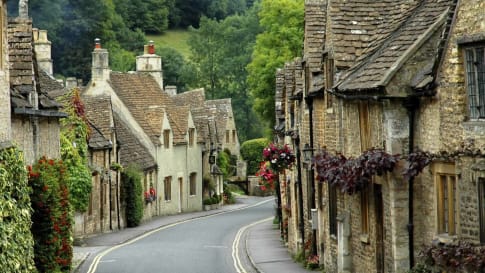
English Village History
An English Village history. Prepared for mature and senior travellers, couples or solo traveller considering joining a small group tour of England's villages .
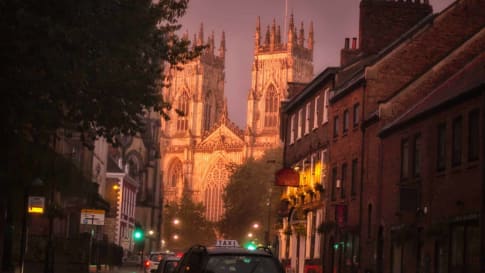
Exploring York
Article about York, England. Explored on a small group educational tour for senior couples and mature singles curious about history from the Romans , the Vikings and the industrial revolution. Including the famous York Minster a great cathedral!

Lumps and Bumps: How to Read the British Landscape
The British landscape has been worked and re-worked. It is secrets of this palimpsest landscape is revealed through drainage patterns and prehistoric features all the way through to the modern day. These small group tours for mature and senior travellers examine the landscape from the Neolithic , to Roman, through the seven ages of Britain in walking tours and history tours of Britain.
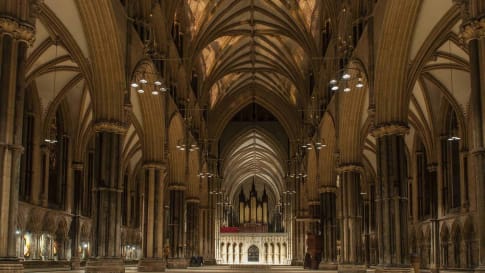
Traveller's Guide to Medieval England
A travellers guide beyond the landscapes of Medieval England supporting Britain's history from the Roman 's to Queen Victoria and the industrial revolution.

Understanding British Churches: The Definitive Guide for Travellers
British Churches Through the Years “How old is this church?” asks Mary-Ann Ochota in a chapter of her book, Hidden Histories: A Spotter’s Guide to the British Landscape (Francis Lincoln, 2016, p. 250). In this article, we…
British Isles

Join 22,383 like-minded travellers receiving our weekly newsletter.
Medieval England Private Day Tour from London

- All Fees and Taxes
- Entrance tickets
- Air-conditioned vehicle
- Fuel - Return journey to the castle from Bromley South Station
- No tour fee for kids 10 years and under. (Must be accompanied by a relative 21+ years old).
- Local professional tour guide
- Entry/Admission - Ightham Mote
- Entry/Admission - Penshurst Place & Gardens
- Audio guides
- Hotel pick-up
- Meals and beverages
- Station Approach, Bromley BR1 1LX, UK At the pick-up and drop-off point beside the station.
- Not wheelchair accessible
- Near public transportation
- Infant seats available
- Confirmation will be received at time of booking
- Not recommended for travelers with back problems
- Not recommended for pregnant travelers
- No heart problems or other serious medical conditions
- Travelers should have a moderate physical fitness level
- This experience requires good weather. If it’s canceled due to poor weather, you’ll be offered a different date or a full refund
- This is a private tour/activity. Only your group will participate
- For a full refund, cancel at least 24 hours in advance of the start date of the experience.
Similar experiences

- You'll start at Station Approach Station Approach, Bromley BR1 1LX, UK At the pick-up and drop-off point beside the station. See address & details
- 1 Ightham Mote Stop: 90 minutes - Admission included See details
- 2 Penshurst Place & Gardens Stop: 2 hours - Admission included See details
- You'll return to the starting point

- 831andreab 0 contributions 5.0 of 5 bubbles Marvelous tour! My recent tour of Hampton Court with John was just spectacular. It was such a rich experience; taking in the contrasts in the architecture and design, the gardens, the many paintings and exquisite tapestries. John is such pleasant company & he guides at an easy pace. I especially enjoyed the pauses to converse with the staff who were friendly & happy to share their knowledge. A delightful walk through English history. Highly recommend. Read more Written November 23, 2023
- bobwH5288EQ 0 contributions 5.0 of 5 bubbles Superb Day at Cantebury and Leeds My wife Kate and I and her unmarried brother ( between ages 65 and 78) planned one excursion outside greater London on our recent 6 day visit. I chose John England Tour about a month in advance. It went brilliantly as the English say in every phase; pre -trip planning and actual execution , despite unpredictable stormy weather along the east coast. Originally I chose Dover Castle and Cantebury but on the day of the excursion, due to the possibility of flooding along the coast, we diverted after visiting Cantebury and Cantebury Cathedral ( really more like two sites in one visit), where we encountered a bit of drizzle, to Leeds Castle. Other reviews cover these beautiful spots and John's very personable way of presenting them for easy, friendly unhurried touring. Let me instead praise John's precision and reliability in making sure his guests know how to find their way to Bromley South by rail from central London ( which was fun) and to enjoy an outstanding, no surprises excursion in Kent. His cross -the-Atlantic communications were prompt, clear, precise and accurate. He was on time, organized and efficient on the day of the trip. His auto was clean and comfortable and he is a safe, careful , smooth driver. We enjoyed every moment and aspect of our day with John. We recommend him without reservation, and you will be very pleased if you visit Cantebury Cathedral, the town of Cantebury, and Leeds Castle with him as your driver and guide. Read more Written October 30, 2023
- F1350NUsusanc 0 contributions 5.0 of 5 bubbles Well worth the $$! My husband and I really wanted to see Chartwell. We have always been intrigued by Clemmie and Winston, and have done quite a bit of reading about that time in history. We felt that we would be best served by a private tour, and John did not disappoint! While it is definitely more expensive to take a private tour, we felt that it was well worth it the money. We were picked up at the train in Bromley, taken directly to Chartwell, given many fun stories (which we love!), and then taken back to the train to go back to London. It made what could have been a complicated trip so much easier. John is a very knowledgable and fun guide! Read more Written October 13, 2023
- Compass141830 0 contributions 5.0 of 5 bubbles Excellent Worthwhile Tour John was a great tour guide. Very thorough in regard to directions as to where to meet him. Constant communication. Very organized once we reached Chartwell. He knew to get there early and what order to see things so we would get the most out of our visit. We loved seeing Chartwell, but it was made more interesting because John knew many of the docents and introduced us to them. They added interesting tidbits about the home and occupants that we might not have heard otherwise. The whole property is incredibly peaceful and it is easy to understand, after being there, why Churchill loved it so much. John conducts a lot of other tours. We would certainly consider contacting him if we go back to England. Read more Written October 8, 2023
- chitowngirl55 0 contributions 5.0 of 5 bubbles Lovely day outside of London A highlight of our visit to London was the private tour we took with John to Chartwell and Hever Castle. John has a thorough knowledge of the history around Churchill and his life at Chartwell. He also provided a complete history of Hever Castle and the role of the kings and queens at that time in England's history. We were very confident with John's driving. His personable demeanor added to the very pleasurable experience of the day outside of London at beautiful Chartwell and Hever Castle. Highly recommend this tour if you are interested in Churchill and the medieval history of Hever Castle. Read more Written October 8, 2023
- candicesR7615AL 0 contributions 5.0 of 5 bubbles Best private tour guide! John is a rare gem! My husband and I took the “Private Tudor Day Tour to Hampton Court Palace and Hever Castle” in September 2023. I booked John after hearing him speak on a travel podcast- I had loved listening to him speak on the podcast and knew right away that I would enjoy learning from him in person as well. John is everything that you would want in a driver guide- professional but warm, full of information, easy to talk to, and intuitive on guest’s needs. There is no doubt that we would book John again on future trips to the UK! Fantastic experience, would highly recommend! Read more Written October 3, 2023
- susandS435QO 0 contributions 5.0 of 5 bubbles An amazing Pooh adventure I asked our travel agent, during the planning of our trip to England, if there was any way we could do an adventure to Pooh Corner and Ashford Forest. Once she found the John England Tours "Pooh Corner and Pooh Sticks Bridge" through Viator, we booked it. Almost immediately after booking, John reached out to me. We emailed back and forth about where to meet, and what to expect. Winnie the Pooh has held a special place in my heart since I was a child. On our honeymoon, 45 years ago, my husband bought me a Pooh bear that sits above our bed. He has been there for me through happy times and sad times. To be able to go to Pooh Corner and Pooh Sticks Bridge in Ashford Forest was magical. John met us at Bromley South. We traveled through the countryside and he was our private tour guide, pointing out places of interest as we drove. We were so relaxed with him, like we had been friends for years. Thanks to John, we were able to have lunch at Pooh Corner and thoroughly enjoyed walking through the rooms filled with so many unique Pooh items. After a few pictures and purchases, we headed to the Ashford Forest. As we walked down the path, I felt like a little kid eager with anticipation. Along the way, John stopped so we could find Piglet's house and Owl's house. When we arrived at Pooh Sticks Bridge, we played Pooh Sticks. It was very emotional for me to be at this spot. I felt like our girls were there with us, sharing this special moment. We went on to find Pooh's house and stopped back at the bridge for a few photos. Our last stop was in Ashford Forest overlooking the countryside where Christopher Robin played. It was breathtaking. This experience exceeded my expectations. John was the perfect host, sharing stories, history and places of interest with us. I would recommend this tour to anyone who loves Winnie the Pooh and his adventures. Thank you John for making this a truly unforgettable day. Read more Written October 2, 2023
- Trip280215 0 contributions 5.0 of 5 bubbles Great Tour! John was so very welcoming and patient with us. We are very happy with our tour of Down House and Chartwell House and the added information John provides that made our day very special. We highly recommend this tour. Read more Written October 2, 2023
- 936dn 0 contributions 5.0 of 5 bubbles Delightful Tour of a Fascinating Palace John is a very knowledgeable guide and did a great job of giving us context for what we were seeing on the tour of the palace and grounds. The royal chapel was closed to visitors when we first passed it, but he rechecked a bit later and brought us back to see it when it reopened, which was one of the highlights of the tour. Highly recommend this tour with John. Read more Written October 1, 2023
- K6427ORdavids 0 contributions 5.0 of 5 bubbles Inspiring Day We are both Churchill fans and so we knew that we were in for a special day when we planned a tour of Chartwell. John’s knowledge and insights about the man and the property helped to make this tour even better than we thought. Very inspiring. We topped it off by upgrading the tour to include Hever Castle, for a real slice of Tudor history. A wise investment and a great day. David S and Sheila M, Kansas City, USA Read more Written September 30, 2023
- K6427ORdavids 0 contributions 5.0 of 5 bubbles Special Day in Kent This tour was great. Canterbury is chock full of history and John did a wonderful job of guiding us through it. We upgraded this tour to include Leeds Castle, which is simply gorgeous. The entire day was a real treat. A special day in Kent for us. John is an exceptional guide. We look forward to coming back for more tours of beautiful Kent with him. David S and Sheila M, Kansas City, USA Read more Written September 30, 2023
- T6569NQemilyw 0 contributions 5.0 of 5 bubbles Bucket List - Check! Seeing Pooh Corner and the Ashdown Forest has been on my bucket list for a number of years and I unexpectedly had the opportunity to travel to London in September 2023. I only had a short time and when I found John’s private tour I figured this would be a great way to make the most out of my time. John was a wonderful guide! He’s very personable and accommodating. Also knowledgeable about the area and Pooh. He knew all the best photo ops! John also provided different options for the walks since it was unseasonably hot the day we went and provided cold water after our walk which was needed. I’m so glad I did this tour! Read more Written September 26, 2023
- J3411BHashleyw 0 contributions 5.0 of 5 bubbles Private tour of Hampton Court Palace For a place as significant as Hampton Court Palace we wanted a private tour guide and we were encouraged to use John Coupland, owner of John England Tours. John was professional, knowledgeable, and easy to spend the whole day with. Read more Written September 25, 2023
- SariL434 0 contributions 5.0 of 5 bubbles Highlight of Our Trip One of the reasons why I chose to visit England was to learn more about Tudor history. When I saw this tour offered by John England Tours, I immediately booked it, and I can definitely say that this was a highlight of the trip. John is extremely knowledgeable, friendly, easygoing, and accommodating. He knows many of the guides who work in the castles and made sure to introduce us to them, which made the experience that much more personable. Between John and the castle tour guides, I learned so much about this fascinating period in English history. He even captured the attention of my teenage daughter who also learned quite a bit! John is extremely easy to talk and between the car ride from Hampton Court to Hever, I also learned so much about the UK from our conversation. I wish we had had the time to do John's other tours but his will be the first we book when we return to England (hopefully soon!). Thank you again John for a memorable experience! Read more Written September 21, 2023
- Robin A 0 contributions 5.0 of 5 bubbles Chartwell private tour. Our guide John was very knowledgeable and thorough. When I had questions about the reservation details he was quick to respond.He went to great lengths to make sure we were comfortable throughout the day and to answer any questions. John was very personable and professional. We would definitely recommend him for anyone interested in a private tour . Read more Written September 21, 2023
Most Recent: Reviews ordered by most recent publish date in descending order.
Detailed Reviews: Reviews ordered by recency and descriptiveness of user-identified themes such as wait time, length of visit, general tips, and location information.
Buy it with

Medieval England Private Day Tour from London provided by John England Tours

Welcome to Timequest
Specialist guided tours and medieval experiences in the heart of the highly contested English / Welsh border region.
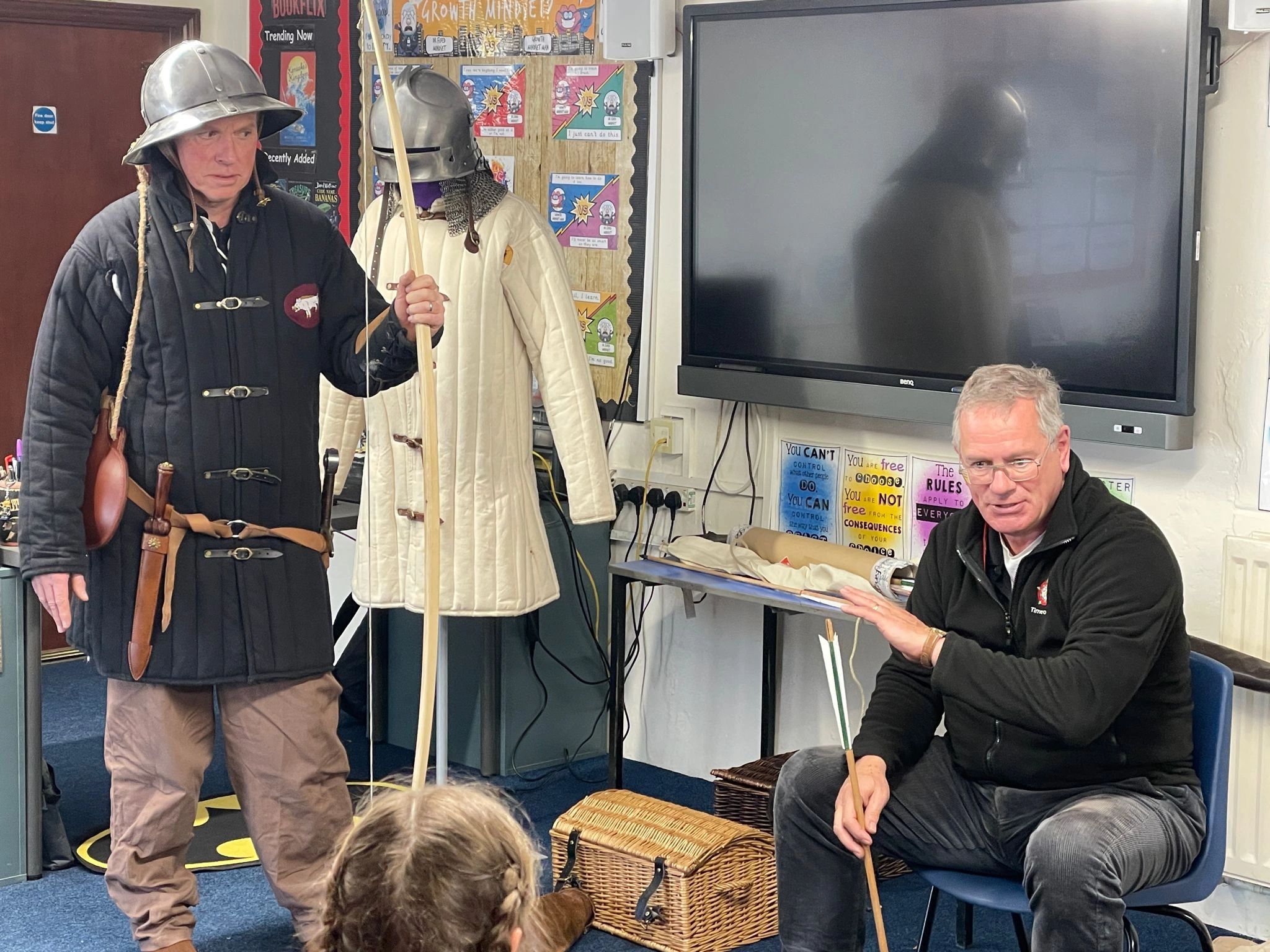
Presentations for schools are very popular. Half or whole day medieval experiences include interactive talks on a range of topics and include artefact handling, stories, activities for participation and plenty of Q & A. Suitable for KS 2 and KS 3 pupils A Level and universities also covered.
The best way to predict the future is to study the past
Visit a selection of historic castles, and some lesser known archaeological sites, in the company of highly qualified and experienced guides
Large castles - small castles - archaeological sites
Combat experiences - learn the skills of a longbow archer and experience the training for hand to hand combat of a medieval knight
Longbow tuition - archery - weapon handling
Guided tours with military experts of two of the most important battles in medieval England
Battle of Tewkesbury 1471 and Battle of Evesham 1265
Reconstruct famous medieval battles as tabletop wargames and try to alter the course of history.
Wargame figures - rules - tables - scenery provided
From the great cathedrals of Worcester, Gloucester and Hereford to historic monasteries, picturesque parish churches and tiny Templar chapels there are numerous examples within easy reach of our location.
Tombs of Kings - the Mappa Mundi - relics and treasures
2024 Events Battle of Tewkesbury 13 July Battle of Evesham 3/4 August
Attendance at these events can be included in your tour
Our team of experts offer a number of interesting courses on medieval themed topics or they can visit your location to give exciting, informative 45 - 90 minute lectures with audience participation.
Courses £55 per person : Lectures from £50 plus travel

We offer a selection of evening activities .
Guest speakers - films - wargames
Some courses are run at the luxurious Verzon House country hotel near the ancient town of Ledbury.
Beautiful rooms - outstanding cuisine - spectacular location
The historic Feathers Hotel is an option for our clients. The beautiful building dates back to Tudor times so very appropriate for history enthusiasts.
Lovely rooms - fine cuisine - centre of Ledbury - pool
White House, Aylton, Ledbury, HR8 2RQ Self Catering Five characterful, listed cottages, nestled in tranquil countryside just 5 miles from Ledbury. Set on the Gloucestershire/ Herefordshire border, it’s the perfect base for exploring the Welsh border castles and historic sites
www.whitehousecottages.com
Copyright © 2024 Timequest Medieval Experiences - All Rights Reserved.
Powered by GoDaddy
- Privacy Policy
This website uses cookies.
We use cookies to analyze website traffic and optimize your website experience. By accepting our use of cookies, your data will be aggregated with all other user data.
- Sign Up For Emails
- Get A Free Brochure

- All Destinations
- England & Wales
- Multi-Destination
- All Travel Types
- Guided Tours
- Guided Small Groups
- Group Travel
- Custom Private Driver
- Independent Adventures
2025 Early Bird Discount
- Last Minute Deals
- 2025 Tours Available
Repeat Guest Savings
Group discount, solo travel.
- Honoring Heroes
- All Travel Deals & Promotions
- The CIE Tours Difference
- CIE Tours Travel Blog
- Guest Reviews
- Responsible Tourism
- Health & Safety
2025 Tours: Save $500pp - Use Code EBD25500
Highlights of Britain
Starting from $4,195
- The Experience
- 14 Days In 2024
- 13 Days In 2025
See more of the beauty of Britain
Trip details.
Tour start London
Tour end London
Available Promotions for this tour
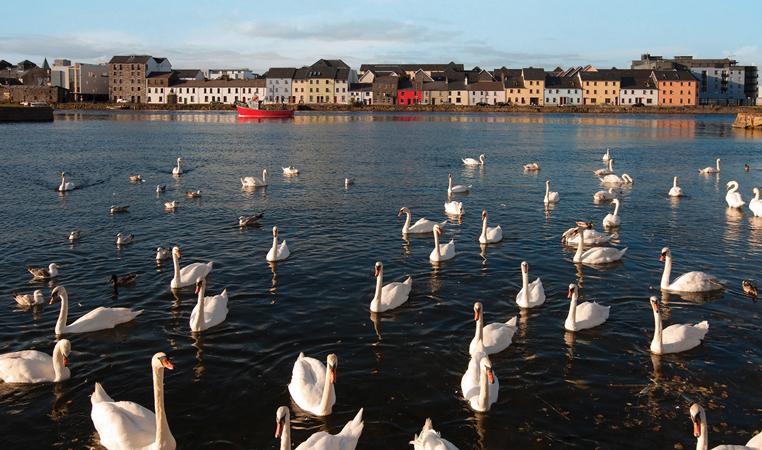
Booking window
01 May 2024 - 31 May 2024

Edinburgh Castle
Walk in the footsteps of soldiers, kings and queens, and even the odd pirate or two, in this medieval-era royal residence, military garrison, prison and fortress, alive with many exciting tales.
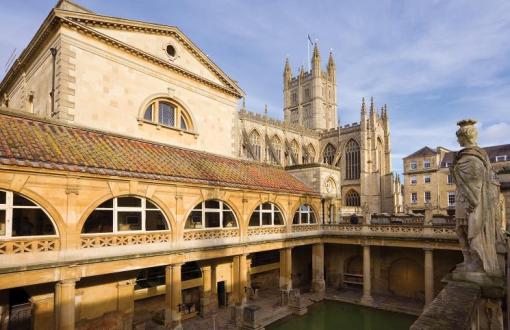
Roman Baths
Discover why these mineral-rich hot springs have been a popular destination for more than 2,000 years.
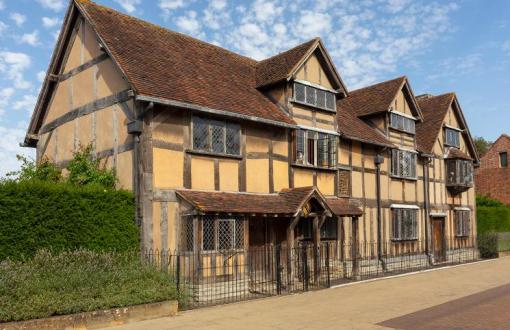
Shakespeare’s Birthplace
Learn all about the life and work of the Bard — and tour his birthplace at Stratford-Upon-Avon.

Cross the modern Tay Bridge to the medieval town of St Andrews, the "Home of Golf”.

York Minster
Marvel at this millennium-old cathedral and its exquisite medieval-era stained glass windows.

Try to uncover the mystery of these massive stone arrangements that date back thousands of years.
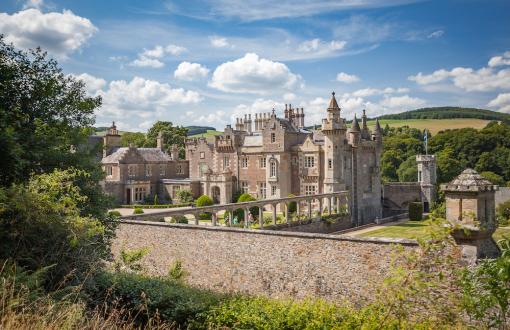
Abbotsford House
Great Scott! Visit the extraordinary home of Sir Walter Scott, the 19th century novelist who popularized tartan and rediscovered the Scottish Crown Jewels.
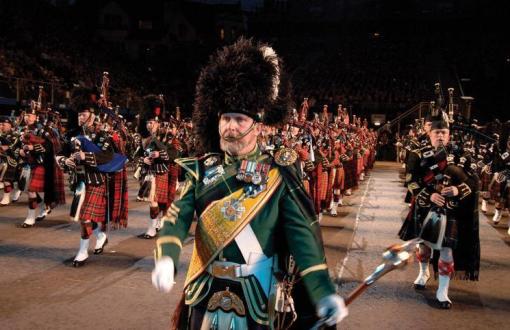
Royal Edinburgh Military Tattoo
Travelers on our July 29th - August 12th departures can watch kilt-clad corps perform with drums and pipes in military precision.
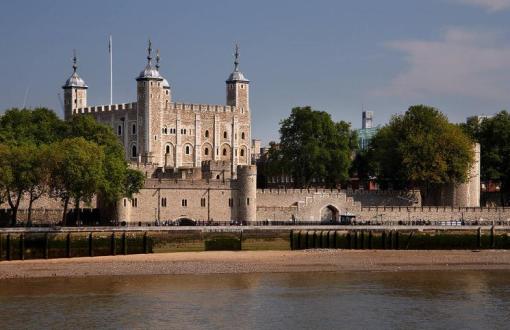
Tower of London
Explore the grand fortress that has served as a royal residence, a prison, an executioner's grounds — and even as a zoo, in its time.

Cardiff Castle
Visit one of the most iconic of the 600 castles that dot Wales' landscape.
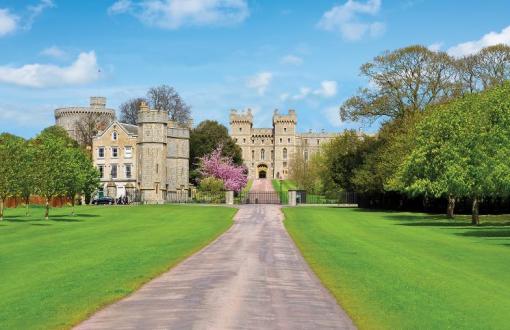
Windsor Castle
Visit the Queen's magnificent home, the longest-occupied palace in all of Europe.

Day 1 London Arrival | Windsor Castle
Day 2 stonehenge | salisbury, day 3 st michael’s mount | st ives, day 4 roman baths | cardiff castle, day 5 hay-on-wye | shrewsbury, day 6 north wales | chester, day 7 lake district | edinburgh, day 8 edinburgh castle | city tour | scottish evening*, day 9 glamis castle | st andrews, day 10 abbotsford house | york, day 11 whitby | castle howard | york minster, day 12 shakespeare’s birthplace | london, day 13 tower of london | city sightseeing, day 14 tour ends in london, where you’ll stay.
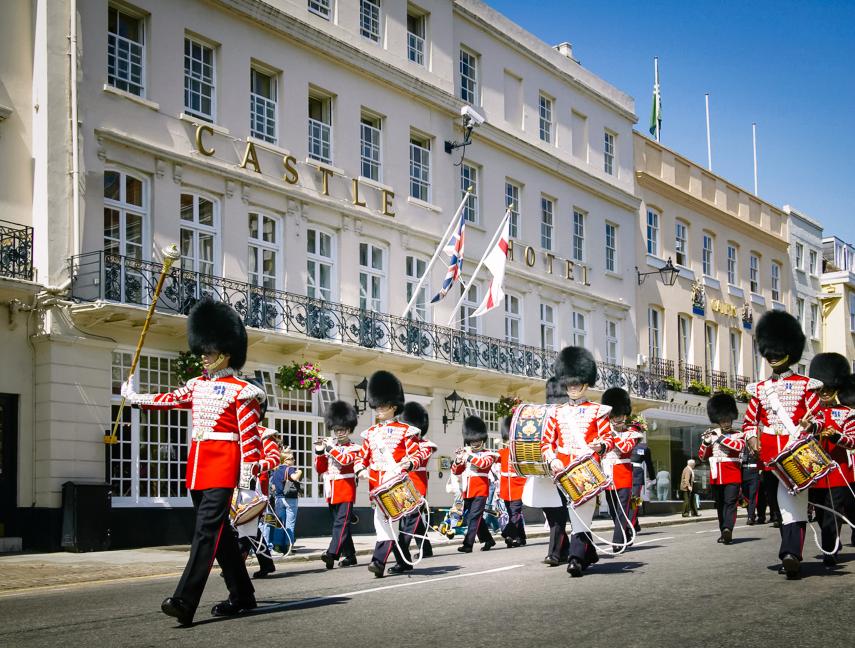
Castle Hotel Windsor Windsor, England
The Castle Hotel, Windsor – MGallery Hotel Collection is a 4 star luxury hotel-based in the heart...
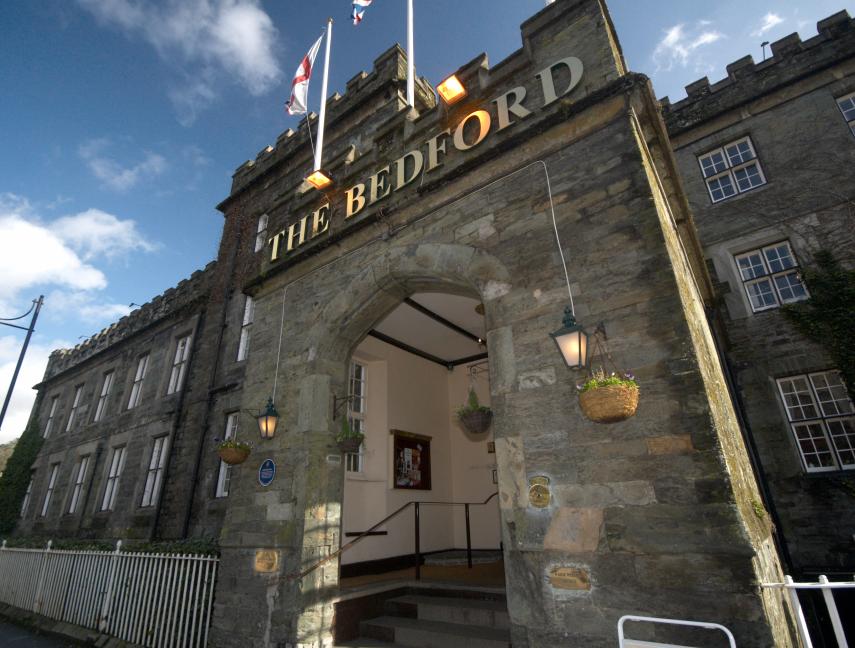
The Bedford Hotel Tavistock, England
The Bedford Hotel is a classic English townhouse hotel in the heart of the award-winning Devon...

Mercure Cardiff Holland House Hotel & Spa Cardiff, Wales
In a prime city center location, this 4-Star luxury hotel has a swimming pool, a gym and a spa....
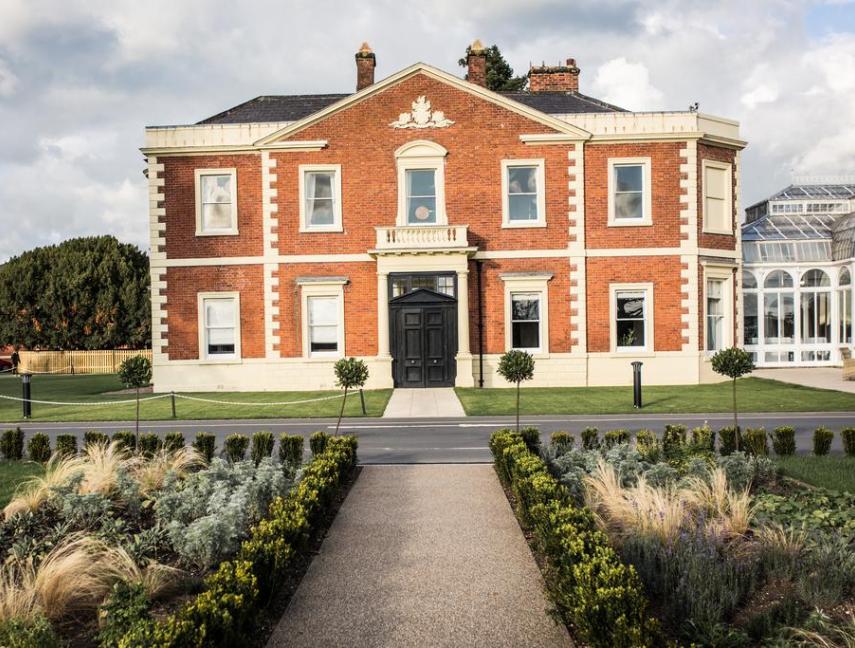
DoubleTree by Hilton Hotel & Spa Chester Chester, England
Featuring a cocktail bar, Doubletree by Hilton Chester is set in an 18th-century manor house with...

Edinburgh Marriott Hotel Holyrood Edinburgh, United Kingdom
Embark on an unforgettable Scottish escape at the Edinburgh Marriott Hotel Holyrood. Nestled amid...
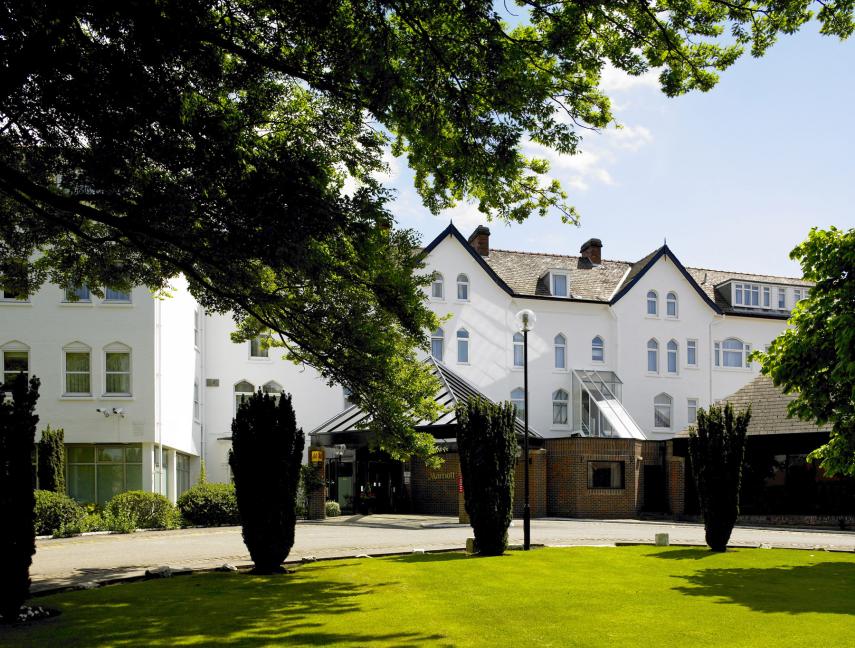
Delta Hotels by Marriott York York, England
The York Marriott Hotel is within a 20-25 minute walking distance of York city centre and its many...
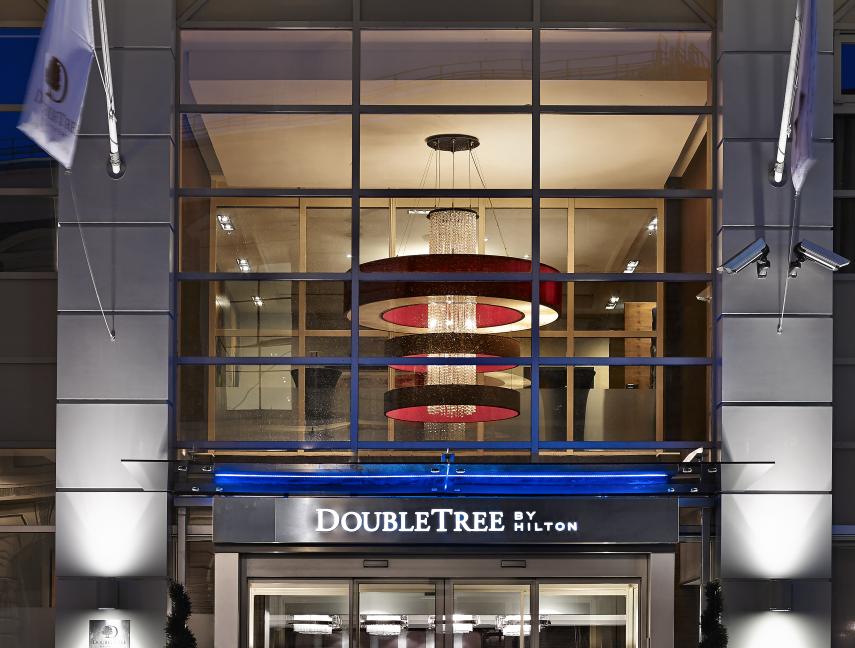
DoubleTree by Hilton Hotel London - Victoria London, England
DoubleTree Hotel London – Victoria offers comfortable guest rooms and suites. Enjoy standard and...
Inclusive package with no hidden extras

What's included?
- Full daily breakfast and many meals*
- Transportation (Buses, shuttles & ferries)
- Welcome drinks with your group
- Free Wi-Fi on luxury coaches
- All entrance fees to attractions
- Comprehensive travel itinerary and documents
*Breakfast is not included on Day 1
Our welcome gift to you
- A travel backpack
- Travel adapter
- Rain poncho
- Luggage strap and tags
- Documents wallet
From our travelers
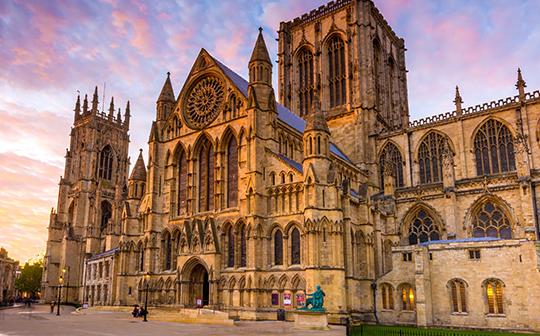
What a fabulous tour! We saw so much of Great Britain! This tour is great! If you have never traveled to GB or traveled overseas, like us, this is the way to do it. Our tour director was so informative, organized and humorous! The bus driver was excellent and so personable. Everything was taken care of for us. No worries...just fun. Our fellow travelers were wonderful. Meals and hotels were excellent. I would definitely recommend this tour. I look forward to taking another CIE tour in the future.
Related Articles

Butter Up Your Friends with Scottish Shortbread
Be the hit of your cookie exchange! Shortbread is perhaps the most iconic Scottish treat - and it's sure to be a hit…

Scotland's Castles: Windows into History
Exploring Scotland’s castles is the best way to learn about its amazing history. Walk in the footsteps of kings, queens…

Recipe: Eve's Pudding
When we think of fall, we think of crisper temperatures, colorful leaves, and apples at the farmer's market. Here's a…

Castle Hotel Windsor, Windsor
The Castle Hotel, Windsor – MGallery Hotel Collection is a 4 star luxury hotel-based in the heart of Windsor town centre sitting magnificently opposite the Windsor Castle and Windsor Guildhall. Boasting unrivalled views of the 'Changing of the Guards' procession which marches past the doorstep of the hotel along Windsor’s picturesque main street. A beautiful range of boutique accommodation is available at Castle Hotel ranging from charming single rooms to spacious luxury suites with spectacular views over Windsor and it’s many landmarks. Each room follows the flowing Georgian elegance of the hotel which have been beautifully decorated with a refined take on contemporary design. Complimentary accessories including White Company Noir toiletries, fluffy bathrobes, and for upgraded rooms, personal Nespresso machines are provided so that guests can truly relax during their stay. Whether it’s a boutique break, romantic getaway, wedding, or business trip, rooms are certain to delight and impress.
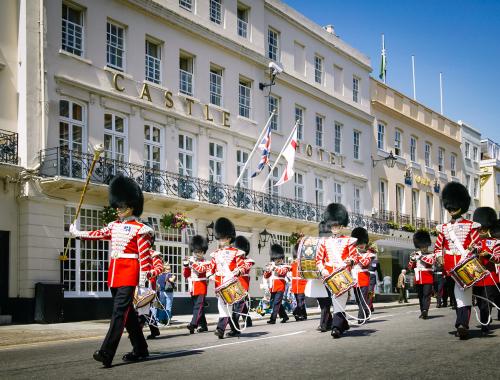
Castle Hotel, Windsor - MGallery Hotel Collection
- 24-hour Front Desk
- Coffee Shop
- Disabled Facilities
- Dry Cleaning
- Laundry Facilities
- Wifi in Public Areas (Complimentary)
- 24-hour Room Service
- Air Conditioned
- Cable/Satellite Television
- Coffee & Tea-making Facilities in Room
- Complimentary Bottled Water
- Daily Maid Service
- In-Room Wifi (Complimentary)
- Iron/Ironing Board
- Luggage Racks
- Private Bathroom
- Room Service
- Work Desk & Lamp
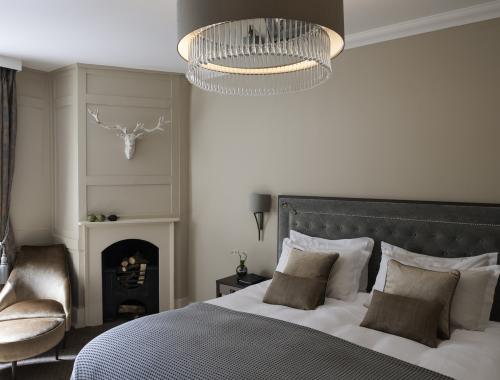
The Bedford Hotel, Tavistock
The Bedford Hotel is a classic English townhouse hotel in the heart of the award-winning Devon town of Tavistock, and offers characterful, individually-styled rooms, and an award-winning restaurant showcasing the finest local ingredients. The town itself it a joy to explore, with many fascinating heritage sites, a pretty riverside walk, and a range of quality individual shops.
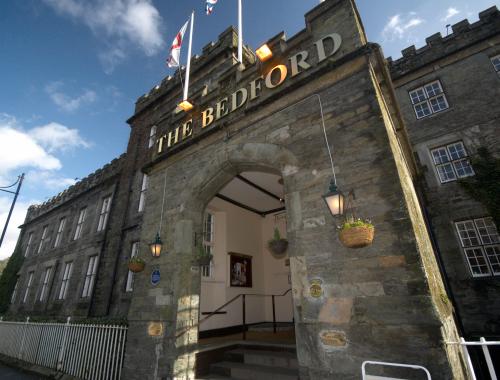
Bedford Hotel
- Alarm Clock
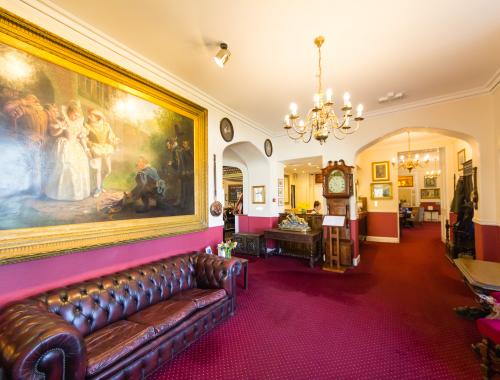
Entrance Hall
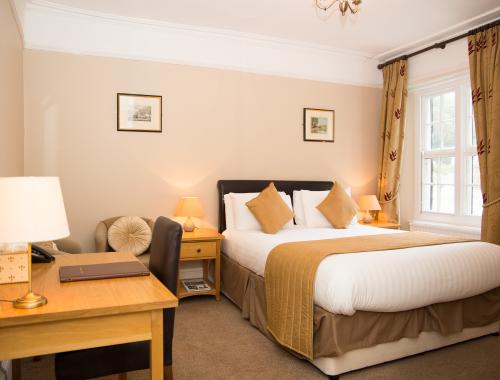
Mercure Cardiff Holland House Hotel & Spa, Cardiff
In a prime city center location, this 4-Star luxury hotel has a swimming pool, a gym and a spa. The main shopping district is a 5-minute walk away. There is free Wi-Fi throughout. Guests can enjoy a stylish lounge bar, and an award-winning restaurant with a modern menu. The superb leisure club includes a Jacuzzi, a sauna, a steam room, and an aerobics and fitness studio. It is a 5-minute drive to Cardiff Bay, where you will find a selection of restaurants and bars on the waterfront.

Mercure Cardiff Holland House Hotel & Spa
- Fitness Center
- Swimming Pool

DoubleTree by Hilton Hotel & Spa Chester, Chester
Featuring a cocktail bar, Doubletree by Hilton Chester is set in an 18th-century manor house with 12 acres of landscaped gardens. Free Wi-Fi and on-site parking are provided. The spa features 2 swimming pools and a gym. Guests can relax in the aroma steam room, glass-fronted sauna or hot tub, and indulge in treatments in the candlelit beauty rooms. Each of the 4-star bedrooms has a flat-screen LCD TV. All rooms feature a private bathroom with quality toiletries, air conditioning and a work desk.
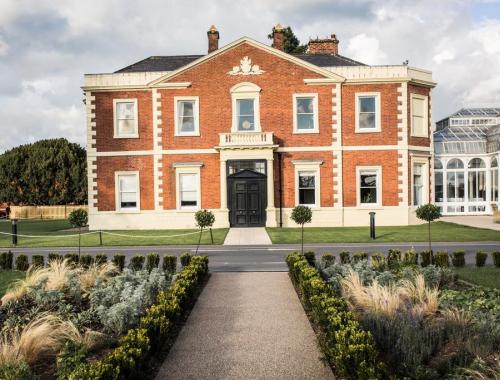
DoubleTree by Hilton Hotel & Spa Chester Front Entrance
- Business Center
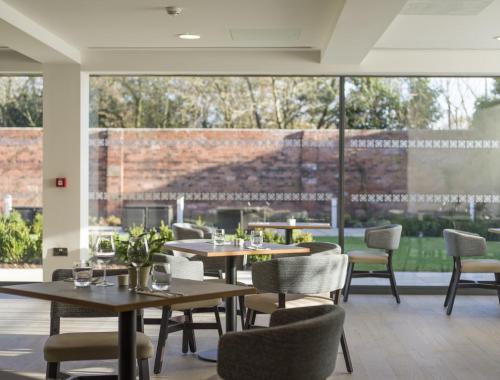
Dining Lounge

Deluxe Double Room
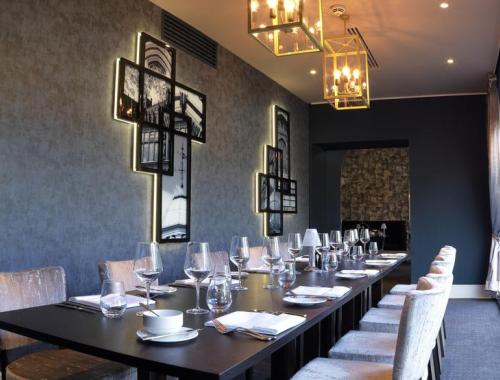
Edinburgh Marriott Hotel Holyrood, Edinburgh
Embark on an unforgettable Scottish escape at the Edinburgh Marriott Hotel Holyrood. Nestled amid Edinburgh's historic wonders, this refined haven seamlessly blends modern luxury with traditional Scottish hospitality. Enjoy spacious rooms and suites offering sweeping views of Holyrood Park and Arthur's Seat, then unwind in style with a dip in the hotel's heated indoor pool. Indulge in delectable Scottish fare at the acclaimed restaurant, or savor fine whiskies at the cozy bar. With its prime location near iconic attractions like the Royal Mile and Palace of Holyroodhouse, the Edinburgh Marriott Hotel Holyrood promises an unforgettable Scottish adventure.

Edinburgh Marriott Hotel Holyrood
- Mini Refrigerator

Standard King

Standard Twin

Standard Double
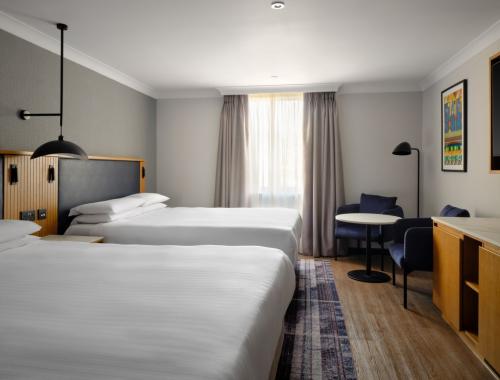
Deluxe Double Double

Deluxe King

Junior Suite

Club King Room

Delta Hotels by Marriott York, York
The York Marriott Hotel is within a 20-25 minute walking distance of York city centre and its many attractions including the National Railway Museum & York Minster. Our Leisure Club features a heated pool, sauna, steam room, spa bath, gymnasium & private tennis court. The Cast Iron Bar & Grill serves a varied menu and offers a wide choice of refreshments whilst offering unrivaled views of York Racecourse from its sun terrace.
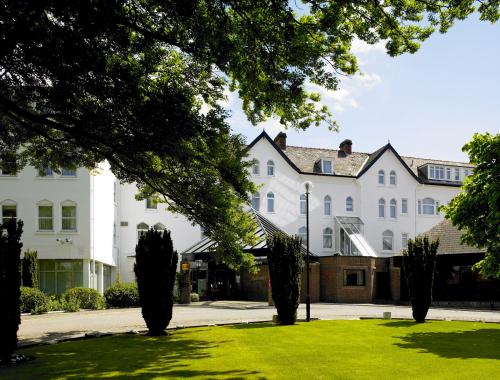
York Marriott
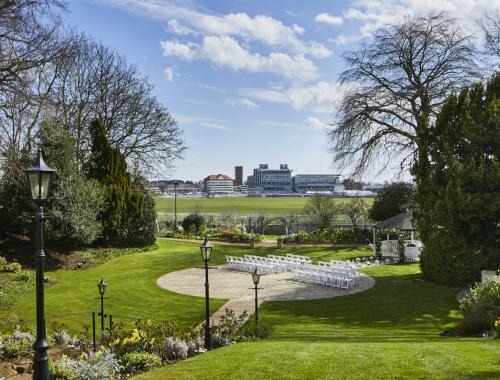
DoubleTree by Hilton Hotel London - Victoria, London
DoubleTree Hotel London – Victoria offers comfortable guest rooms and suites. Enjoy standard and deluxe rooms with generous work surfaces, plush beds and flat-screen TVs. Our premium deluxe rooms are located on the top floors, offering complimentary amenities and boasting stunning views over London.
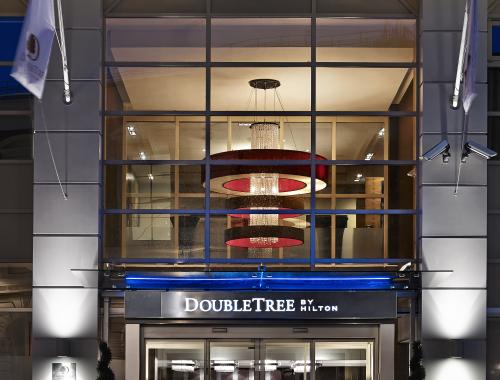
DoubleTree by Hilton Hotel London - Victoria

Premium Deluxe Room
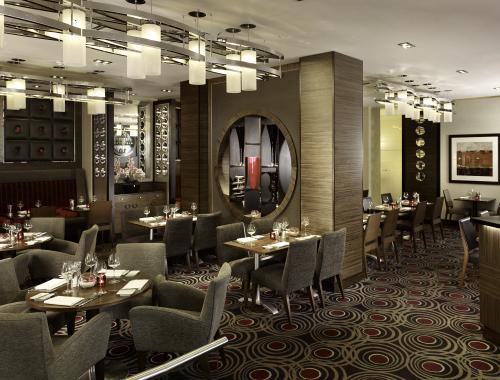
2 Bridge Place Restaurant
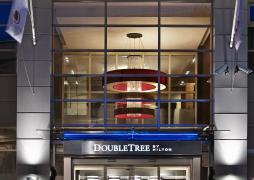
See what people are saying about this trip
Cie tours customer, previous travel with cie. was excellent with everything.
Enjoy seeing. different places. that had not. seen. before from previous trip. I did with CIEWould. Strongly recommend to people to travel with
Amazing Trip With A Few Hiccups Along the Way
This is my 3rd trip with CIE and there’s a reason why I keep coming back. I chose this itinerary due to the locations that we’d be going (some I’ve done with my last CIE tour and wanted to experience the city again) as well as some of the activities being offered. However once again at the airport it took me a while to find the driver from the airport to the hotel on the day of arrival. This is the second tour in the UK where this has happened and both times I’ve had to contact the company in charge of the driving company to either get a new driver and or find my driver. At this point if I do another tour starting in London I’d rather take my chances with a taxi and or the tube. Another issue was the fact that I had chose this tour due to the Day 11 activities which included the train ride from Goathland Station. It wasn’t until we arrived at our hotel on Day 10 that we were informed that we weren’t doing the train which is one of the main reasons why I had chose this specific tour. On route to Whitby we were told by our tour director that the change to the itinerary had been made in May but nobody on the tour had been made away and instead we went to Castle Howard. For the itinerary, I feel like this one should/needs to be more time in Cardiff. This was my second time there and with this tour I feel like Cardiff Castle shouldn’t be the only place that’s explored in the capital city besides the castle. In Hay-on-Wye we should have more time than an hour, seeing as some of the stores were still closed.
History, Castles, Beachside towns and the English Countryside, loved it all
So much to see and learn. It was a great to experience all the different areas of England. The history, scenery and hospitality was exceptional.
CIE took care of everything, all we needed to do was show up.
12 full days wasn't long enough have to go back and do it all again...
All location stops and attractions visited were worth it and even though the weather wasn't always the best our guide and drive made up for it with commentary and scenic drives.
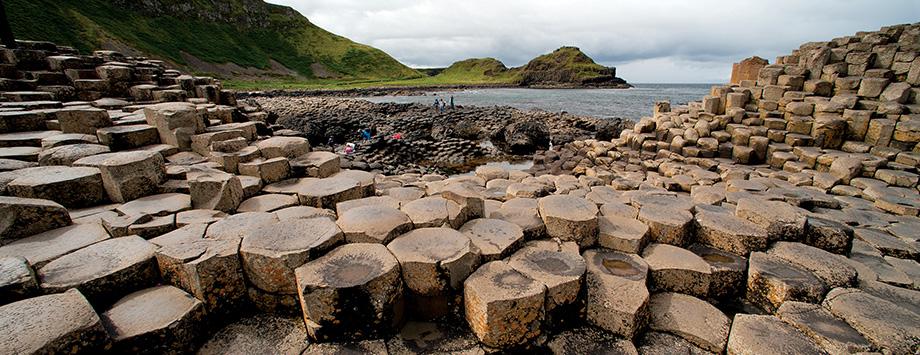
How can we help you?

The Inclusive Advantage
Get more without spending more. CIE Tours includes every experience and most meals so you won't be hit with hidden expenses.
This website may ask your browser to store cookies. See our Cookies Policy for more information about our use of cookies.
- site navigation
- main content
- +44 (0)20 8742 3355 +44 (0)20 8742 3355
- [email protected]
- +44 (0)20 8742 3355
The Cathedrals of England - Ely, Lincoln, Durham, York, Coventry, Gloucester, Bristol, Wells, Salisbury, Winchester
A study of England’s greatest buildings – their history, architecture, sculpture, stained glass and current life.
Built between the Norman Conquest and Henry VIII’s Reformation, with Coventry Cathedral a moving exception.
An organ recital exclusively for us, and many other special arrangements.
Print itinerary (2024)
Print itinerary (2025)
25 Sep - 03 Oct 2024 £3,290 Book this tour
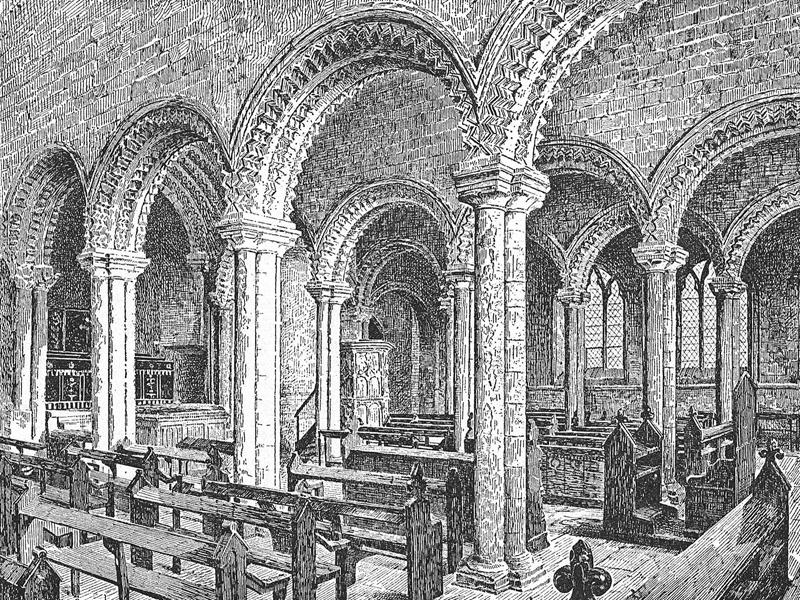
- Expert lecturer
- Practicalities
- Testimonials
This is an architectural journey that would be hard to equal for intensity of aesthetic delight and as a way into the minds and lives of the people of the Middle Ages it would be difficult to surpass. Personalities of extraordinary capability and vision will be discovered, and the thought processes and techniques used by craftsmen of genius revealed and decoded.
The tour ranges across England – north, south, east and west – to see some of the most glorious medieval architecture to be found anywhere. Connoisseurs may carp at the omissions, but logistics exclude only a couple of cathedrals of comparable beauty, magnificence and interest. With an average of little over one cathedral a day, there is plenty of time to really get to know, assimilate, appreciate and contemplate each one.
All but one are medieval, Norman (as Romanesque is generally called in Britain) and Gothic. It is easy to underestimate the length of time the Middle Ages encompasses: the span from the earliest work we see on the tour to the latest, from the Norman Conquest to the Reformation, equals that from the Reformation to the present day. There was huge variety in the building arts and historical circumstances during those 460 years. The one non-medieval cathedral on the itinerary is Coventry. Rebuilt after the Second World War, not only is it a treasure house of mid-twentieth-century art but it is a moving monument to rebirth and reconciliation.
There are many special arrangements to enable you to see more than most visitors and there are opportunities to hear some excellent choirs at Evensong. Cathedrals come with cities, and many of these were relatively little changed during the era of industrialisation and now rank among the loveliest in England. Much beautiful countryside is traversed as well.
Ely. The coach leaves King’s Cross, London at 9.30am for Ely, a surprisingly remote and rural location for one of England’s greatest cathedrals. The mighty Norman nave and transepts (c. 1110–30), with their thick walls, tiers of arches and clusters of shafts, leads to the crossing and its unique 14th-century octagonal lantern, a work of genius. The detached Lady Chapel, also in the Decorated style, is the largest and perhaps the finest in the country; the Early English quire a ravishing setting for the lost shrine to St Etheldreda. Overnight Lincoln.
Lincoln. Also largely by-passed by modern urban development, Lincoln’s hilltop site above the broad Witham valley renders this enormous cathedral even more imposing. Largely rebuilt from 1192, it has always been revered as one of the finest of Gothic cathedrals, its fascinations enhanced by myriad minor inconsistencies and variations which reveal the struggle for solutions at the frontiers of artistic fashion and technological capability. The steep streets of the ancient town are a delight. First of three nights in York.
Durham. Massive towers rise above the trees which cling to the steep embankment, a defensible bulwark in the frequently hostile North. Largely completed in the decades from 1093 and little altered since, the nave and quire with their great cylindrical pillars, distinguished by their engraved patterns, constitute one of the world’s greatest Romanesque churches.
York. York Minster is the largest of English medieval cathedrals. Above ground it is all Gothic, from Early English to Perpendicular but predominantly 14th-century, demonstrating an exceptional knowledge of the latest French Rayonnant ideas. It is a treasure trove of original stained glass, and the polygonal chapter house is without peer. The city retains its medieval walls and an exceptional quantity of historic buildings.
Coventry. Coventry Cathedral is perhaps internationally Britain’s best-known 20th-century building. Built to designs by Sir Basil Spence beside the ruins of its predecessor, destroyed in 1940, it is both a showcase for some of the best art of the time (Graham Sutherland, John Piper, Jacob Epstein). In the evening, a walk through Stratford-upon-Avon, which has retained many buildings Shakespeare would have known. Overnight Stratford.
Gloucester, Bristol. The procession of tall cylindrical pillars in Gloucester’s nave is unadulterated Norman, but, following the burial of Edward II in 1327, the eastern parts are exquisitely veiled in the first large-scale appearance of Perpendicular architecture. The east window, which retains its medieval stained glass, is one of the largest in Europe. Bristol cathedral is a much-overlooked gem with fine work of every era, from the lavishly patterned walls of the Romanesque chapter house to G. E. Street’s great Victorian nave. But its highlight is the east end, among the most innovative and beautiful of early 14th-century buildings. First of two nights in Wells.
Wells. An exceptionally unspoilt little city, Wells has a fortified bishop’s palace, 14th-century houses of the Vicars Choral and much else of charm and interest. The cathedral was one of the first in England to be built entirely in Gothic style. Its screened west front, eastward march of the nave, sequence of experimental contrasted spaces of the Decorated east end, serene chapter house and Perpendicular cloisters all contribute to the cathedral’s exceptional allure. The strainer arches supporting the sagging tower are among the great creations of the Middle Ages.
In 2024: Salisbury. One of the most uplifting experiences in English architecture, Salisbury is unique among the Gothic cathedrals in England in that it was built on a virgin site and largely in a single campaign, 1220–58. To homogeneity are added lucidity of design and perfection of detail. Completed a century later, the spire at 404 feet is the tallest medieval structure in Britain. The close is the finest in the country, and the town beyond has an extensive expanse of historic fabric. Overnight Winchester.
In 2025: Old Sarum, Salisbury. Old Sarum is an Iron Age hillfort, though from ad 1066 to c. 1220 it flourished as a Norman stronghold with castle, palace and cathedral. There are fine views across Salisbury, the city which replaced it. One of the most uplifting experiences in English architecture, Salisbury is unique among the Gothic cathedrals in England in that it was built on a virgin site and largely in a single campaign, 1220–58. To homogeneity are added lucidity of design and perfection of detail. Completed a century later, the spire at 404 feet is the tallest medieval structure in Britain. The close is the finest in the country, and the town beyond has an extensive expanse of historic fabric. Overnight Winchester.
Winchester. Winchester Cathedral is one of Europe’s longest churches, reflecting the city’s status intermittently from the 9th to the 17th centuries as a seat of English government. The transepts are unembellished early Norman (1079), raw architecture of brute power, whereas the mighty nave was dressed 300 years later in suave Perpendicular garb. The profusion of chantry chapels constitutes an enchanting collection of Gothic micro-architecture. Wall paintings, floor tiles, the finest 12th-century Bible. Return to Tothill Street in central London by 4.00pm
Dr Hugh Doherty
Lecturer in medieval history at the University of East Anglia. He was taught at the Universities of London, Cambridge, and Oxford, and was a research fellow at Jesus College, Oxford. He specialises in the period, 700–1200, and publishes on western kings, secular élites and their records. He is a keen believer in the value of exploring and understanding the architectural fabric, material culture and landscapes of the past.
Price, per person
In 2024. Two sharing: £3,290. Single occupancy: £3,730.
In 2025 . Two sharing: £3,490. Single occupancy: £3,950.
Hotel accommodation; private coach throughout; breakfasts, 1 lunch and 6 dinners with wine, water, coffee; all admissions and donations; all tips; the services of the lecturer and tour manager.
Accommodation
The Castle Hotel , Lincoln: 4-star historic building close to the cathedral. The Grand , York: the former headquarters of North Eastern Railway, the hotel retains many original features. The Arden Hotel , Stratford-upon-Avon: a comfortable, 4-star, waterside hotel situated opposite the RSC theatres. The Swan , Wells: 3-star, in a building of 15th-cent. origin in a narrow street close to the cathedral. Hotel du Vin , Winchester: a 4-star, 18th-cent. hotel located in the city centre. Rooms at all the hotels, being city-centre historic properties, vary in size and outlook. Single rooms are doubles for sole use throughout.
How strenuous?
There is quite a lot of walking on the tour. You ought to be able to walk at about three miles an hour for up to half an hour. There are also a lot of steps and uneven surfaces. Roof and tower visits are optional of course, but at Salisbury there are 332 stairs to climb. Four out of the five hotels do not have lifts. Average distance by coach per day: c. 73 miles.
Are you fit enough to join the tour?
Between 10 and 22 participants.
Combine with
In April/May 2024:
Decorative Arts of Iberia , 8–20 April 2024
Extremadura, 11–20 April
Essential Jordan, 13–21 April
Pompeii and Herculaneum , 15–20 April
William Howard & The Carducci String Quartet , 19–21 April
Civilisations of Sicily , 6–18 May
Salzburg String Quartet Festival, 7–12 May
Two Spains: The Spanish Civil War & its Aftermath , 8–16 May
In September 2024:
Civilisations of Sicily , 9–21 September
Albania: Crossroads of Antiquity, 11–20 September
Morocco , 11–22 April
West Coast Architecture, 13–23 September
Gastronomic Emilia-Romagna , 14–20 September
Dark Age Brilliance , 15–22 September
Ancient Rome , 16–21 September
Walking a Royal River , 16–22 September
Footpaths of Umbria , 16–23 September
Historic Musical Instruments , 17–20 September
In October 2024:
Courts of Northern Italy , 4–11 October
Basilicata & Calabria , 4–12 October
Malta: prehistoric to present, 7–13 October
The Douro , 8–15 October 2024
Gardens & Villas of the Italian Lakes , 10–16 October
Gastronomic Puglia , 10–16 October 2024
Berlin, Potsdam, Dresden , 10–18 October
In April/May 2025:
Val D’Orcia and the Sienese Hills, 10–16 April
Courts of Northern Italy , 2–9 May
The Ligurian Coast , 3–9 May
Istanbul Revealed , 4–11 May
Palladian Villas , 6–11 May
In September 2025:
Cave Art of France , 3–10 September
Samarkand & Silk Road Cities , 4–16 September
Frank Lloyd Wright, 5–15 September
Courts of Northern Italy , 5–12 September
Essential Andalucía , 29 September–9 October
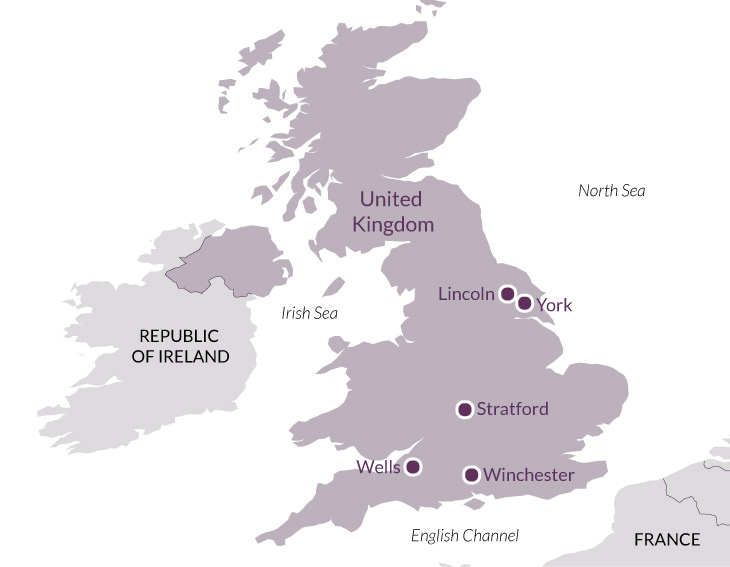
'The lecturer was excellently prepared and communicated vast learning with charm and a light touch.'
'The itinerary was enriching. The whole experience was rich and coherent.'
'This was my first experience with Martin Randall. You met and exceeded all my expectations. I could not have been more pleased.'
'The lecturer was an unbelievably knowledgeable, enthusiastic and affable tour leader. He was a consummate teacher who made the complexity of the history, geography and structure of the cathedrals both interesting and accessible. We were constantly enthralled.'
You may also be interested in...
The hanseatic league cities and abbeys of germany’s baltic coast.
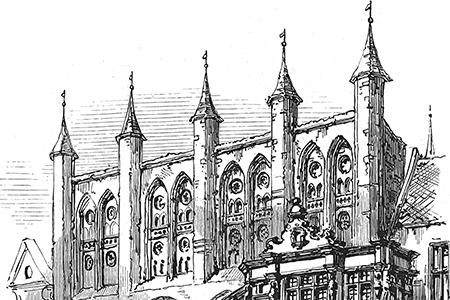
Istanbul Revealed Byzantine & Ottoman metropolis
Belgian modern masters ensor, magritte and fellow individualists.

Whitehall Architecture & history
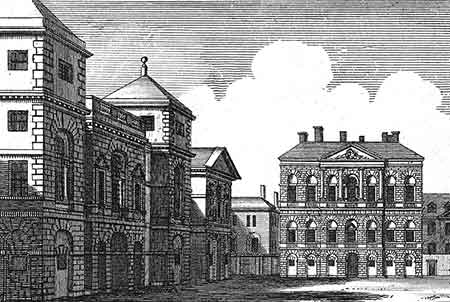
You are using an outdated browser. Please upgrade your browser or activate Google Chrome Frame to improve your experience.

May 7 – 16, 2022

WILLIAM MARSHAL TOURS TAKES YOU
On a journey to the medieval past.
William Marshal was one of the greatest knights who ever lived.
CUSTOM MEDIEVAL HISTORY TOURS
Immersive, signature experiences, passionate about history & travel, what our clients are saying about us, angela a. from brisbane, sherill r. from oregon, mary y. from wisconsin, amazing tours.

Accommodation preferences:
Shared Room Package - $4,995 USD PER PERSON Private Room Package - $5,995 USD PER PERSON
Payment preferences:
Pay in Full - $595 USD deposit + remaining balance by Dec 31, 2017 Payment Plan - $595 USD deposit + 3 payments by Mar 9, 2018
Shared Room Package - $4,995 USD Private Room Package - $5,995 USD
Pay in Full - $595 USD deposit + remaining balance by Dec 31, 2018 Payment Plan - $595 USD deposit + 3 payments by Apr 2, 2019
Rated 98% based on 1029 reviews

UK 0345 475 1815 USA (toll free) 877‑209‑5620 International 00 44 345 475 1815 [email protected] Rated 98% on feefo
Sign-in Latest News Subscribe Request Brochure
- Future Planning
- Military History and Battlefield Tours
- Classical History and Archaeological Tours
- Holocaust Tours
- General History Tours
- Experience Tours
- Walking Tours
- Early Periods
- 17th & 18th Century
- Victorian Era
- First World War
- Second World War
- Cross-Periods
- Destinations
- Our Expert Historians
- Historians Q&A
- Historical Tailor Made Tours
- School Tours
- Battlefield Studies
- Testimonials
- What to Expect
- Activity Levels
- Tour Diaries & Images
- Our Library
- Frequently Asked Questions
- Work For TCE
- General Booking Conditions
- Download Booking Form
- Tours by Date
- Tours by Theme
- Tours by Period
- Tours by Destination
- Latest News
- Request Brochure
Medieval Battlefield Tours
To keep them topical we tend to schedule these tours to coincide with anniversaries of the event concerned – and thus tie in with re-enactments and concurrent publications and documentaries on the subject. We've previously celebrated the battle of Bannockburn and the emergence of Scottish national identity to coincide with the battle and the Scottish Referendum debate.
All of our forthcoming Scheduled Medieval Tours are listed below.

view all periods
Medieval Tours - Future Planning
We intend to run all of the following tours in the near future. Final dates and prices are yet to be confirmed. Register your interest and we will contact you as soon as these tours become available.

Subscribe to Our E-Newsletter
For up to date news as well as details about all of our tours please subscribe to our fortnightly e-newsletter

Quick Links
Military History and Battlefield Tours Classical History and Archaeological Tours Holocaust Tours General History Tours Experience Tours Walking Tours Future Planning Request Brochure Site Map
The Cultural Experience 11B Mansfield Park Four Marks Alton GU34 5PZ United Kingdom
UK: 0345 475 1815 USA (toll free): 877 209 5620 International: 00 44 345 475 1815
© 2015 - 2024 Midas Tours Ltd - Hosted by SWD - Legal Info - Terms of Use - Privacy Policy / Cookies - Sign-in

Sign Up Today
Start your 14 day free trial today
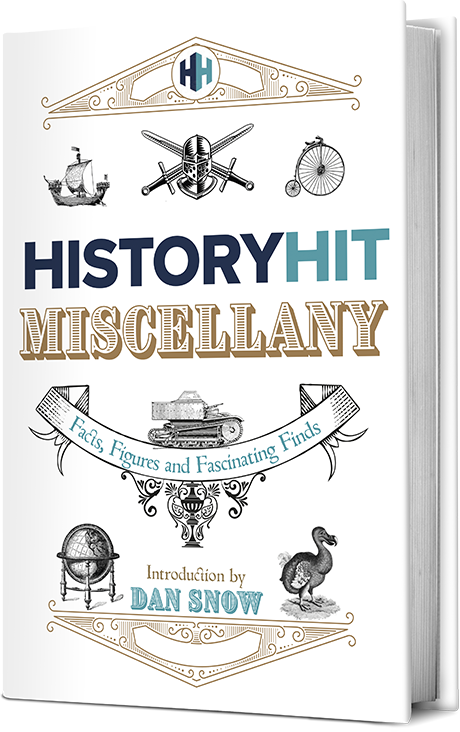
The History Hit Miscellany of Facts, Figures and Fascinating Finds
10 Must-See Medieval Landmarks in England
Discover the rise and fall of medieval britain at these atmospheric sites..

Peta Stamper
04 apr 2023.
England boasts a huge variety of medieval landmarks that all play their part in telling the story of Anglo-Saxons and the Norman Conquest, right through to the fall of the Plantagenet kings – there are just too many fantastic medieval sites to mention.
However, featuring the iconic Westminster Abbey that has seen the rise and fall of notable English monarchs, to the streets that ordinary folk would have hurried along in Medieval Rye, we’ve selected 10 top spots that are guaranteed to transport you back to England’s medieval past.
History Hit Holidays

Rediscovering Richard III With Matt Lewis

1. Medieval Rye
Rye is a historic port town in East Sussex, England, that was an important member of the Cinque Port Confederation during the medieval period. The name Rye comes from ‘ rie ’ meaning bank or the West Saxon ‘ ieg ’ meaning island, as the town was once entirely surrounded by sea.
Rye’s ties to the sea have coloured its long history with shipbuilding, royal visits, thriving trade and violent smuggling. Notorious locations include a Norman church, The Mermaid Inn, The Olde Bell Inn and the Ypres Tower, all open to visitors today.

2. Wells Cathedral and Medieval Centre
Often described as England’s smallest city, Well owes its medieval city status to its beautiful 13th century cathedral. In area and population, Wells is in fact not the smallest city in England – that title goes to the City of London.
However, its size does not diminish the large historical legacy of Wells. Named for the 3 wells dedicated to Saint Andrew, the city grew from a Roman settlement into the Anglo-Saxon period when King Ine of Wessex founded a church there in 704. Wells has since been notable for its cloth-making and role in both the English Civil War and Monmouth Rebellion.
Today, the medieval architecture has led Wells to be a popular filming location. You can tour Wells Cathedral, the “most poetic of the English Cathedrals”, before wandering the picturesque medieval streets.

3. Westminster Abbey
Westminster Abbey is an iconic medieval structure and the site of many historic royal and national events, from coronations and royal weddings to burials and even deaths. Centrally located in London, Westminster Abbey was first constructed in the 11th century by King Edward the Confessor, a Saxon king who dedicated this new church to St Peter.
To have an informed visit and to see the most interesting parts of Westminster Abbey, take a tour, as just wandering around can be overwhelming. Along with Westminster Palace and Saint Margaret’s Church, Westminster Abbey is a UNESCO world heritage site.

4. Norwich Guildhall
Within the heart of the medieval city of Norwich in England, Norwich Guildhall is a remarkable example of late medieval architecture and reflected the growing power of the city’s merchant elite.
Today, the Norwich Guildhall is the largest remaining civic building outside of London and is open to the public.
Norwich Guildhall’s characteristic flint exterior remains a bastion of the city’s medieval independence and wealth, sat on Gaol Hill. The Grade I listed building is open for booking free guided tours which last about an hour, or you can explore the guildhall history on one of the Heritage Open Days, run every September.

5. Rievaulx Abbey
Rievaulx Abbey was a Cistercian abbey in Rievaulx near Helmseley in the North York Moors, England. One of England’s great abbeys, Rievaulx was seized during the dissolution of the monasteries in 1538.
The wider site has since been awarded Scheduled Ancient Monument status and the striking ruins of the main abbey continue to be a popular tourist destination, owned and managed by English Heritage. The abbey’s records also provide one of the earliest insights into queer relationships during the medieval period.

6. Rochester Castle
One of the best-preserved Norman fortifications in England, Rochester Castle was built at a strategic crossroads in the years following the Norman Conquest.
In 1087 Gundulf, Bishop of Rochester began the construction of the castle to command an important river crossing. One of William the Conqueror’s greatest architects, Gundulf was also responsible for the Tower of London. Much of what remains of the walled perimeter remains intact from that time.
In 1215, garrisoned by rebel barons, the castle endured an epic siege by King John. Rochester Castle played no role in the Civil Wars and so it was never slighted. It appears, however, that a violent fire took place in the keep before the 1660s, which reduced the building to ruin.
Today the castle has been largely restored and is open to visitors under the custodianship of English Heritage.

7. St Michael’s Mount
St Michael’s Mount is a small tidal island in Cornwall’s Mount’s Bay, England, and is linked to the town of Marazion by a man-made causeway only passable at mid or low tide. Since 1650, the medieval castle and chapel complex has been the home of the St Aubyn family, although today, the island is jointly managed by the St Aubyns and the National Trust.
St Michael’s Mount was likely an earlier monastery, but was gifted by Edward the Confessor to the Benedictine order of Mont Saint-Michel (the French order that was later dissolved by Henry V) in the 11th century. The Mount was captured on behalf of Prince John in 1193 – during the reign of his brother King Richard I.
In 1424, the chapel was given to the Abbess and Convent of Syon in Middlesex, ending the island’s connection with the French Benedictines. Nonetheless, the Mount remained a popular destination for pilgrims and the castle was built on top of the island around the same time.
St Michael’s Mount continues to weather the tides of time so that visitors can still explore parts of the island and castle.

8. Orford Castle
Orford Castle in Suffolk is a striking medieval castle once used to assert royal authority in the area. With its keep still largely intact, it provides an intriguing look into the world of medieval Britain. Orford Castle was originally built in 1165 under the orders of King Henry II, and was an impressive fortified stone structure surrounded by a curtain wall and several defensive mounds.
In 1189 the castle passed to Henry II’s son Richard I, also known as Richard the Lionheart, and when he was captured upon his return from the crusades, his mother Eleanor of Aquitaine assembled a fleet at Orford to deliver the ransom for his release.
Whilst much of Orford Castle has since been destroyed or eroded, the polygonal five-storey tower is extremely well-preserved and offers visitors a great insight into the history of this vital stronghold.

9. Battle Abbey and Battlefield
Battle Abbey and Battlefield is the site on which the decisive Battle of Hastings took place in October 1066. It now holds the ruins of the Norman abbey built shortly after the battle, as well as a modern visitor centre detailing the site’s significant place in history.
The Battle of Hastings in 1066 was one of Britain’s most important historical events, following which William, Duke of Normandy – largely known as William the Conqueror – was crowned King of England.
In 1090, Pope Alexander II ordered the Normans to do penance for all the lives taken during their conquest of England, following which William vowed to build an abbey to commemorate the fallen dead.
Today Battle Abbey is managed by English Heritage and features a museum exploring William the Conqueror’s victory at Hastings, the events that led up to it, and its aftermath.

10. High Bridge
High Bridge in Lincoln, England, is a medieval bridge that carries the High Street across the River Witham. It is the oldest bridge in the United Kingdom still to have buildings on it, and having stood since the 12th century, today is a Grade I listed building and scheduled monument.
High Bridge was originally built in 1160 AD with a bridge chapel on the side, dedicated to the murdered Archbishop of Canterbury, Thomas Becket, in 1235 although later removed in 1762. Bridge chapels were commonly-used medieval sanctuaries for travellers, although few remain in England today. The bridge saw the addition of its characteristic timber-framed shops from around 1550, similar in style to London Bridge.
Today, the medieval stone arched bridge continues to cross the River Witham, one of only 3 remaining bridges with buildings on it (the others are Pulteney Bridge in Bath and Frome Bridge in Somerset).
Get the Hottest Deals First!
England and wales.
Cultural. Historic. Enchanting.
Explore More
Tour manager michelle wants to show travelers another side of the uk.
Hear how our Tour Manager Michelle loves to take our travelers off the beaten path and into a deeper, more intimate side of the United Kingdom. The beauty of traveling gets revealed as personal connections are made, and a more authentic version of the UK is discovered.
Destination Must-See's
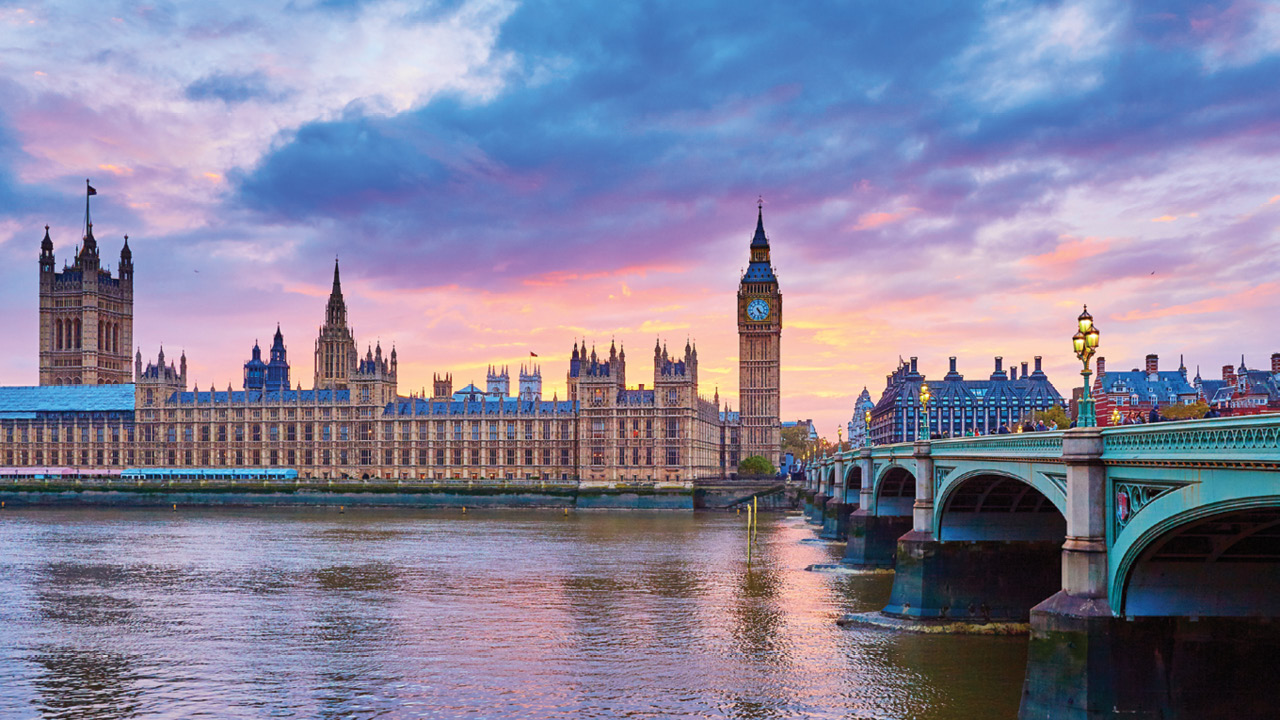
A world in a city is a common way to describe the metropolis of London, the capital of England. A cultural melting pot of over 230 nationalities, London is the financial, political and cultural capital of the UK. It is booming with activity and bursting with sightseeing treasures. You’ll find historic highlights from the haunting Tower of London to the ornate Buckingham Palace and more modern attractions such as the world-famous Harrods department store and the towering London Eye.
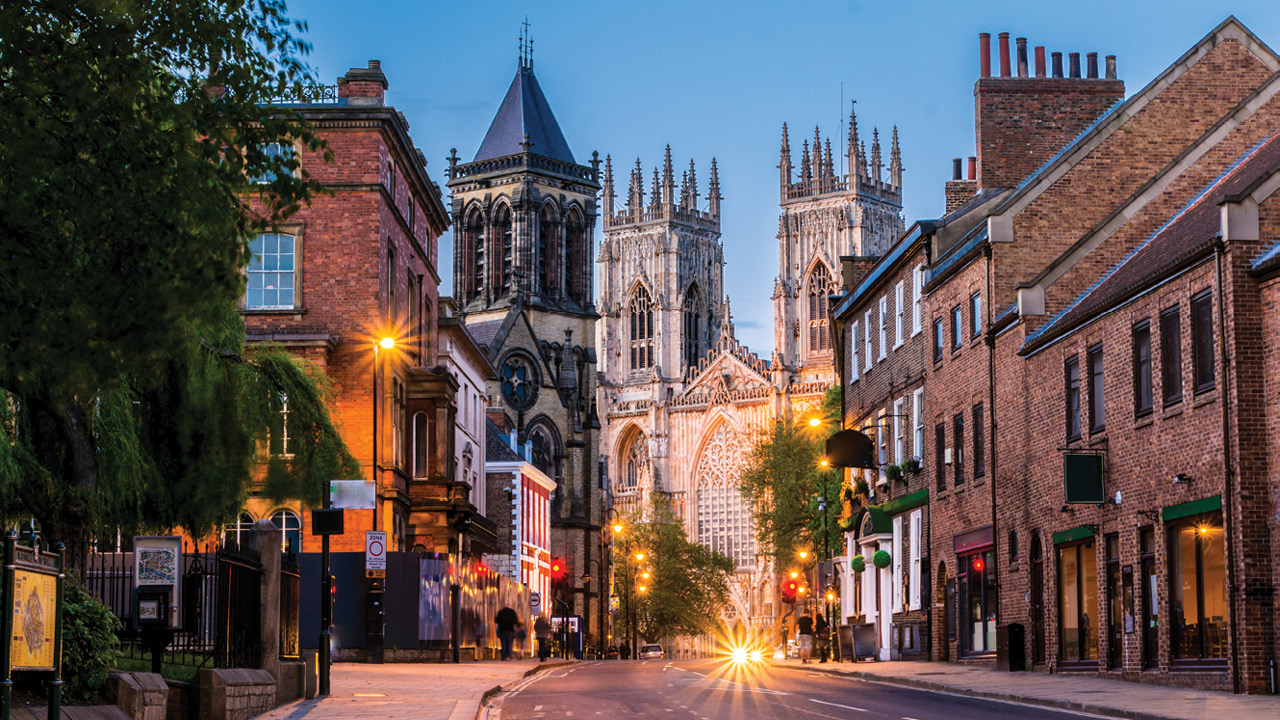
The historic walled city of York in North Yorkshire is located in the northern part of England. Today York is still encircled by its ancient medieval walls. York was founded by the Romans in A.D. 71 and is considered to be one of the great cities of the medieval world.
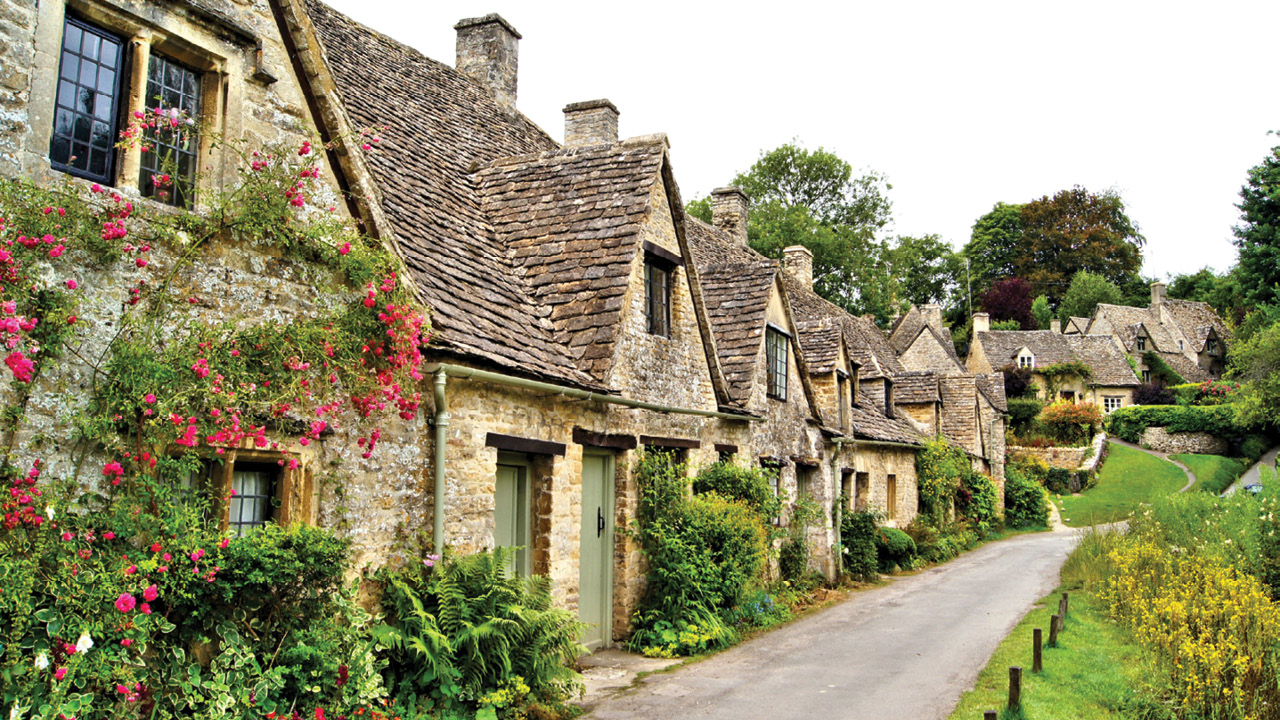
Gaze upon the charming thatched-roof homes that line quaint streets of this south central area of England. The Cotswolds are roughly 25 miles across and 90 miles long, stretching from Stratford-upon-Avon to Bath. The Cotswolds run mainly though the counties of Gloucestershire and Oxfordshire. The region is known for its small towns and villages, made from golden colored Costwold stone as well as lush greenery and rolling hills.

Buckingham Palace (Changing the Guard):
Queen Elizabeth's residence in London, Buckingham Palace is the ornate icing on the cake of England's capital city. Serving Britain's sovereigns since 1837, Buckingham Palace is the end point for parades and special events in the city as well as the daily Changing the Guard. Hundreds gather daily to watch the official changing of the Queen's Guards in the area outside of the palace gates and to get a glimpse of the palace itself.
Destination Must-Do's

Cardiff is the capital and the largest city in the country of Wales. Surprisingly it has only been the capital city of Wales since 1955. Two hours from London by train, Wales is the base for many national cultural and sporting institutions and is home to many of Wales’ sporting venues and sports teams. Travelers can explore its connection to the Iron Age, ancient Rome and the Norman Conquest. They’ll also fall in love with the famous Victorian shopping arcades.

Stonehenge:
Walk in the footsteps of so many before you when visiting prehistoric Stonehenge. This mysterious rock formation dates back to the Stone Age and remains one of the world’s most famous sites. Standing in the middle of the most dense complex of Neolithic and Bronze Age monuments in England, Stonehenge is perhaps the most important prehistoric monument in England. And now, updates at the site will make it more accessible than ever! New galleries and visitor facilities will enhance the overall experience and understanding of Stonehenge for visitors of all ages and interests. Construction has started on three Neolithic houses which will be the focal point of the outdoor gallery at the new visitor center. These houses offer visitors a glimpse into the lifestyle of the people who built Stonehenge. The experience of seeing this timeless monument is not to be missed.

Standing at 315' tall, Big Ben is located in London near the Halls of Parliament and Westminster Abbey. An iconic image of London, Big Ben's clock dials are some of the largest in the world at 23' high. The current structure was built in 1858 after the previous clock tower was destroyed in a fire in the 1830s.
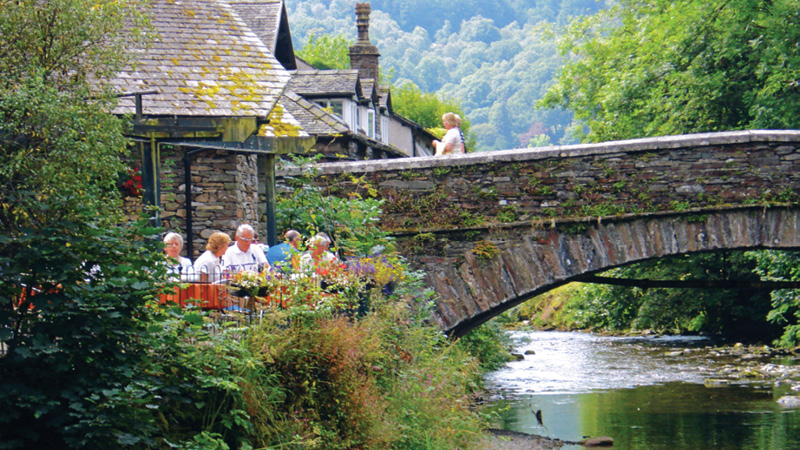
Lake District:
The Lake District is a mountainous region in northwest England. This region is famous for its lakes, mountains and forests. In this region hiking the mountain trails and boating on the lakes is a popular activity.
Expert Advice

Pubs are extremely common in England, and are a major part of English culture and way of life. Savor the traditional “pie and a pint” at local pubs, where the “pie” here is of the hot and hearty steak variety!

Pack your rain gear! It tends to rain in England and Wales almost every day.

Learn the lingo…yes, they speak English but many words are different such as sweater and elevator which turn into jumper and lift.
Featured Tours to England and Wales
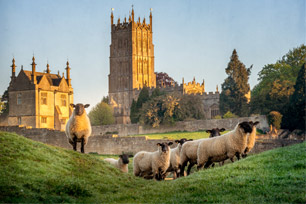
Shades of The English Countryside
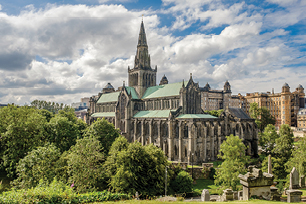
Scotland: Land of Lore & Legend

Scotland: Land of Lore & Legend featuring the Royal Edinburgh Military Tattoo

British Landscapes featuring England, Scotland and Wales

British Landscapes featuring the Royal Edinburgh Military Tattoo

Discover Scotland

Discover Scotland featuring the Royal Edinburgh Military Tattoo
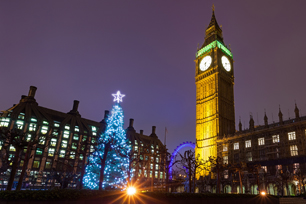
Christmas in London

Brochures that Feature Our England and Wales Tours
Find a travel agency.
Once you've found the perfect Collette tour, your local travel agent can assist you in making reservations. To find a preferred travel agent in your area, please enter your 5-digit zip code, then click Search.
Enter a Whole or Partial Zip Code
Please tell us everything, we want it all.
We really value your feedback, please be open an honest. Tell us where we can improve, how we can get better. This feedback is anonymous, but if you would like us to get in touch with you regarding an issue provide your email address as part of your feedback and we will get right back to you.
Talk to an Expert
Please fill out the form below, and a Collette Expert will contact you shortly.
- Yes, I'm a Travel Professional
- Yes, I am working with a Travel Professional
- I am traveling with 8 or more travelers
View or Download

Roman Tours is proud to present, Chester Medieval Tours.

Travel in Medieval England

When we think of how people travelled in medieval England, images of nobles in coaches, knights on horseback or perhaps pilgrims on the road to Canterbury might spring to mind. We might also assume that, for most ordinary people, travel over any significant distance was largely out of the question. We might even take it for granted that most people never travelled far from their place of birth.
But how true is this? What was it really like to travel in medieval England? Why did people travel anyway? And how did they get to where they needed to be?
Royal and Noble Travellers
Throughout the Middle Ages, the royal court was itinerant to a greater or lesser extent. The court became more centred on Westminster later in the medieval period. However, even then, the king and his court would often travel across the country to visit important dignitaries, spending significant amounts of time away from the capital.
Since the court was the centre of power, anyone who wanted to petition the king would need to travel to court at some point. This included not only the senior members of the nobility but wealthy merchants, important members of the clergy and members of the gentry.
Parliaments could be called for anywhere in the country. When such a parliament was convened the king, the lords as well as the leading knights, merchants and gentry would all need to attend. Most of these people would travel with a significant entourage.
Naturally enough, large numbers of wealthy people gathered in one place represented a significant opportunity for merchants, minstrels, and other would-be hangers-on, looking for patronage. So anywhere hosting a parliament might expect to receive a significant influx of visitors.
Poor Travellers
Even poorer folk might travel to the court in search of work (whether temporary or permanent).
Indeed, there were a variety of reasons why poorer folk might want to travel. The lowlier itinerant minstrels and players would travel from town to town plying their trade. Generally, they would follow an itinerary, aiming to arrive at a particular town or city to take advantage of a particular festival or local fair. Sometimes they would even attempt to waylay the royal court on the highways and byways in the hopes of impressing the king and earning some coin.
Whilst a great many common folk were tied to the land on which they worked, this was not the case for everyone. Itinerant labourers might travel great distances if they were unable to find work locally. Those seeking to work as apprentices for craftsmen such as carpenters or brewers might need to travel from their villages into the nearest town for work. Once employed by a carpenter, brewer, or other tradesman you might well be required to travel for your work. You might need to attend a market to buy supplies or carry a message from your employer to a customer. Much of that travel would of course be local, but occasionally you might need to travel much further.
Even a poor farmer would need to travel from their village to the local town market for supplies. For some, this could be quite a journey. It could take an entire day to walk into town, buy what you needed, and walk back home. It would be unusual indeed for someone to never leave their village throughout their lives.
Religious Travellers
A significant number of people, including even the poorest, would occasionally travel on a pilgrimage. Often this might be a local affair, travelling to the shrine of a saint in a nearby city or Abbey. At other times it might be something a good deal more significant. Some people would a spend few weeks travelling across the country to make a pilgrimage to Canterbury.
A small number of poor people even made pilgrimages overseas. This they were only able to do by relying on the charity of others to provide food and places to stay. However, in an age when the medieval Church was so dominant, there were many people willing to offer aid to pilgrims following God’s calling. But, of course, there were also many people keen to exploit the faithful.
In addition to pilgrims, itinerant friars would wander between villages and towns preaching. Richer members of the clergy such as bishops might have cause to travel more regularly as they ministered to the various parishes scattered across their patch.
The richest abbotts and archbishops mixed with the ruling elite. They would travel to court on occasion and some had a permanent seat in parliament. Since parliaments could be called anywhere in the country, they, along with their entourage, would need to travel to wherever the parliament was being held.
The English medieval road network was, generally speaking, terrible.
Whilst medieval England had inherited an extensive system of paved roads from the Romans, these fell into increasing disrepair over time. As these roads became increasingly uneven and poorly maintained, they became ever more difficult to use. Locals would sometimes steal stone from the old road to re-use in local construction. Sometimes they became so uneven and poorly maintained that new dirt roads formed, running alongside the old Roman thoroughfare.
In fact, most roads and tracks used were unpaved. By the High Middle Ages, even some major roads were unpaved. Typically, English roads were just packed dirt. This was especially the case for the network of tracks and trails that linked together the many rural communities across the English landscape.
The condition of such roads might not be too bad in fine weather. However, after a prolonged wet period they often became very muddy to the point where some might be virtually impassable. Many might thread their way through wooded areas and, in this case, fallen trees impeded or even blocked progress on a regular basis.
Medieval society was violent. This was especially true during times of war and rebellion. During the Anarchy and the periods of the Barons’ Wars, travel across England would have been extremely dangerous. However, even during more peaceful times, bandits and outlaws were common hazards for travellers.
Only a fool would travel any distance unarmed and alone. Richer folk could obviously afford an armed guard. For them travel was generally reasonably safe for this reason. But humbler travellers would need to look to their own security by travelling together in numbers and carrying a weapon for self-defence.
It was quite common from travellers to carry swords. Despite this, at certain times and in certain parts of the country, travel was still very dangerous. Sometimes the only way to avoid an armed fight was not to travel at all.
Walking was the usual mode of transport for most people. If you could not afford to buy a horse, you had to walk.
As a result, most villagers travelling into town for a market would walk there and back. Of course, walking anywhere could be a long, slow journey. Even a visit to the nearest town could take an entire day. What is more, you could only really travel in daylight, unless there was plenty of moonlight. Certainly, there were no streetlights. On a moonless night, the entire countryside would be in pitch darkness.
Walking at least had the merit of being a flexible form of transport. If the road was blocked by a tree, you could climb over, it or walk around it. If the road was too muddy, you could walk through the woods beside it.
However, walking was, of course, slow. If you had to travel any distance by foot (and many people did) you could easily spend several days on the road.
However, if you walked, unless you were on a pilgrimage, it was a surefire sign that you were poor. Many inns would not allow you to stay unless you had a horse with you (for fear that you might not be able to pay for your lodgings).
Carts and Wagons
In the Middle Ages, carts and wagons were strictly for transporting cargo, not people. These were certainly not passenger vehicles.
You did not travel by cart unless you needed to carry a heavy load. For one thing carts and wagons were very slow; it was certainly faster to walk. For another, they easily became stuck or delayed by muddy tracks or fallen trees.
Aside from the labourers who drove the carts, no one else would ride in one. If you did so it would have been considered a bit weird. People would probably assume you must be too sick to walk or ride a horse.
Of course, as far as cargo transport was concerned, these vehicles were essential. They were often the only practical way to transport goods around the country in any quantity.
We have all probably seen a Robin Hood film in which Robin and his Merry Men waylay a wealthy couple travelling in a carriage through Nottingham Forest. However, such a scene would never have happened in medieval times.
The passenger carriage was eye wateringly expensive to buy and to run. These vehicles would often be richly painted and decorated with gold leaf. More British people own a high-end luxury yacht moored in the Mediterranean today than owned such a carriage in the Middle Ages.
The only people who travelled by passenger carriage were queens and duchesses. No one else could afford one. Such powerful noblewomen would travel with a very large entourage, including a significant armed guard. To witness such a magnificent convoy would have been a true spectacle indeed! If you ever saw a carriage, you’d be in luck, for there were probably fewer than half a dozen such vehicles in the country at any point in time.
Kings and Dukes could afford carriages of course (and probably owned one for the use of their wife). However, they would not use such vehicles themselves. Carriages were strictly for elite women. Kings and noblemen were expected to ride on horseback. For a man to be seen in a carriage was a shameful thing, people would think you were an invalid!
Of course, the way to travel for anyone who was anyone was by horse.
The best way to travel across country in England during the Middle Ages was certainly by horse (assuming you can afford one). It was the fastest mode of transport and those who travelled in this way were assumed to be a cut above the common traveller.
A high-quality warhorse would be very expensive, but a basic riding horse could be acquired for £4 or £5. This is still beyond the means of many. Even a skilled tradesman, like a carpenter, would struggle to earn this much in a year. However, any nobleman, knight or member of the gentry would not be seen dead travelling cross country by any other means.
Wealthier women would also travel by horseback. As with their menfolk, this was the normal mode of transport for most women of means. Even queens and duchesses would probably ride more often than take to a carriage, especially when hunting. However, contrary to what we might think, we wouldn’t see any women riding side-saddle for most of the Middle Ages. Women rode astride the horse just like their men, albeit they needed to wear a riding skirt for the sake of modesty. Riding side-saddle was unknown in England before the end of the fourteenth century. It was effectively a fashion, first introduced from the continent by Queen Anne of Bohemia, the wife of Richard II.
River transport
Given the slow speed and unreliability of transport by cart or wagon, river boats were often the preferred way to move cargo around the country. They could carry larger loads than wagons, were generally faster, and less likely to be delayed by mishaps.
Of course, not everywhere could be accessed by river by any means, so there were obvious limitations. Nevertheless, where river transport was an option, it would always be used in preference to the unreliable road network.
Sea Transport
Ships could carry large cargos and significant numbers of passengers along the English coast faster than any other mode of transport. However, it was not always reliable. Bad weather at sea could prevent ships from sailing, sometimes confining them to port for days on end.
Sea travel was not without its dangers. If you were caught at sea in a storm, you could be blown off course or your vessel might be damaged, delaying your journey. In a worst-case scenario, you might even be wrecked and drowned!
Despite the dangers, England traded extensively by sea throughout the Middle Ages. Wool export was a major industry for medieval England. Such cargos would regularly travel across the English Channel to France, the low countries and the Hanseatic ports along the north German coast.
For most of the Middle Ages, Gascony in southern France remained part of the Plantagenet realm. Trade with its major port at Bordeaux was brisk. English ships would regularly set sail from Bristol or Weymouth bound for southern France. Wine, salt, and armour were the principal goods imported.
International Trade
Sea trade with Bordeaux linked medieval England to the Mediterranean. Ships from Spain, Italy, and North Africa would bring their cargos to Bordeaux. From there, they could be transported back to England. In this way spices and more exotic goods could find their way back to England.
Of course, such cosmopolitan connections had many advantages. Trade with Europe was the lifeblood of the English economy throughout the Middle Ages. However, it also linked England with an international transport network that carried more than just cargo and people.
Just before 24 th June 1348, a sick Gascon sailor was brought ashore at Weymouth seeking treatment. He was gravely ill and died shortly thereafter. He had died of a new pestilence that would soon sweep across the country like the angel of death. It was a pestilence that would be remembered in history as the Black Death.
Keep up to date with our stories…
If you like reading our work and would like to keep up to date with the latest stories and news from our blog page, you can follow us on Facebook. We always announce any news and promote new stories as they are published here:
https://www.facebook.com/MedievalHistorian
If you are interested in life in medieval England, you might be interested in some of my other articles…
Medieval London
Parliament and the Birth of Democracy
The Black Death
References and further reading
The Time Traveller’s Guide to Medieval England: A Handbook for Visitors to the Fourteenth Century. Ian Mortimer.
The Wine Trade with Gascony. Frank Sargent
What did medieval roads look like? Nina Dengg
Canterbury Tales frontispiece by Walter Appleton Clark, 1914 (via Wiki commons)
Stained glass window at Canterbury Cathedral, showing scenes from the Miracles attributed to St Thomas Becket. Photo by Jules & Jenny via (Wiki Commons).
Birkenhainer Straße near Ruppertshütten, Lohr, Bavaria, Germany, Photo by Drow69 (via Wiki Commons)
Pilgrims leaving Canterbury, taken from Lydgate’s Siege of Thebes, Royal 18 D II f.148, 1455-1462. Artist Unknown (via Wiki Commons)
Sailing ship (cog) Kieler Hansekogge at the Kiel Week 2007. Replica of the Bremer Kogge from 1380 found near Bremen in 1962. Completion of the replica: 1991. (via Wiki Commons)
1 thought on “Travel in Medieval England”
I think traveling was very costly during the middle ages. Even in in the mid 19th century before the railroads became common, it was much expensive to travel by wagon than by train, and a distance that would take a whole day could had been traveled in only 2 hours. In our days we have a huge opportunity to travel very cheap. Turning back to middle ages, I wonder if in the islamic world travel would have been much safer than in England at that time.
Leave a Reply Cancel reply
Your email address will not be published. Required fields are marked *
Save my name, email, and website in this browser for the next time I comment.

Tudor Tours
'This tour was so much fun and I definitely would consider doing something like this again. I learnt so much!'
'Steve was great at personalising the tour and enthusiastic. All the places were very interesting, each in their own way.'
'The entire agenda was planned out well with careful research and attention to detail. This tour fully realised my objectives for this trip.'
'Steve was constantly striving to give us the best experience possible. Very personable and knowledgeable.'
'I feel like I have a lifelong tour guide when coming to London. The entire experience was exceptional.'
'I just wanted to say what a fabulous trip we had! Truly the best trip I have ever taken. I would go with Tudor History Tours in a heartbeat.'
'Atmosphere was everywhere and if you are at all interested in history, this tour is a must. You will never find another quite like it.'
'I think the whole thing is JUST GREAT! You've included most of the "must see" places for England.'
'Just excellent. Can’t wait to come back and do another visit. I travel a lot and it’s such a better experience with a knowledgeable guide.'
'Steve is wonderful! Kind, thoughtful, patient, really nice to be with, so knowledgeable. A pleasure.'
'Overall we were extremely pleased with the preparation, attentiveness of Steve before and during our time in England.'
'What a memorable, magical tour through Tudor England. It exceeded all expectations - and I have pretty high expectations!'
'We could not have asked for a better host. Steve was knowledgeable adding perspective and amazing insight.'
'The group had diverse interests and our guide was able to meet the needs of everyone.'
The Plantagenet Dynasty and the Wars of the Roses, perhaps the most brutal and bloody 30 year period in English history followed by Tudor Age are the most talked about, written about and filmed period in over 2,000 years of British History.
You can now experience the great loves and lives of Edward IV & Elizabeth Woodville, Henry VI & Margaret of Anjou, Richard III & Anne Neville, Henry VII & Elizabeth of York. Henry VIII, married 6 times Catherine of Aragon, Anne Boleyn, Jane Seymour to find a healthy male heir. Other historical figures too can be found on our unique Tudor History tours. On our small group tours we go beyond the typical tourist trail to give you a real insight into the personalities and places of Medieval and Tudor England and the dynasty that saw two of the greatest love affairs of the age.
Request your copy now >
Henry VIII: Defender of the Faith
Over 500 years ago in 1521 Henry VIII was declared Defender of the Faith (Fidei Defensor) by Pope Leo 10th. This 8 nights, 9 day fully escorted tour finds the real Henry through a Grand Progress of Southern England.
- Full 9-day itinerary
- 8 nights B&B breakfast accommodation
- Historic hotels and Inns
- 17 Historic sites
- Shakespeare's globe
- Fully guided
Six Wives of One King
We take you on an evocative journey to explore the lives of of Henry’s six wives. How did these different women live and how did they become consorts to Henry VII? We visit their childhood homes, divorce settlements and take you on a pilgrimage to their final resting places. This fully guided tour gives you unique insights into their lives.
- Comprehensive 11-day itinerary
- 10 nights B&B breakfast accommodation
- 23 Historic sites
Tudor Women - Fully Booked
Our Tudor Women tour embraces the lives of wives, sisters and courtiers in the turbulent Tudor century. Some of the women we meet on our tour were powerful in their own right. Others held power more discretely. A few were victims of the politics of the age. All have their own stories to tell.
- Packed 8-day itinerary
- 7 nights B&B breakfast accommodation
- 14 Historic sites
- Shakespeare's Globe
Wars of the Roses
We take you on unique tour of The Cousin’s War, more famously known as the Wars of the Roses. Perhaps the most brutal and bloody 30 year period in English History, we delve into the period to find the women behind the Kings. Were they the real heroes, the power brokers and the villains?
- Historic 11-day itinerary
- Hotels with charm and character
- 24 Historic sites
Personalised History Tours
We can cater for small family groups or individuals and provide a unique Royal Progress Tour to suit any requirements, or design an independent itinerary. Our speciality is the Tudor period but we can organise any tour or even days out of London that will satisfy everyone in the family. We've mixed Henry VIII and Jane Austen, Roman Britain and Harry Potter. With Tudor History Tours you can sit back and enjoy and let us plan the details.
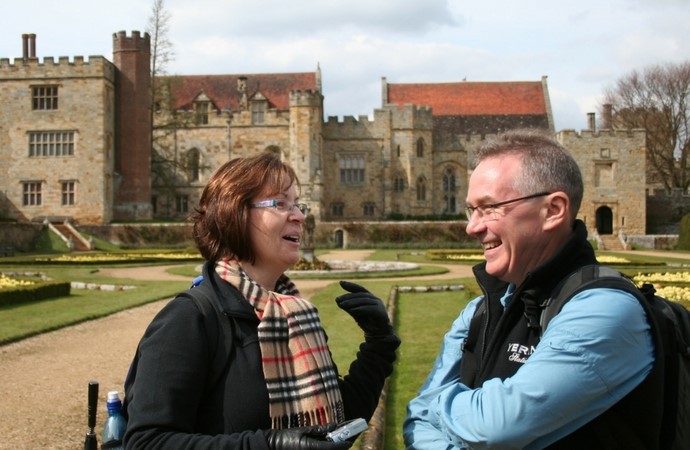
Testimonials
Latest news.
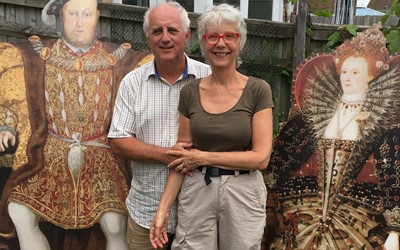
We give reflections on a busy summer as we look forward to 2024 and welcoming new and returning guests with a new Sovereign on the throne.

Go Medieval with These New Bespoke Historical Tours of England
By Zac Thompson
03/15/2023, 1:00 PM
A new tour operator based in the scenic and once hotly contested England-Wales border region aims to connect travelers to the castles, battles, and chain mail–centric fashions of the Middle Ages.
Known as Timequest , the company, which launched earlier this year, offers customized guided tours for small groups of no more than eight participants, who collaborate with the tour operator to come up with an itinerary especially suited to the guests' specific medieval interests.
You certainly have plenty of options in the corner of southwestern England where Timequest is headquartered.
"There are almost 50 castles within a one-hour drive of our base" in Herefordshire , Timequest's Richard P. Jeynes told Frommer's in an email. The archaeologist and educator says you can see biggies like Goodrich Castle (pictured at the top of this post) as well as smaller sites that are "in our view far more interesting and well off the normal tourist trail."
In addition to all those strongholds erected by Norman lords, there are enough nearby battlefields to fill several Shakespearean history plays, including Tewkesbury and Bosworth Field, both of Wars of the Roses fame.
Tours can make time for the cathedrals of Worcester and Gloucester, timber-framed market towns, kings' tombs, and saints' relics, too.
Aside from its bespoke itineraries, Timequest differentiates itself from the competition, according to Jeynes, by employing "guides and guest speakers [who] are highly qualified leaders in their fields"—erudite and engaging experts in archaeology, the Crusades, military history, and other pertinent topics. "They are not simply reciting a well rehearsed script," says Jeynes.
What's more, the company gives tourgoers the chance to get some firsthand medieval combat training with longbow archery lessons, tabletop war games involving detailed models of famous battles, and, at certain times of year, visits to battle reenactments at medieval festivals.
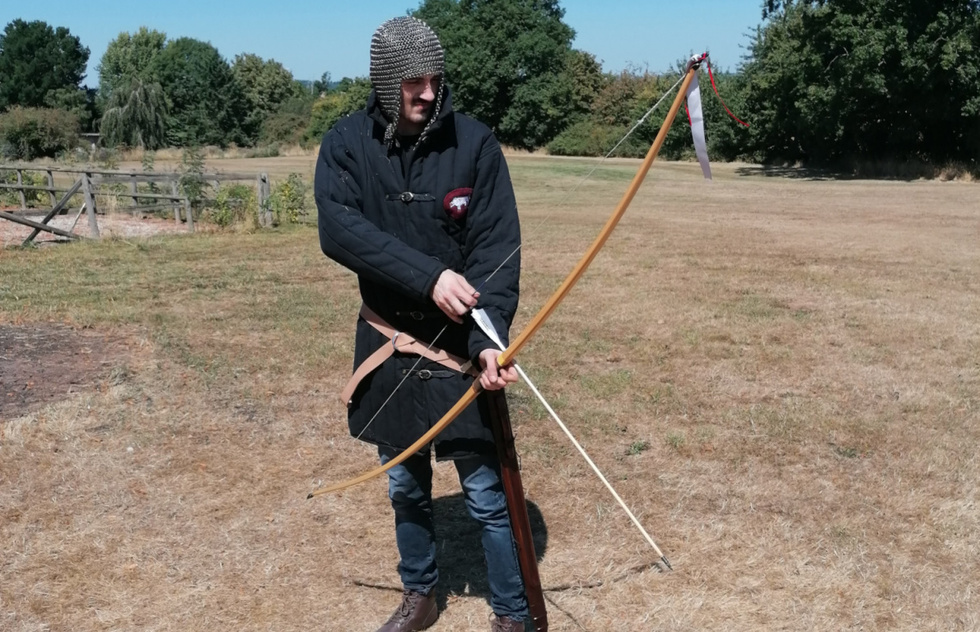
Since tours are tailored to individual groups, prices vary widely, starting at £85 ($103) per person for a half-day archery experience or around £100–£150 ($122–$182) per person for a full day of castle- and battlefield-going.
Multiday tours feature accommodations at the Verzon House Hotel in Ledbury, at a discounted nightly rate of £120 ($146), on top of the cost of tours and activities.
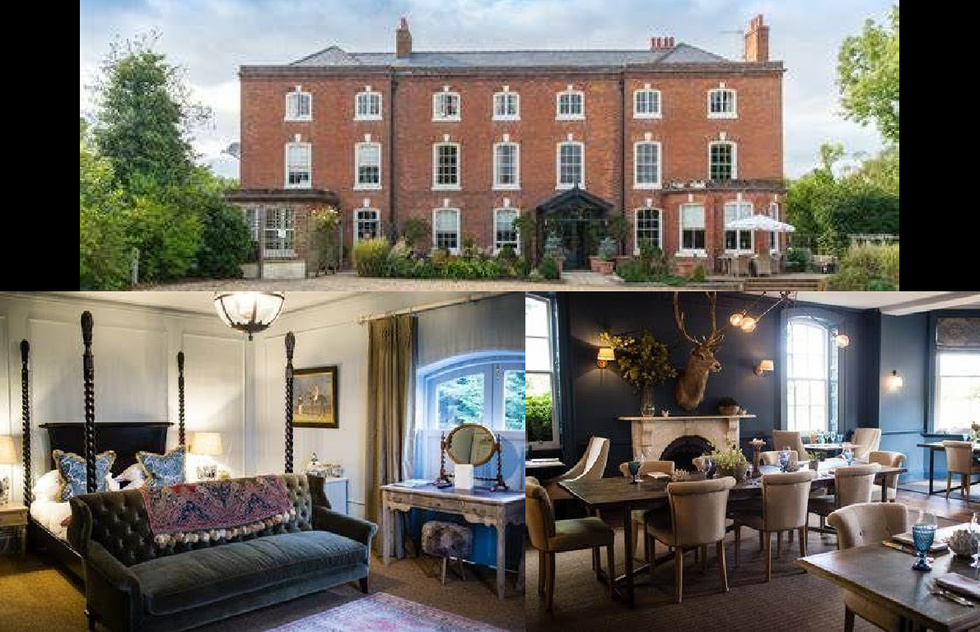
Rail links will get you to nearby Gloucester from London in about 2 hours or from Birmingham in about an hour. From the Gloucester train station, Timequest reps can pick you up. Or you can always try securing a ride by frantically offering your kingdom for a horse à la Richard III at Bosworth Field.
For more information, including details on how to book, go to TimequestMedievalExperiences.com .

- All Regions
- Australia & South Pacific
- Caribbean & Atlantic
- Central & South America
- Middle East & Africa
- North America
- Washington, D.C.
- San Francisco
- New York City
- Los Angeles
- Arts & Culture
- Beach & Water Sports
- Local Experiences
- Food & Drink
- Outdoor & Adventure
- National Parks
- Winter Sports
- Travelers with Disabilities
- Family & Kids
- All Slideshows
- Hotel Deals
- Car Rentals
- Flight Alerts
- Credit Cards & Loyalty Points
- Cruise News
- Entry Requirements & Customs
- Car, Bus, Rail News
- Money & Fees
- Health, Insurance, Security
- Packing & Luggage
- -Arthur Frommer Online
- -Passportable
- Road Trip Guides
- Alaska Made Easy
- Great Vacation Ideas in the U.S.A.
- Best of the Caribbean
- Best of Mexico
- Cruise Inspiration
- Best Places to Go 2024

IMAGES
VIDEO
COMMENTS
A small group tour of England focused on Medieval England and Wales. Spend 21 days on this escorted tour with tour director and local guides travelling from Canterbury to Cambridge, passing through Winchester, Salisbury, Bristol, Hereford and Norwich along the way. Castles, villages, Cathedrals and churches all feature in the Medieval ...
Medieval Castles. We offer three Castles and Cathedrals tours, East, Cotswolds and South. The East tour heads from London to Kent where we visit the castles at Leeds 'the loveliest castle in the world', Hever (13th c. and home of Anne Boleyn) and Dover (11th c. origin and perhaps the most important castle in England's history.
Today we will enjoy tours of several of the university buildings. Christchurch Cathedral is the smallest cathedral in England and the seat of the Bishop of Oxford. This medieval structure contains the Shrine of St. Frideswide, Oxford's patron saint. Frideswide hid in a tree to escape from the pursuit of a king and a worldly life.
Our pick of the best English castle tours. From working royal residences at Windsor Castle to moated castles at Leeds Castle and medieval fortresses at Warwick Castle see the best of England's heritage! Many of these tours operate daily from London, whilst some are only available on selected dates. We also offer private English castle tours ...
Windsor Castle, Stonehenge and Bath Tour from London + Admission. 2,914. Uncover centuries of British history on a full-day guided coach tour of three unique historic landmarks, including two of England's most visited UNESCO World Heritage sites.
Amberley Castle - Welcome to Royal Rural England. Amberley Castle is hidden away, 900 years of history surrounded by landscaped gardens and unrivaled tranquility. Enter into its medieval walls and there's an immediate sense of decadence. Welcome to a world of elaborate four-poster beds, opulent gardens, 60-ft high ceilings, and the untamed ...
England's best preserved medieval village. Lavenham, often dubbed as 'England's best-preserved medieval village,' is a historical treasure nestled in Suffolk's countryside. Once thriving from the wool trade, this village showcases timber-framed buildings, as well as the Guildhall and the St Peter and St Paul Church.
This article aims to immerse the reader in the landscapes - town, city, and countryside - of medieval England, with a focus on the 14th century (1300-1400). To do this, we have drawn on Ian Mortimer's book, The Time Traveller's Guide to Medieval England. Mortimer begins his immersive history by vividly setting a typical scene: Imagine ...
Discover and book Medieval England Private Day Tour from London on Tripadvisor. Help. If you have questions about this tour or need help making your booking, we'd be happy to help. Just call the number below and reference the product code: 118398P5. +1 855 275 5071.
Welcome to Timequest. Specialist guided tours and medieval experiences in the heart of the highly contested English / Welsh border region. Presentations for schools are very popular. Half or whole day medieval experiences include interactive talks on a range of topics and include artefact handling, stories, activities for participation and ...
From Queen to King 19th September 2023. We give reflections on a busy summer as we look forward to 2024 and welcoming new and returning guests with a new Sovereign on the throne. Read more >. Tudor History Tours is a family owned and independent company. Join us on our small group, multi-site tours to go beyond the typical tourist trail!
Tour Glamis Castle, the legendary setting of Shakespeare's "Macbeth" and childhood home of the King's grandmother. Cross the modern Tay Bridge to the medieval town of St Andrews, the "Home of Golf." Take a panoramic tour of this scenic university town by the sea. Have lunch with your group and enjoy some time to explore.
The tour ranges across England - north, south, east and west - to see some of the most glorious medieval architecture to be found anywhere. Connoisseurs may carp at the omissions, but logistics exclude only a couple of cathedrals of comparable beauty, magnificence and interest. With an average of little over one cathedral a day, there is ...
We specialize in small-group experiences that bridge the gap between the past and present. We create custom history tours that explore William Marshal's life and times in Medieval England, Ireland, Wales & the Holy Land.Along the way we'll delve into the stories that make history come alive, explore medieval castles and abbeys, and connect with local customs and traditions.
All of our forthcoming Scheduled Medieval Tours are listed below. The Last Welsh Rebellion Starts 15th September 2024 (9 days) Expert Historian - Dr John Sadler. A fabulous tour through the dramatic scenery of Wales that explores the magnificent castles of Edward I and follows the exploits of Owain Glyndŵr, the last true-born Prince of Wales ...
10. High Bridge. High Bridge in Lincoln, England, is a medieval bridge that carries the High Street across the River Witham. It is the oldest bridge in the United Kingdom still to have buildings on it, and having stood since the 12th century, today is a Grade I listed building and scheduled monument.
Today York is still encircled by its ancient medieval walls. York was founded by the Romans in A.D. 71 and is considered to be one of the great cities of the medieval world. ... Featured Tours to England and Wales. View All England and Wales Tours Shades of The English Countryside. From $3,599 pp. Scotland: Land of Lore & Legend . Tour Rating:
Roman Tours is proud to present, Chester Medieval Tours. This exciting and unique tour will focus on medieval Chester in the year of 1403. England is under the rule of King Henry IV but the rebellion of Henry 'Hotspur' Percy, along with his allies Owain Glyndwr and the Earl of Douglas, threatens his reign. Our authentically dressed medieval ...
Medieval society was violent. This was especially true during times of war and rebellion. During the Anarchy and the periods of the Barons' Wars, travel across England would have been extremely dangerous. However, even during more peaceful times, bandits and outlaws were common hazards for travellers.
Henry VIII: Defender of the Faith. Over 500 years ago in 1521 Henry VIII was declared Defender of the Faith (Fidei Defensor) by Pope Leo 10th. This 8 nights, 9 day fully escorted tour finds the real Henry through a Grand Progress of Southern England. Full 9-day itinerary. 8 nights B&B breakfast accommodation.
Go Medieval with These New Bespoke Historical Tours of England. By Zac Thompson. 03/15/2023, 1:00 PM. A new tour operator based in the scenic and once hotly contested England-Wales border region aims to connect travelers to the castles, battles, and chain mail-centric fashions of the Middle Ages. Known as Timequest, the company, which ...
Experience the mystery and magic of Europe's castles with our Castles & Knights tours. We'll take you on a fairytale journey to some of the best castles in Europe, where you'll discover ancient history, medieval traditions and spectacular architecture. Stay in real-life castles in Wales and grand châteaux in France, and see some of the ...
Pentiment. Pentiment is a side-scrolling 2D murder mystery game set in the 1500's. Players assume the role of two different protagonists, Andreas and Magdalene, who seek to uncover a series of ...